- Analytics
- News and Tools
- Market News
CFD Markets News and Forecasts — 26-01-2022
- USD/CAD pares Fed-led gains around weekly high, down for the second day in a week.
- Fed, BOC matched market forecasts whereas Powell, Macklem sound cautiously optimistic.
- WTI crude oil prices stay firmer around the highest levels since October 2014.
- US Q4 GDP, Durable Goods Orders will be crucial for near-term direction.
USD/CAD consolidates the previous day’s gains around 1.2660, down 0.11% intraday amid Thursday’s Asian session.
The Loonie pair failed to praise the Bank of Canada’s (BOC) hawkish verdict on Wednesday as the US Federal Reserve (Fed) matched the market’s upbeat expectations. However, strong prices of Canada’s main export item WTI crude oil allow the quote to retreat from a multi-day high.
That said, the US Federal Reserve (Fed) kept benchmark interest rates and tapering targets intact during Wednesday’s Federal Open Market Committee (FOMC) meeting. However, the interesting part from the Monetary Policy Statement was, “The Committee expects it will soon be appropriate to raise the target range for the federal funds rate.”
Fed Chairman Jerome Powell also spoke in sync with the hawkish signals from the US central bank while saying, “There’s plenty of room to raise rates.” Though, his comments like, “The rate-hike path would depend on incoming data and noted that it is ‘impossible’ to predict,” seemed to have underpinned the USD/CAD pair’s latest pullback.
Read: Fed Quick Analysis: Three dovish moves boost stocks, why more could come, why the dollar could rise
Before that, the BOC held benchmark interest rate unchanged at 0.25% while saying, per Reuters, "The BoC repeated that it sees slack being absorbed sometime in the middle quarters of 2022." Following the monetary policy verdict, BOC Chairman Tiff Macklem said, “Interest rates will have to go up to counter inflation.”
Read: Breaking: Bank of Canada leaves policy settings unchanged in December as expected
It’s worth noting that the fears of supply outage due to the geopolitical risks emanating from Russia rejected the dovish EIA Crude Oil Stocks Change to keep WTI oil prices near the highest levels marked since October 2014, up 0.70% around $86.70 at the latest.
Amid these plays, equities and commodities remain on the back foot, except for oil, whereas the US 10-year Treasury yields rose the most in three weeks, up eight basis points (bps) to 1.87% by the end of Wednesday’s North American session.
Moving on, risk catalysts like Ukraine-Russia tussles and Sino-American tensions may play a notable role to direct short-term USD/CAD moves but major attention will be given to the first readings of the US Q4 GDP and Durable Goods Orders for December.
Read: US GDP Preview: Inflation component could steal the show, boost dollar, already buoyed by Russia
Technical analysis
USD/CAD keeps the five-week-old resistance breakout despite the recent pullback, which in turn keeps buyers hopeful to again challenge the 50-DMA level near 1.2710.
However, a downside break of the previous resistance around 1.2645 will need a clear break of the 100-DMA surrounding 1.2620 to convince USD/CAD bears.
- EUR/USD holds lower ground after Fed directed bears to five-week low.
- Bearish MACD signals, clear downside break of two-month-old ascending trend line and sustained trading below 20-DMA favor bears.
- Buyers remain cautious until refreshing the 2022 peak, 61.8% FE will challenge bears past 1.1185.
EUR/USD stays pressured around a multi-day low near 1.1240 after the Fed showdown.
That said, the major currency pair dropped the most in over a week while breaking a two-week-old ascending trend line post-Fed, staying below the support-turned-resistance line of 1.1295 by the press time of the initial Asian session on Thursday.
In addition to the downside break of the previously important support line, bearish MACD signals and downbeat RSI line, not oversold, also favor EUR/USD bears to aim for the year 2021 bottom surrounding 1.1185.
However, a horizontal area comprising multiple lows marked since November, near 1.1230, tests the immediate downside of the pair.
It should be noted that the quote’s weakness past 1.1185 will be challenged by the RSI line, which is declining towards the oversold territory. Also likely to test the EUR/USD sellers is the 61.8% Fibonacci Expansion (FE) of the pair’s moves from late September 2021 to the January 2022 swing high, near 1.1120.
Alternatively, a corrective pullback may initially aim for the previous support line, near 1.1295, before directing EUR/USD bulls towards the 20-DMA level of 1.1340.
If the pair buyers manage to cross the 1.1340 mark, a horizontal resistance from November 16, near 1.1385-90, will probe the quote’s upside towards the monthly high, also the yearly peak, of 1.1482.
EUR/USD: Daily chart
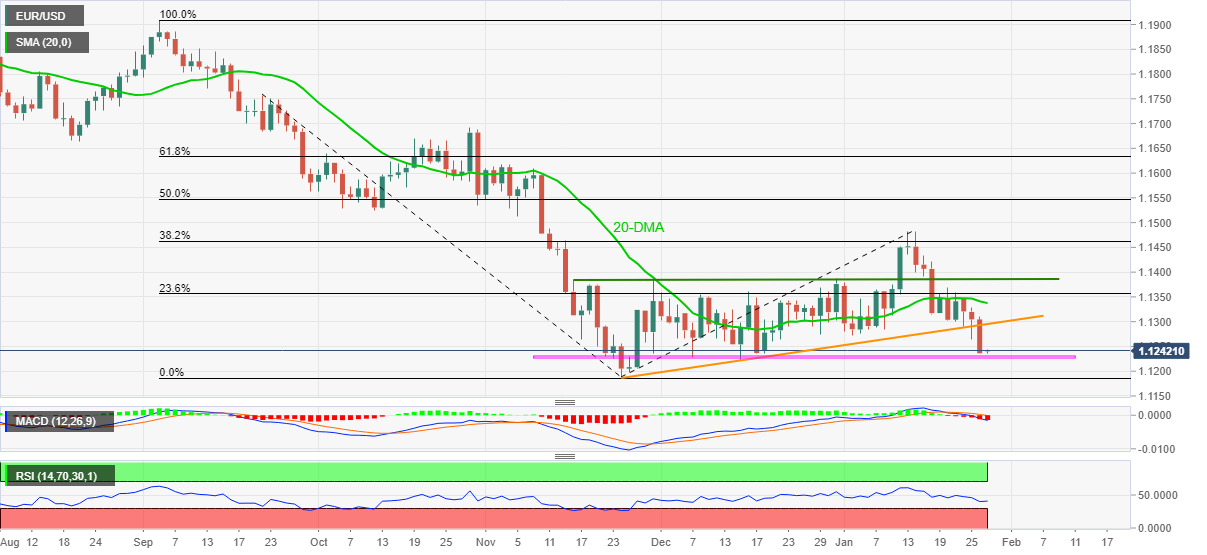
Trend: Further weakness expected
Economics at the Bank of America (BofA) reiterated their bullish calls on the US dollar after witnessing the hawkish play of the US Federal Reserve (Fed).
BofA initially said, "Overall, the January FOMC meeting reinforces our view that the Fed will likely need to hike more than the market is currently pricing. This should push rates higher across the US rates curve & in a bear flattening bias."
The analytical piece adds that the USD strongly and broadly appreciated on the back of today's hawkish FOMC decision, with gains skewed somewhat toward lower beta FX - EUR, JPY and CHF.
“US dollar gains accelerated from an initially modest level post-statement release throughout Chair Powell's press conference,” per the US bank.
While concluding the findings, the investment bank said, “We remain bullish USD vs. low beta FX and would look to buy dips on a trend basis into rate liftoff as the market further prices in a more aggressive Fed and hence additional monetary policy divergence.”
Read: Fed Quick Analysis: Three dovish moves boost stocks, why more could come, why the dollar could rise
d to wait till this November before it responds to higher inflation with its first interest rate rise in over a decade,” per the latest Reuters poll.
Key quotes
The poll showed inflation would meet the RBA's target range of 2-3% from next quarter and through 2023 averaging at 2.5% this year and 2.3% in 2023, while the economy is forecast to grow 4.0% this year and 2.9% in 2023.
Economists canvassed in a Reuters Jan 18-25 poll also brought forward their rate hike expectations for third month in a row. Most of the 34 respondents, however, expect the RBA to take more time, with a median forecast for a 15 basis-point move in November.
Two economists expect a rate rise already in the second quarter, seven in the third quarter, 11 in the fourth quarter and 13 still see the central bank first pulling the trigger next year.
Economists were less divided on when the central bank will pull the plug on its bond-buying program, with 17 out 22 of those who answered the question expecting an announcement at the next policy meeting on Feb. 1.
Five others saw the central bank ending the program launched in response to the coronavirus pandemic in May.
The last time the central bank raised rates was more than a decade ago, in Nov. 2010, when it lifted rates to 4.75%.
An expected hike this November would be followed by a 25 basis point increase in the first quarter of next year and another 25 basis points in the June quarter, taking the cash rate back to 0.75% where it was before the pandemic.
FX implications
AUD/USD defended 0.7100 mark, around 0.7120 by the press time, following the hawkish survey results. However, Fed’s rate hike signals and cautiously optimistic Powell tames the Aussie bulls.
Read: AUD/USD defends 0.7100 after Fed showdown, focus shifts to US GDP
- AUD/USD licks Fed led wounds after declining the most in a week.
- Fed matched upbeat market expectations by signaling faster rate hikes, Powell sounds cautiously optimistic.
- Reuters’ poll suggests RBA will terminate bond-buying in February, lift the rates in November.
- Light calendar in Australia after a day off, US Durable Goods Orders, Advance Q4 GDP is crucial for near-term direction.
AUD/USD braces for the second consecutive weekly fall, despite bouncing off 0.7100, as Fed played by rules to match upbeat market expectations.
That said, the risk barometer pair dropped the most in a week by the end of Wednesday as Fed backed faster rate hikes and monetary policy normalization. However, the quote took a U-turn from 0.7095 to recall 0.7120 level on early Thursday morning in Asia.
The US Federal Reserve (Fed) kept benchmark interest rates and tapering targets intact during Wednesday’s Federal Open Market Committee (FOMC) meeting. However, the interesting part from the Monetary Policy Statement was, “The Committee expects it will soon be appropriate to raise the target range for the federal funds rate.”
Fed Chairman Jerome Powell also spoke in sync with the hawkish signals from the US central bank while saying, “There’s plenty of room to raise rates.” Though, his comments like, “The rate-hike path would depend on incoming data and noted that it is ‘impossible’ to predict,” seemed to have underpinned the AUD/USD rebound from 0.7095.
While following the Fed’s hawkish signals Fed and mostly upbeat comments from Powell, equities and commodities dropped whereas the US 10-year Treasury yields rose the most in three weeks, up eight basis points (bps) to 1.87% by the end of Wednesday’s North American session. The same mood propelled the US dollar.
It’s worth noting, however, that upbeat polls for the Reserve Bank of Australia (RBA), suggesting an end to the Quantitative Easing (QE) in February and wait for November for the rate lift-off, seems to have underpinned the AUD/USD rebound. The reason for the hawkish poll could be linked to the recent strong employment and inflation data from Australia.
“Economists canvassed in a Reuters Jan 18-25 poll also brought forward their rate hike expectations for the third month in a row. Most of the 34 respondents, however, expect the RBA to take more time, with a median forecast for a 15 basis-point move in November. Economists were less divided on when the central bank will pull the plug on its bond-buying program, with 17 out 22 of those who answered the question expecting an announcement at the next policy meeting on Feb. 1,” per Reuters.
That said, AUD/USD traders may now wait for more clues to extend the latest rebound from 0.7095. In doing so, the risk catalysts like Ukraine-Russia tussles and Sino-American tensions may play a notable role. However, more important will be today’s first readings of the US Q4 GDP and Durable Goods Orders for December.
Read: US GDP Preview: Inflation component could steal the show, boost dollar, already buoyed by Russia
Technical analysis
Multiple lows marked since August 2021 restricts short-term AUD/USD declines around 0.7100. However, a sustained trading below the 50-DMA level near 0.7180 joins bearish MACD signals to keep sellers hopeful.
That said, the pair buyers remain worried until witnessing a clear break of the 100-DMA, around 0.7270 at the latest.
- On Wednesday, the NZD/JPY clings to its gains, up some 0.10%, amid a risk-off environment.
- A risk-off market mood triggered an equities sell-off in the US stock market, influencing risk-sensitive FX currencies, like the NZD.
- The NZD/JPY is downward biased though a break above 77.00 would expose crucial DMAs.
The NZD/JPY edges up in the session, after Wall Street closed, gains some 0.22% after the Federal Reserve unveiled its monetary policy statement. At the time of writing, the NZD/JPY is trading at 76.20.
In the meantime, the risk sentiment got a toll after Fed’s Chairman Jerome Powell press conference, as shown by the NZD/JPY hourly chart, which depicts the pair slumped 60-pips.
However, in the aftermath of the press conference, the cross-currency pair trimmed some of its losses, trading at 76.20
NZD/JPY Price Forecast: Technical outlook
The NZD/JPY is downward biased per the daily chart. Nevertheless, JPY bulls have been unable to print a daily close below December 3, 2021, daily low at 75.96. The 50-day moving average (DMA) resides at 77.64, some 40-pips below the 200-DMA at 78.09, which is trapped between the former and the 100-DMA at 78.48.
That said, the NZD/JPY first support would be 76.00. A breach of the latter would expose the January 24 swing low at 75,74. If that level is broken, the next stop for the cross-currency would be July 20, 2021, pivot low at 75.27, and then August 19, 2021, low at 74.56.
Contrarily, the NZD/JPY first resistance would be January 26 daily high at 76.66. A daily close above that level would send the pair rallying towards January 21 daily high at 77.05, and then the 50-DMA at 77.64.
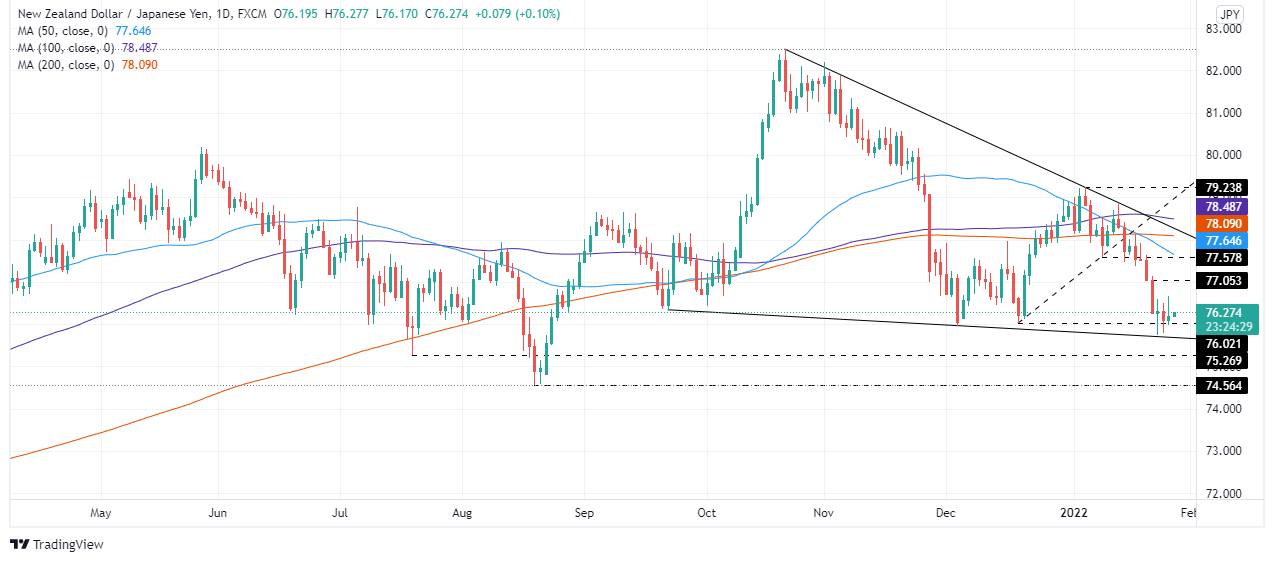
- NZD/USD holds steady despite CPI beat.
- The markets have piled into the US dollar following hawkish Fed Powell.
Consumer Price Index for New Zealand arrived and beat expectations. The consensus expected inflation to rise 1.3% QoQ and 5.7% YoY. However, the data beat 1.4% and 5.9% respectively.
NZD/USD stabilised ahead of the Federal Reserve meeting, but the Fed's chair, Jerome Powell delivered a hawkish commentary at the press conference that shook things up. In early Asia, the bird is ending the day down near 0.5% to 0.6650 after falling from a high of 0.6701 to a low of 0.6638.
Fed's Powell's key comments
- We are of a mind to raise rates at march meeting’.
- The current economy means we can move sooner, perhaps faster than we did last time.
- Next meeting will be coming to more of the details on the Balance Sheet.
- Other forces this year should also bring down inflation.
- Quite a bit of room’ to raise rates without dampening employment.
- No decision made on policy path, path to be led by incoming data.
''Near term, we expect the kiwi’s downtrend to resume and rallies are selling opportunities,'' analysts at ANZ Bank explained.
NZD/USD daily chart
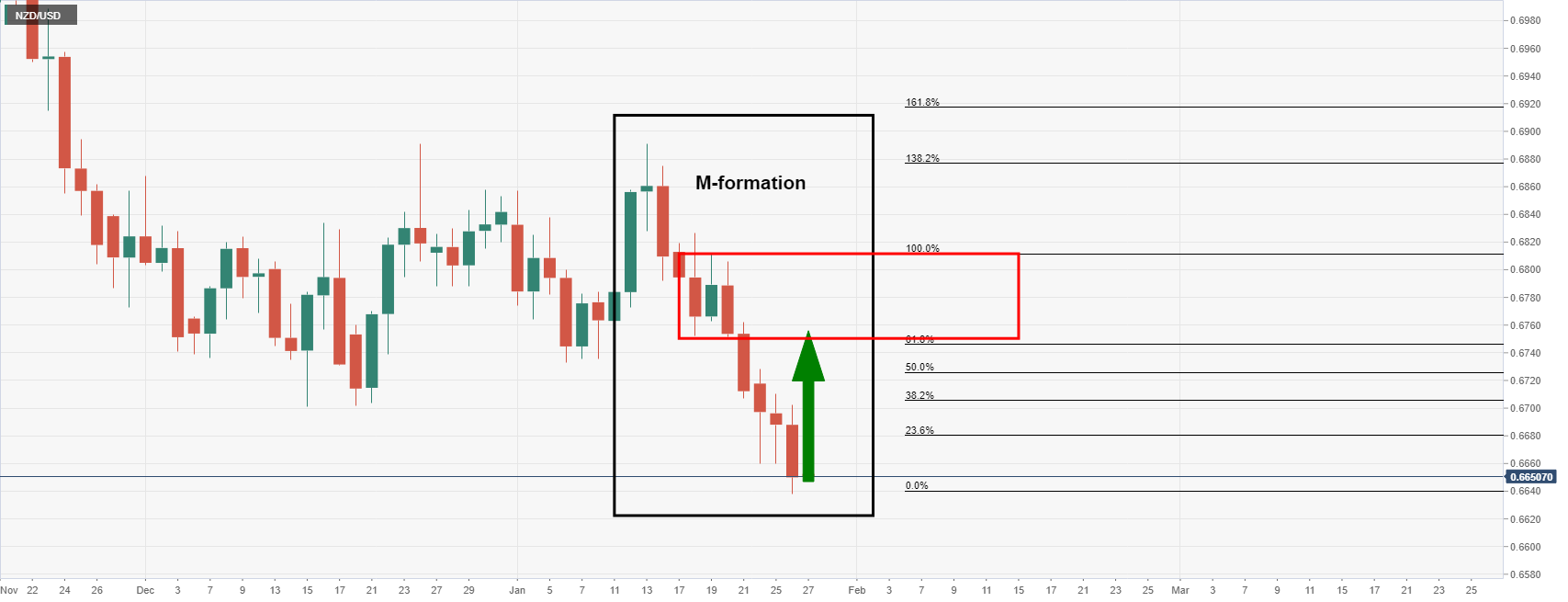
The M-formation is a reversion pattern and bulls can targe the neckline near 0.6750. However, a more shallow target comes near the 38.2% Fibonacci around 0.67 the figure.
Tesla (TSLA) reported earnings for Q4 after the close on Wednesday. Earnings per share came in at $2.54 versus the average estimate of $2.26. Revenue was $17.72 billion versus estimates for $16.35 billion.
Tesla (TSLA) stock forecast
Tesla stock is trading at $880 versus the regular session close at $938.72, a loss of 6%.
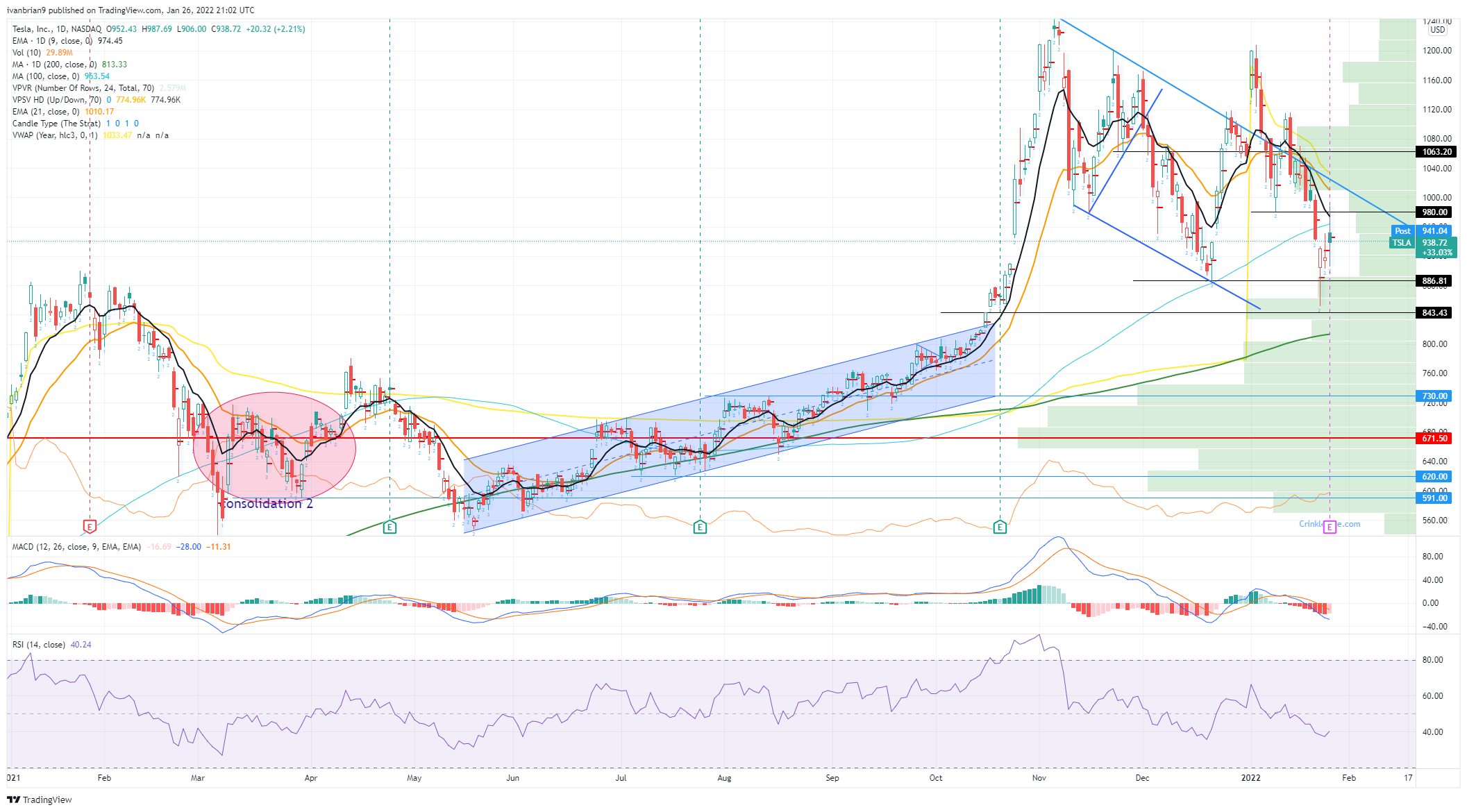
Tesla (TSLA) chart, daily
- GBP/USD bears take control and home in on the 2022 lows.
- The Fed's chair wore his hawkish hat to the Fed presser on Wednesday.
Trading at 1.3455, GBP/USD is down 0.35% on the day so far, falling in a move that followed a hawkish twist in today's Federal Reserve event. Cable has broken 1.3490 support and has plummetted to a low of 1.3444 in a move that was encouraged by hawkish comments from the Fed's chair, Jerome Powell.
Despite a relatively dovish statement, as per the most hawkish of market expectations, the US dollar and yields have soared on the back of a pivot during the Federal Reserve's chairman's press conference.
Jerome Powell stated in the post-Federal Open Market Committee statement presser that the central bank could move faster and sooner than they did the last time which has promoted both the US dollar and yields to extend gains for the day:
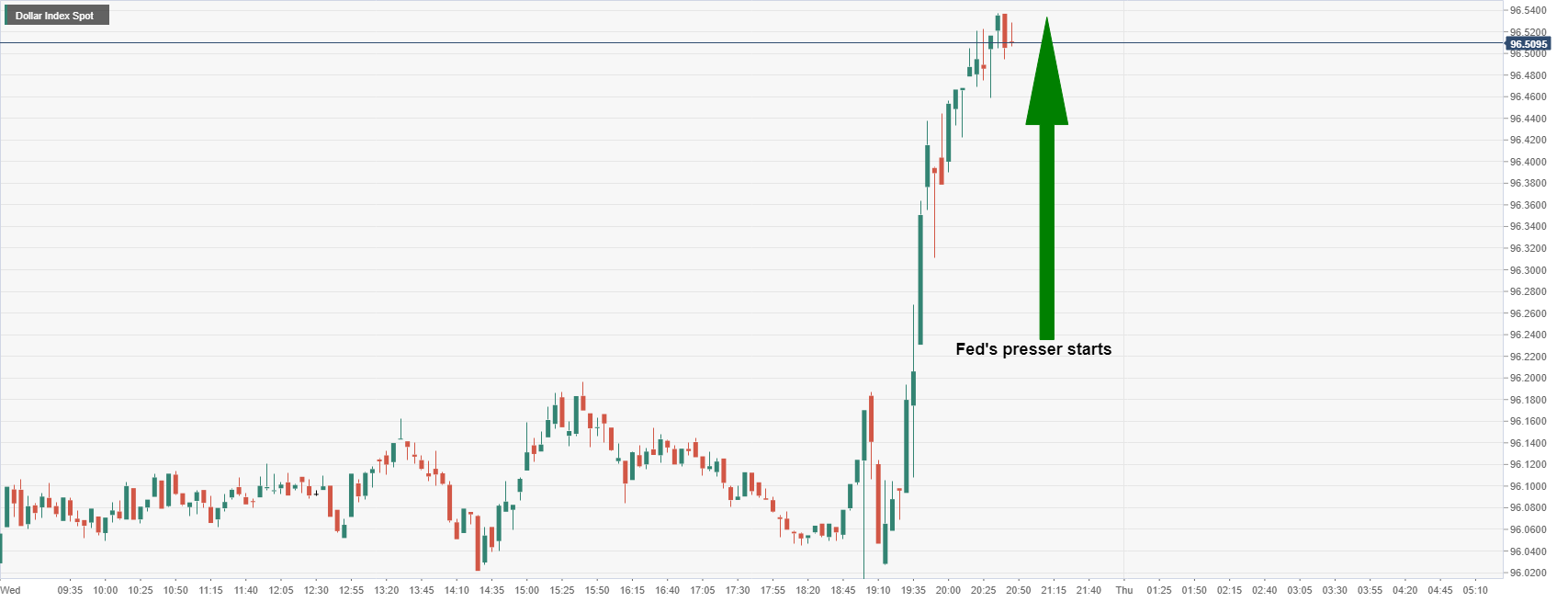
Fed's Powell's key comments
- We are of a mind to raise rates at March meeting’.
- The current economy means we can move sooner, perhaps faster than we did last time.
- Next meeting will be coming to more of the details on the Balance Sheet.
- Other forces this year should also bring down inflation.
- Quite a bit of room’ to raise rates without dampening employment.
- No decision made on policy path, path to be led by incoming data.
GBP/USD technical analysis
As a consequence, US equities are reeling in pain which is hurting the risk-sensitive currencies such as the pound vs the US dollar:

The bears are looking over the abyss at this juncture, in pursuit of the 2022 lows of 1.3431.
What you need to know on Thursday, January 27:
The dollar is ending Wednesday firmly higher across the FX board, following the US Federal Reserve monetary policy decision.
As widely anticipated, rates and taper were left unchanged, although the statement indicates that “ the Committee expects it will soon be appropriate to raise the target range for the federal funds rate.” Ahead of the event, most market participants priced in a rate hike in March. There were no mentions to the balance sheet, but market’s were not expecting those.
Chief Jerome Powell´s press conference was a mixture, as he expressed concerns about the current wave of coronavirus and its potential to damage the economy but also said that he expects inflation to decline over the course of the year. He added that the rate-hike path would depend on incoming data and noted that it is “impossible” to predict, although he also noted that there’s plenty of room to raise rates.
Gold was among the worst performers, shedding roughly $ 30.00 per troy ounce. The bright metal settled at $1,816 a troy ounce. Crude oil prices managed to retain gains, with WTI pulling back from a daily high of $87.92 to end the day at around $86.50 a barrel.
EUR/USD trades around 1.1240, while GBPUSD hovers around 1.3460. The AUD/USD pair nears the weekly low at 0.7089, while USDCAD is currently at 1.2670. The USD/JPY pair trades at 114.60.
Stocks trimmed early gains and turned red, with the DJIA down 154 points after trading up some 400 points ahead of the event.
US government bond yields jumped with the news, with that on the 10-year Treasury note peaking at 1.857%.
Top 3 Price Prediction Bitcoin, Ethereum, XRP: Cryptos to enjoy 20% upswing
Like this article? Help us with some feedback by answering this survey:
In his usual post-Fed meeting press conference, Fed Chair Jerome Powell said on Wednesday that he expects to see progress on inflation in the second half of 2022.
Additional Remarks:
"It's a very, very tight labor market."
"We think there's a pool of people who could come back to labor force, but may not happen quickly."
"I do not expect supply chain issues to be completely worked out by end of year, but do expect progress."
"I expect progress on inflation in the second half of this year."
"We are not making progress, overall, on the supply chain issue."
"We think we are positioned to make changes to our policy to deal with inflation."
"We are positioned to make changes in policy to address the risk of higher inflation."
"We have not made any decision on the size of rate increases."
"That said, we are aware this is a very different expansion than the last one."
"As we work our way through meeting by meeting, we are aware of differences from the last time we raised rates."
"Those differences will be reflected in the policy we implement."
"We are not trying to get inflation below 2%, want inflation expectations well anchored at 2%
"We get to that goal by getting inflation averaging 2% over time."
"Growth this year is forecast to be well above potential."
"The abor market is going to be strong for some time."
"We want inflation back down to 2% in a way that leaves the labor market very strong."
"We want to get inflation back down to 2% but also leave the labor market in a strong position."
"Monetary policy will do its job."
"I don't think the Fed's two goals are in tension."
"A significant threat to the labor market is high inflation."
"High inflation also taking away the benefits of large wage increases."
"We monitor the slope of the yield curve, but we don't control it."
"We take the yield curve into account alongside other considerations."
"The 2s to 10s gap is 'well within range' of normal yield curve slope."
"This is going to be a year in which we move steadily away from highly accommodative policy."
"That will involve ending asset purchases, lifting off and additional rate increases."
"The last thing we will do is allow the balance sheet to run off."
"We will have a couple more meetings about allowing the balance sheet to run off."
"We will then do that as appropriate."
"It's impossible to say exactly how policy will go."
"We will be nimble about this."
"The economy is quite different this time from last tightening cycle."
"All of these things will go into our thinking on policy."
"Asset prices are somewhat elevated."
"I don't think asset prices themselves represent a significant threat to financial stability."
- EUR/USD is under pressure as the Fed chair's hawkish comments send Wa;l Street lower and USD higher.
- Fed's chair, has stated in the presser that they could move faster and sooner than they did the last time.
EUR/USD is down 0.5% on the day following a sell-off on the back of a hawkish turn of events during the Federal Reserve event today, Despite a relatively dovish statement, as per the more hawkish of market expectations, the US dollar and yields have soared on the back of a pivot during the Federal Reserve's chairman's press conference.
Jerome Powell, the Fed's chair, has stated in the presser that they could move faster and sooner than they did the last time which has helped the US dollar to extend on pre presser gains:
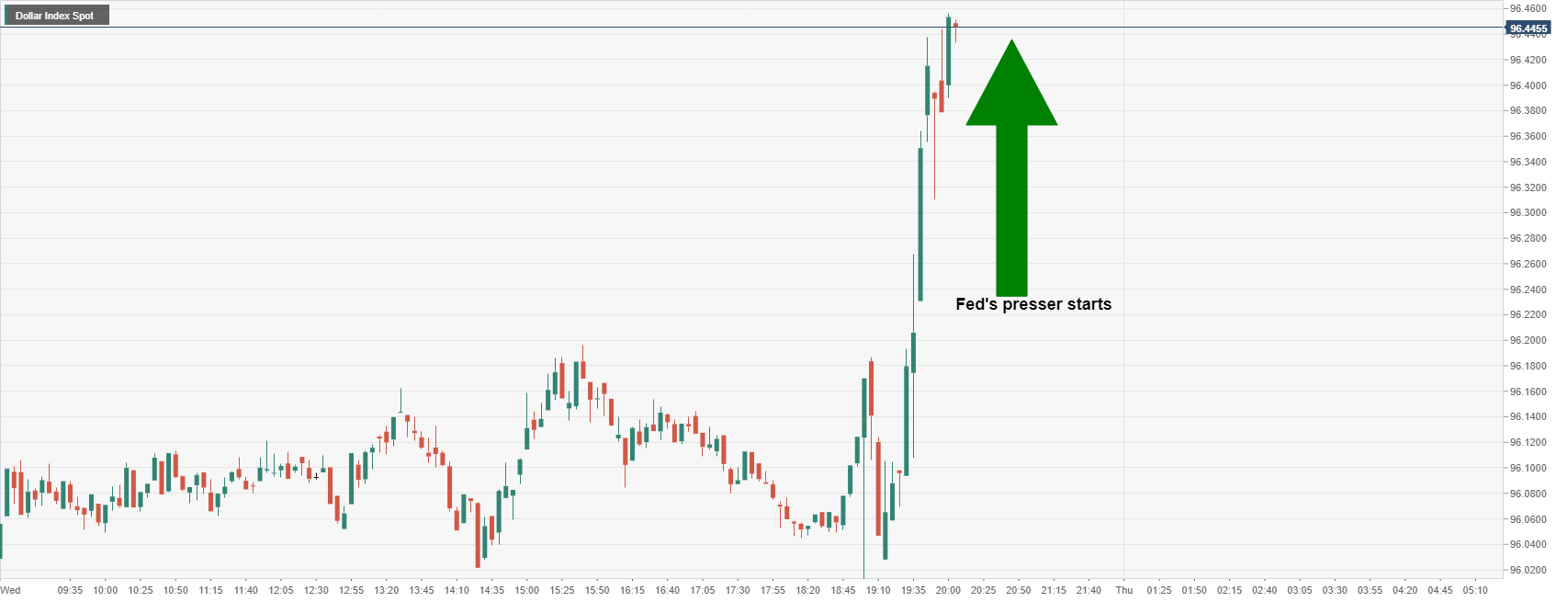
Additionally, the Fed's chair stated that they could hike rates at every meeting and that they are in the mind to raise rates in March.
Fed's Powell's key comments, so far
- We are of a mind to raise rates at March meeting’.
- The current economy means we can move sooner, perhaps faster than we did last time.
- Next meeting will be coming to more of the details on the Balance Sheet.
- Other forces this year should also bring down inflation.
- Quite a bit of room’ to raise rates without dampening employment.
- No decision made on policy path, path to be led by incoming data.
EUR/USD technical analysis
As a consequence, US equities are down and EUR/USD has dropped below a key technical level on the charts, losing the 1.13 area and printing a fresh low of 1.1240:
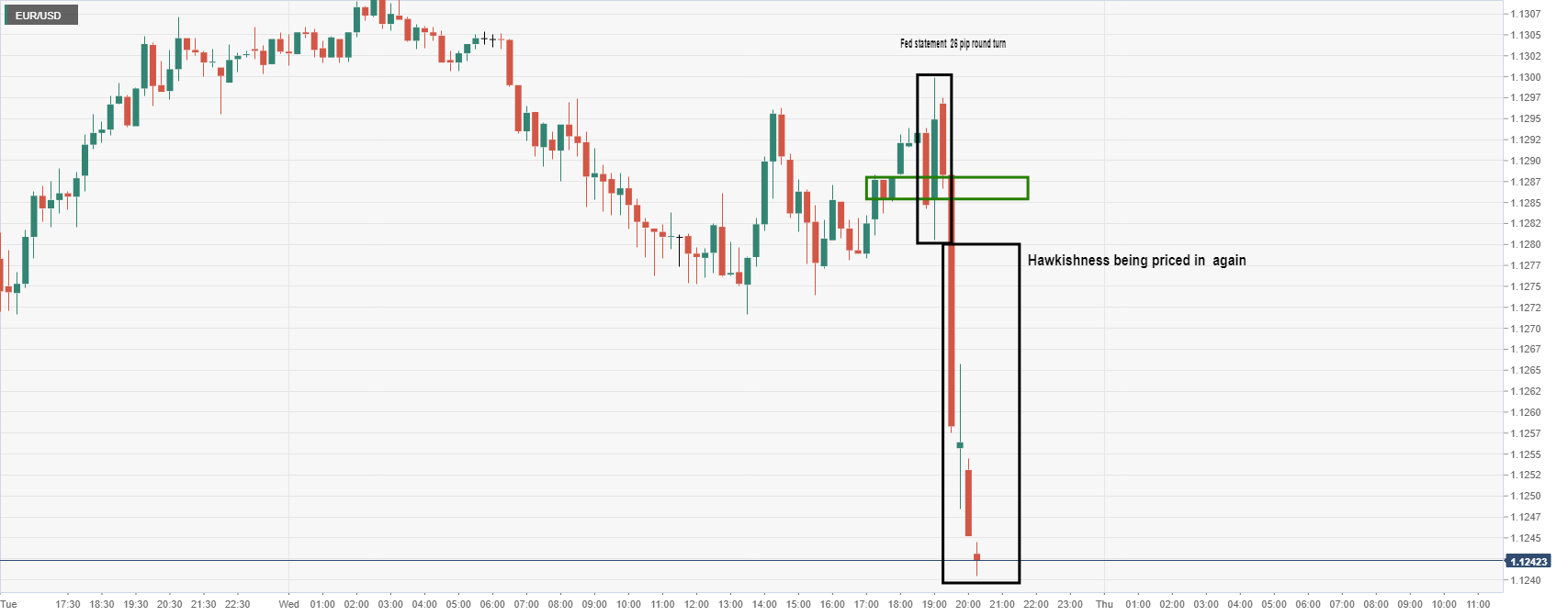
On the wider time frames, such as the H4 chart, the price is seen testing the next critical level of support:
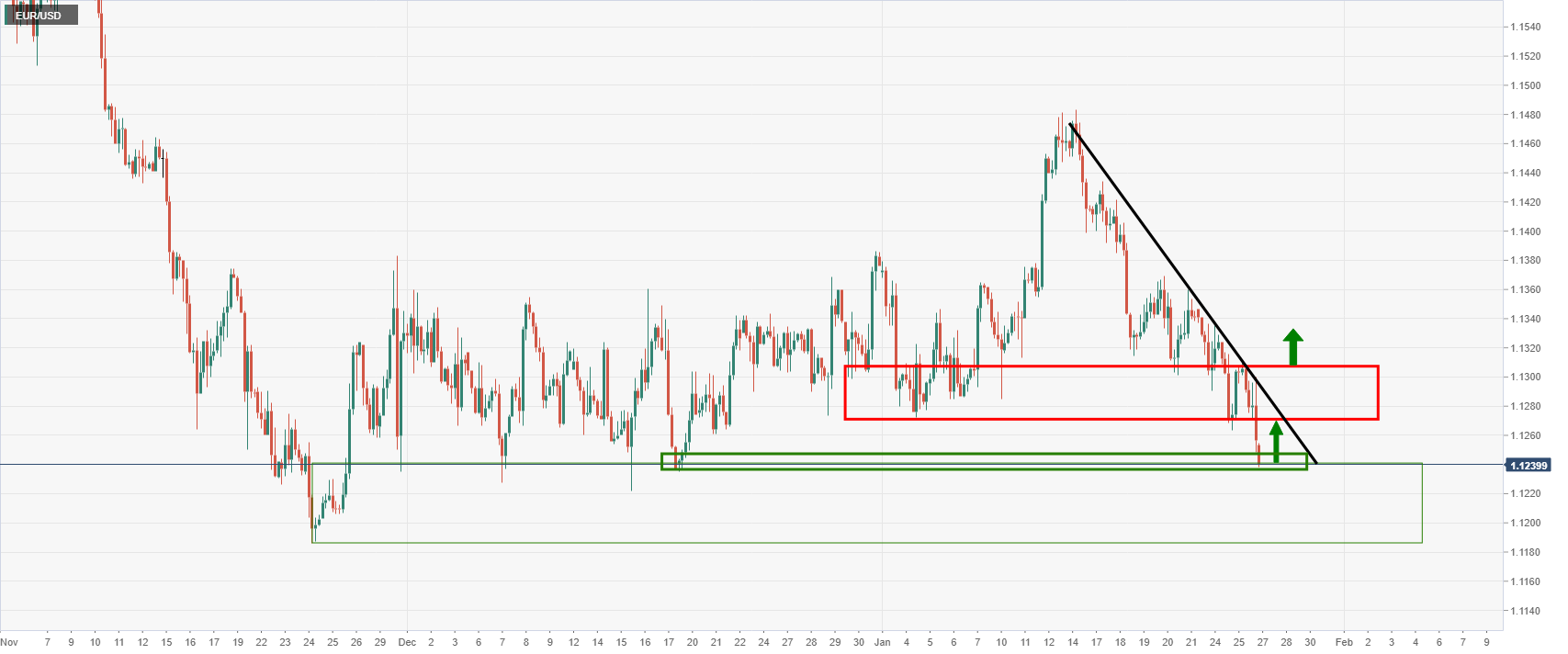
Bulls will need to get back above 1.1310 to be in the clear at this juncture.
- The S&P 500 faced strong resistance at the 200-DMA followed by a sharp drop approaching January 25 daily lows at 4,287.
- The S&P 500 plunges almost 1% during the New York session.
- S&P 500 Technical Outlook: Downward biased, as it failed to reclaim the 200-DMA.
After the Federal Reserve announced that it keep the Federal Funds Rates (FFR) unchanged at the 0 to 0.25% range while signaling that they would hike rates “soon,” the S&P 500 plummets 1.09%. At the time of writing, the S&P 500 sits at 4,313.83.
S&P 500 Price Forecast: Technical outlook
From a technical analysis perspective, the S&P 500 failed to reclaim the 200-DMA, which sits at 4,432.65, eyeing the January 24 cycle low at 4,222.62, which was the low of the 12% correction that began on January 4.
That said, the S&P 500 outlook is bearish biased, spurred in part by the US T-bond 10-year Treasury yield rising up to 1.84%
The S&P 500 first support level would be the aforementioned January 24 low at 4,222.62. A breach of the latter would expose June 18, 2021, daily low, which previously tested the 50-day moving average (DMA) at 4,164.40, followed by May 19, 2021, daily low at 4,061.41.
To the upside, the S&P 500 first resistance would be 4453.23, followed by September 23, 2021, a daily high at 4,465.40. A break above that level would expose the 100-DMA at 4,570.04.
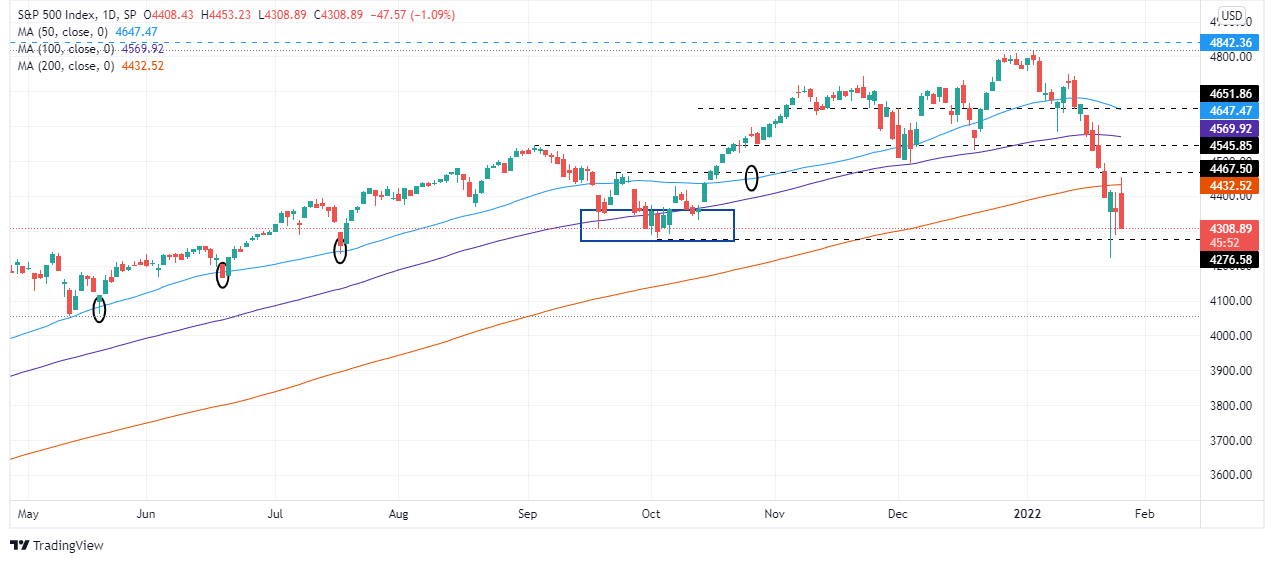
Fed Chair Jerome Powell, in his usual post-Fed meeting press conference on Wednesday, said there is a risk high inflation will be prolonged, even though it's not our base case.
Additional Remarks:
"We have to be able to address all plausible outcomes."
"We need to be in a position to address the risk that inflation remains higher."
"What we need is another long expansion."
"To get back to long expansion, need price stability."
"We need to do our part in getting inflation back down."
"The Covid pandemic is not over and could continue to evolve and harm growth."
"Another risk is further supply chain issues."
"The Eastern Europe situation is another risk."
"There are plenty of risks out there and we can't forget there are risks on both sides."
When asked for details on former Dallas Fed Chief Robert Kaplan's stock-trading, Powell says "Fed board does not have that information."
"Since the last meeting, the inflation situation is slightly worse."
"I would raise my SEPs on inflation for this year if I was writing them today."
"If inflation deteriorates further, we will have to address that."
"Moving away to substantially less accommodative, and in time to non-accommodative policy, will be part of bringing inflation down."
"We need to move to substantially less accommodative policy."
"We will eventually get relief on the supply side, though it's taking longer than expected."
"There's a risk inflation will stay high longer than expected."
"Our aim is to get inflation back down to 2%."
"The labor market is very, very strong right now."
"There are very large wage increases."
"The outlook is quite uncertain."
"We will have to adapt due to the uncertainty of the outlook."
"We will move as appropriate."
"We will have to adapt and move as appropriate."
"We fully appreciate this is a different situation than the last time Fed raised rates."
"Right now inflation is high, growth is higher than potential, labor market is historically tight."
- US dollar and yields have shot higher, extending the post-Fed statement gains during Fed Powell's hawkish pivot.
- Bulls have got behind a faster pace of tightening than what had been priced in.
The Federal Reserve did what was expected from them in the main and there had been low volatility in the currency space as a consequence, until Powell's pivot.
As a consequence of a hawkish turn by the Fed's chairman, Jerome Powell, during the presser, the US dollar has picked up a bid and moves to the first position on the Currency Strength Indicators.
Markets were expecting to be "prepared for liftoff" from the meeting which both the statement and the Fed's chair, Jerome Powell, has done. However, guidance on the likely pace of tightening, via QT (quantitative tightening), as well as the funds rate for the year/years ahead, would have been greater catalysts for markets. This did not come. Instead, there were no definitive signals.
However, Powell has stated in the presser that they could move faster and sooner than they did the last time which has helped the US dollar to extend on pre presser gains:
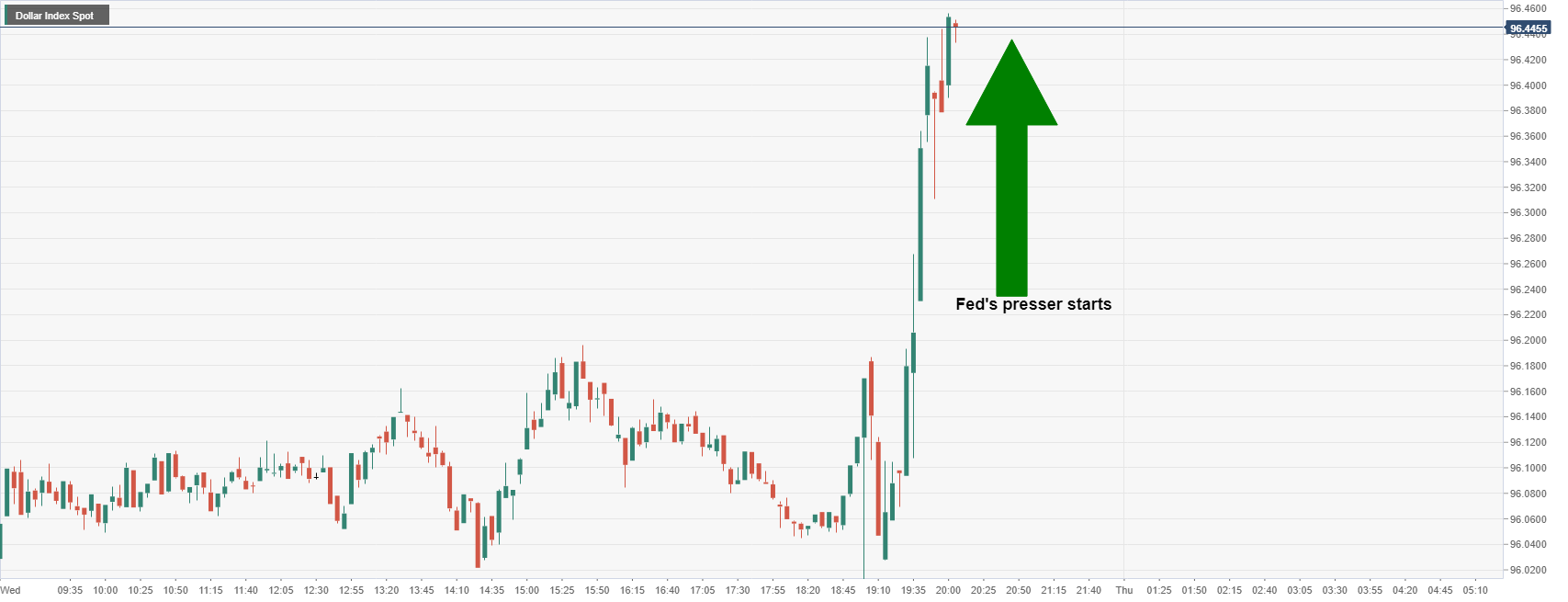
Fed's Powell's key comments, so far
- We are of a mind to raise rates at march meeting’.
- The current economy means we can move sooner, perhaps faster than we did last time.
- Next meeting will be coming to more of the details on the Balance Sheet.
- Other forces this year should also bring down inflation.
- Quite a bit of room’ to raise rates without dampening employment.
- No decision made on policy path, path to be led by incoming data.
Fed's statement, key takeaways
- A rather mixed and fairly dovish statement ticked some of the boxes as follows:
- As expected, the benchmark interest rate was unchanged; The Target Range stands at 0.00% - 0.25% - Interest Rate on Excess Reserves is also unchanged at 0.15%.
- There were no mentions of early rate hikes, let alone a 50bp hike (which some analysts have been expecting).
- QE is not indicated to end early either and that the balance sheet shrinking would start after rate hikes commence.
- The Fed has warned that soon it will be appropriate to raise rates.
- The Fed has stated that both the economy/employment have strengthened and that jobs gains are solid.
- "Overall financial conditions remain accommodative, in part reflecting policy measures to support the economy and the flow of credit to US households and businesses," is an unchanged statement that indicates we are no closer to lift off than of the prior meeting.
- Subsequent to this statement, Fed's funds futures are looking for four rate hikes for this year.
US yields are up on Fed rate hike expectations
US Treasury yields across the curve shot higher on Wednesday after the Federal Reserve chairman added colour to the statement that said US interest rates would rise "soon", adding that it will end its asset purchase program in early March.
The Fed, however, did not set a specific date for raising interest rates. With that being said, federal funds futures have fully priced in a quarter-point tightening for the Fed's March meeting, and another three hikes for 2022.
However, Fed's chairman Powell was uber hawkish in his comments around raising rates at every meeting. "Quite a bit of room to raise rates without hurting jobs'', he added.
As a consequence, the benchmark US 10-year yield rose to 1.855%. The US 30-year yields were moved to 2.172% and on the front end of the curve, US 2-year yields shot up to 1.095%.
In his usual post-Fed meeting press conference, Fed Chair Jerome Powell said on Wednesday that the FOMC is "of a mind" to raise interest rates at the March meeting.
Additional Remarks:
"The ultimate focus we have is on the real economy."
"Financial conditions matter to the extent they have implications for fed's two goals."
"Financial conditions matter when they affect dual goals."
"We are not looking at any one market."
"Our communications with markets is working."
"Financial conditions are reflecting in advance the Fed's decision."
"We will make the decision whether to raise rates at the March meeting."
"We do expect some softening from Omicron, but think it will be temporary."
"We have our eye on risks around the world, but the economy should hold up."
"We do expect this year, but slower than we had expected, that supply chain problems will ebb."
"We will react however inflation moves."
"We are well aware this is a different economy to last tightening cycle."
"If the situation is different than thought, will change our balance sheet plan as needed."
"It's time to stop asset purchases and, at the appropriate time, to start shrinking the balance sheet."
"There's a substantial amount of balance shrinkage to be done."
"We want balance sheet shrinkage to be orderly, predictable."
"After we get underway with rates, then we'll turn to balance sheet."
"We will have another discussion on the balance sheet at our next meeting, and at least one at the meeting after that."
"We will discuss the balance sheet at the next two meetings."
Fed Chair Jerome Powell in his post-Fed meeting press conference said that both sides of our mandate are calling for the Fed to move away from highly accommodative policy.
Additional Remarks:
"The labor market is consistent with max employment."
"That is also my personal view."
"Broad agreement on FOMC will soon be time to raise rates."
"Level of maximum employment may increase as more people return to labor market."
"The policy path we are contemplating would be supportive of that outcome."
"There is quite a bit of room to raise interest rates."
"There is quite a bit of room to raise rates without dampening employment."
"This is a very very strong labor market."
"We can move rates up without having to undermine the jobs market."
"Other forces this year should also bring down inflation."
"Fiscal policy will be less supportive of growth this year."
"Fiscal impulse to growth will be significantly lower, also helping curb inflation."
"There are multiple forces that should be working this year to bring inflation down this year."
"We are prepared to use our tools to ensure higher inflation does not become entrenched."
"The Fed just turning to balance sheet questions."
"This meeting we have put together guidance for decision making."
"This process we will spend time on in upcoming meetings."
"At the appropriate time, we'll give more information on balance sheet reduction."
"The next meeting we will turn to discussing more details on balance sheet reduction."
"At the next meeting will be coming to more of the details on the balance sheet."
"Current economy means we can move sooner and perhaps faster than we did last time."
"We do want balance sheet to be reduced primarily by adjusting reinvestments."
"We think of balance sheet as moving in the background in a predictable manner."
"The active tool is the Fed Funds rate."
"There is an element of uncertainty around the balance sheet."
"Greater clarity we have is on how the Fed funds rate affects financial conditions."
"Balance sheet reduction will start in the background."
"We will arrive at timing, pace and composition of balance sheet reduction, announce it, and will have it running in the background."
"On the size, pace and composition, they are still to be discussed."
- The Federal Reserve kept interest rates unchanged at 0 – 0.25%.
- The AUD/USD initially spiked up to 0.7182, to then retreat towards 0.7140 previous to Fed’s Chair Powell press conference.
The Australian dollar clings to its daily gains after the Federal Reserve signaled that it would raise interest rates “soon” while keeping the Federal Funds Rate (FFR) unchanged at 0 to 0.25%, as widely expected.
The AUD/USD reacted to the upside, reaching a daily high at 0.7182, though as the US central bank Chair Jerome Powell begins his press conference, the pair edges lower some 40 pips, down to 0.7140 at 19:37 GMT.
One of Jerome Powell’s press conference remarks is that the Fed does not have a timing schedule regarding reducing its balance sheet.
Summary of the Federal Reserve monetary policy statement
Federal Reserve policymakers expressed that raising the FFR would be appropriate. In 2021, the US central bank increased the speed of reducing its Quantitative Easing (QE), though it announced another increase in the pace. That said, the Fed will end the QE by early March.
Also, the Fed expressed that it will continue to monitor information for the economic outlook. They noted that “supply and demand imbalances related to the pandemic and its reopening” contributed to elevated inflation levels.
The US central bank expects to begin reducing the balance sheet size once the bank begins the process of hiking rates. Regarding employment, they noted that “job gains have been solid in recent months, and the unemployment rate has declined substantially.”
Update on AUD/USD price action
At press time, at 19:50 GMT, the AUD/USD is plunging to 0.7114, as USD bulls have taken control, pushing the pair down.
Fed Chair Jerome Powell, at his usual post-Fed meeting press conference on Wednesday, said that the Fed has not made decisions on the timing and pace of shrinking the balance sheet or interest rate hikes yet.
Additional Remarks:
"It is not possible to predict the path of the policy rate."
"It is not possible to predict with much confidence the path of policy."
"We will be humble and nimble on policy."
"There are two side risks now."
"We will need to navigate cross-currents, two-sided risks."
"We will be guided by data and the evolving outlook."
"We will try to communicate as clearly as possible."
"We know the economy is in a very different place to 2015."
"The economy now much stronger than then."
"These differences will have implications for pace of rate hikes."
"Beyond that, no decisions made."
In his post-monetary policy announcement press conference, Fed Chair Jerome Powell said on Wednesday that, with elevated inflation and a strong labour market, the Fed will continue to adapt policy.
Additional Remarks:
"The economy has shown great strength."
"The Covid-19 Omicron variant will surely weigh on economic growth this quarter."
"Activity more broadly may also prevent workers reporting to jobs."
"Omicron expected to drop off rapidly."
"If the wave passes quickly, economic effects should dissipate quickly too."
"The labor market has made remarkable progress."
"Improvement in the labor market has been widespread."
"The labor demand remains historically strong."
"Wages are rising at the fastest pace in many years."
"The current wave of the virus may well prolong effects on labor force."
"Inflation remains well above our long-run goal."
"Supply problems larger and longer-lasting than thought."
"High inflation now spread more broadly."
"Inflation is expected to decline over the course of the year."
"We think the best thing we can do is promote a long expansion; that requires price stability."
"Committed to price stability goal."
"Watching carefully to see if the economy evolving in line with expectations."
"The economy no longer need sustained high levels of policy support."
"In light of inflation and employment, the economy no longer needs sustained high levels of support."
"The economic outlook remains highly uncertain, requires humility."
"We need to be nimble."
"We will remain attentive to risks."
"We are repared to respond as appropriate to achieve goals."
"We will remain attentive to higher inflation proving more persistent and react accordingly."
"The Fed Funds rate is our primary means of policy."
"Reducing balance sheet will occur after interest rates rises have begun."
"We will be prepared to adjust any of the details of balance sheet reduction approach."
GBP/USD saw a choppy post-Fed reaction, swinging from just above 1.3500 pre-announcement to as high as the 1.3520s and then lower again to current levels around 1.3510. All said, there hasn’t been much follow-through in terms of an FX market reaction in wake of the Fed’s latest monetary policy decision, which seemed to go down pretty much bang in line with expectations. Interest rates were left on hold as expected and while the Fed didn’t explicity say it would hike rates in March, it said (as expected) that it would soon be time to hike interest rates.
The Fed reiterated that its QE programme would come to an end in March and that it expects to commence reductions in the size of the balance sheet after the process of lifting interest rates has gotten underway. So all in all, nothing new from the Fed’s latest monetary policy statement or rate decision hence the lack of GBP/USD volatility. Attention now turns to Fed Chair Jerome Powell’s press conference, which commences at 1930GMT. Powell will likely be quizzed on topics such as the potential number of/pace of rate hikes in 2022 and beyond, as well as how the discussion regarding quantitative tightening is going. Any more specifics on either of these two topics would be of great interest to market participants.
But Powell is usually a pro at not saying anything that rocks the boat too much during the press conference, so the scope for further FX market volatility may be fairly low. That may mean GBP/USD remains contained within recent 1.3490-1.3530ish ranges. But a lack of surprises from Powell often help risk appetite and gains in risk assets could help give risk-sensitive currencies such as GBP a lift.
- The US central bank kept rates unchanged and signaled it would hike rates “soon.”
- The USD/JPY spiked to 114.48 then retreated to pre-Fed levels on a “buy the rumor, sell the fact” event.
- US 10-year T-bond yield shoot through 1.80%, sits comfortably around that level, post-Fed.
On Wednesday, in the Fed’s first monetary policy meeting, the US central bank maintained rates unchanged at 0 to 0.25%, while on its forward guidance, signaled that it will start hiking rates “soon,” which spurred a spike on the USD/JPY towards 114.48. At press time, the USD/JPY is trading at 114.27 at 19:22 GMT.
USD/JPY Market Reaction
The USD/JPY spiked towards 114.48; meanwhile, the US 10-year Treasury yield shoots through 1.8029%.
Summary of the Federal Reserve monetary policy statement
In an overview of the monetary policy statement, Fed policymakers expressed that raising the Federal Funds Rate would be appropriate. As mentioned the last year, the Fed increased the pace of the bond taper and would end the Quantitative Easing (QE) by early March.
Despite tightening conditions, the US central bank expressed that it will continue to monitor information for the economic outlook. The Fed said that “supply and demand imbalances related to the pandemic and its reopening” contributed to elevated inflation levels.
The US central bank commented that it “expects that reducing the balance sheet size will commence after the process of increasing the target range for the Federal Funds Rates has begun.”
Regarding the job market, they noted that “job gains have been solid in recent months, and the unemployment rate has declined substantially.”
Putting this aside, the USD/JPY trader’s focus turns to the Fed’s Chairman Jerome Powell, who will be speaking at 19:30 GMT.
Follow the coverage here: Fed Press Conference: Chairman Jerome Powell speech live stream – January 26
- The Fed disappoints the US dollar bulls with a benign outcome in the statement.
- EUR/USD sits around pre-event levels awaiting Fed's chair Powell.
The Federal Open Market Committee's two-day meeting has concluded on Wednesday and the statement has been released along with the Fed's interest rate decision in a highly anticipated event for financial markets.
Markets were expecting the Fed to give guidance on asset purchases that were expected to conclude in March. However, traders were looking for hints around the starting point for QT or "sooner" and "faster" on hikes.
Fed's statement, key takeaways
A rather mixed and fairly dovish statement ticked some of the boxes as follows:
As expected, the benchmark interest rate was unchanged; The Target Range stands at 0.00% - 0.25% - Interest Rate on Excess Reserves is also unchanged at 0.15%.
There were no mentions of early rate hikes, let alone a 50bp hike (which some analysts have been expecting).
QE is not indicated to end early either and that the balance sheet shrinking would start after rate hikes commence.
The Fed has warned that soon it will be appropriate to raise rates.
The Fed has stated that both the economy/employment have strengthened and that jobs gains are solid.
"Overall financial conditions remain accommodative, in part reflecting policy measures to support the economy and the flow of credit to US households and businesses," is an unchanged statement that indicates we are no closer to lift off than of the prior meeting.
Subsequent to this statement, Fed's funds futures are looking for four rate hikes for this year.
EUR/USD: Reaction and technical analysis
Following the Fed's statement, EUR/USD has made a round trip of between 26 pips and is pretty much stationed to where it was before the release:

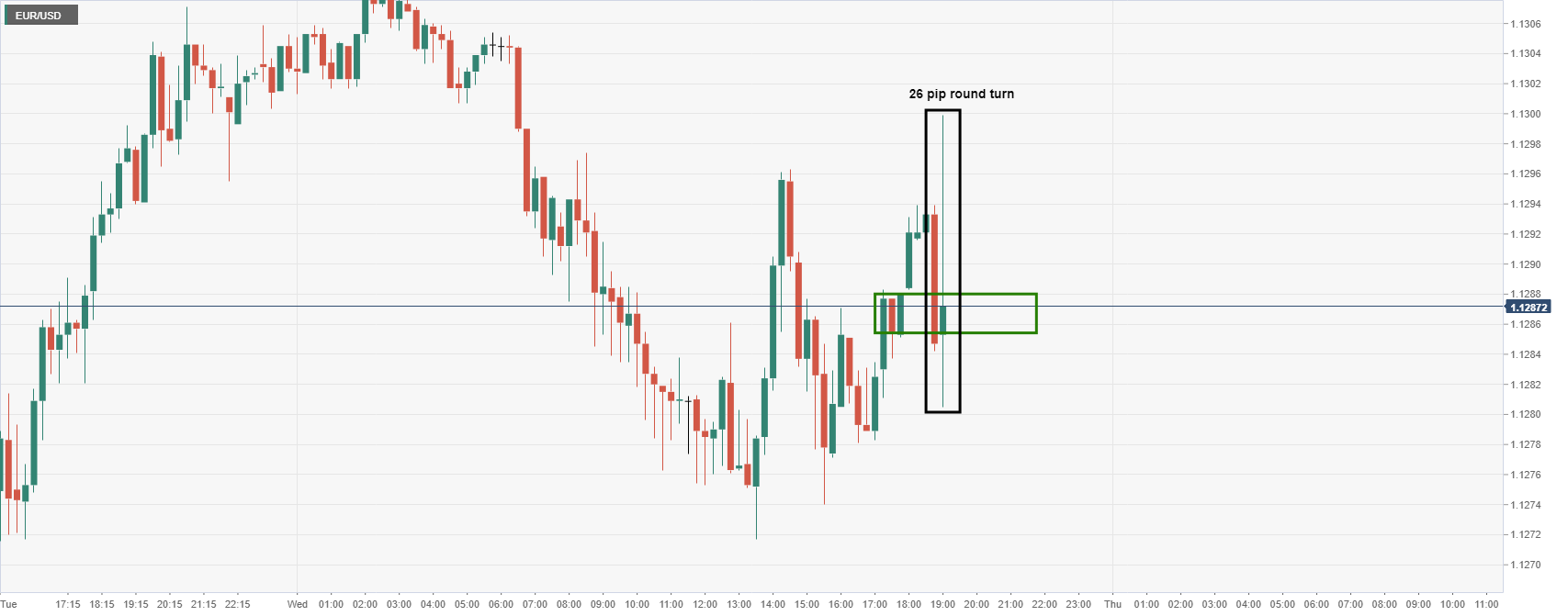
Meanwhile, the euro recently denied bulls an extension to and through the 1.15 psychological level when reaccumulation failed to play out following the breakout of the late 1.13 area near 1.1390:
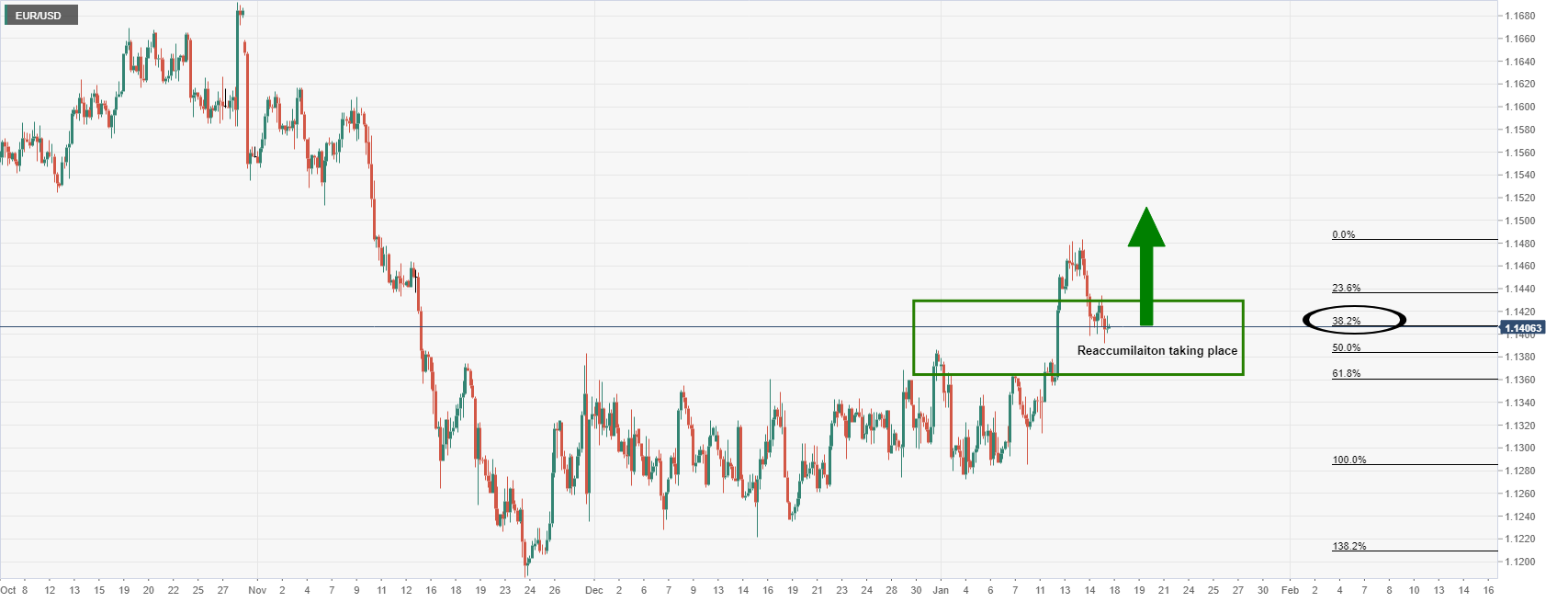
Instead, the price plummeted back into the consolidation area, weighed heavily by risk-off markets due to geopolitical angst over tensions between Russia and the Ukraine:
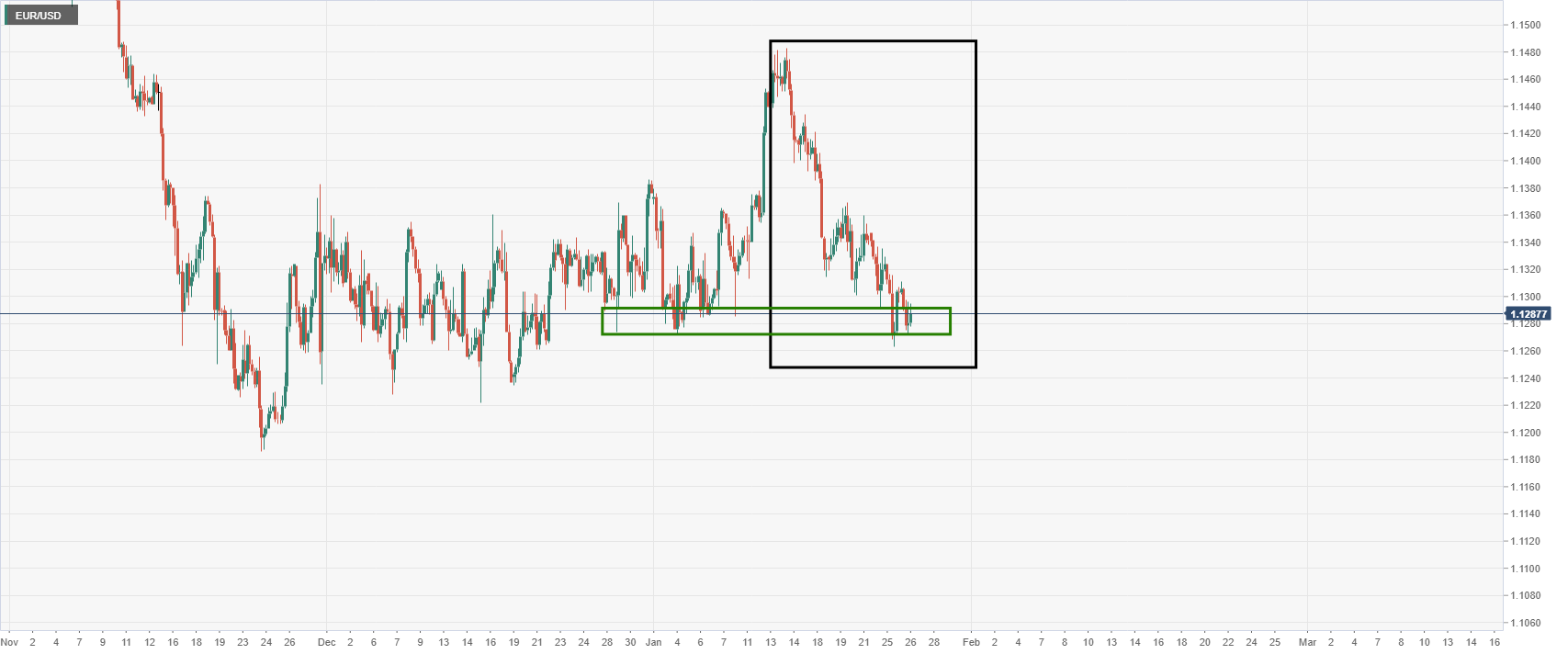
Given that the statement is leaning slightly dovish compared to some of the more hawkish expectations in the markets, the US dollar could continue to struggle in the event that geopolitical angst abates. The euro would be expected to benefit in a pick up of risk apatite in global equities as well. EUR/USD bulls will need to get back above 1.13 the figure though...
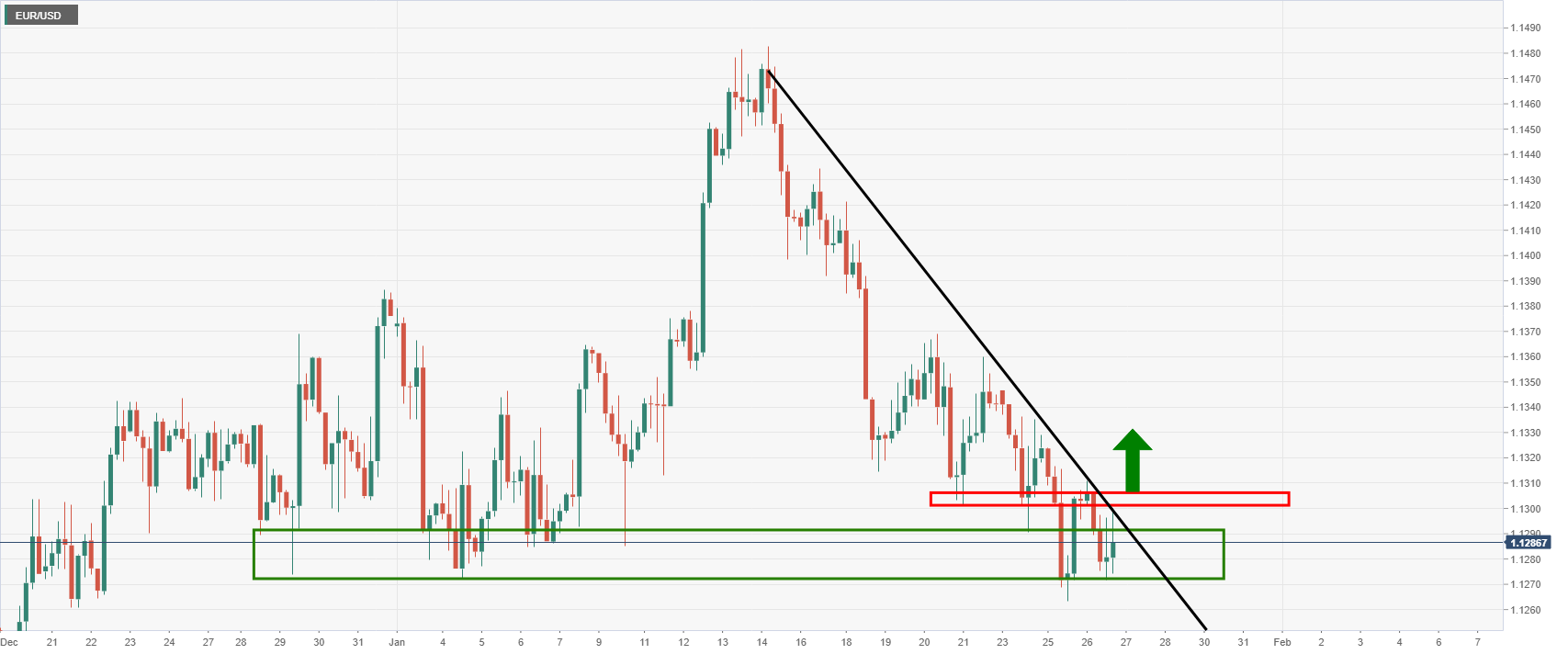
Meanwhile, the markets will now look for clarity from the Fed's chair, Jerome Powell. His comments could provide volatility for EUR/USD traders:
Watch Live: Fed's chair, Jerome Powell
Jerome Powell, will be delivering his remarks on the monetary policy outlook at a press conference following the meeting of the Board of Governors. Powell's speech will start at 19:30 GMT.
Follow our live coverage of the Fed's policy announcements and the market reaction.
The US Federal Reserve announced on Wednesday that the FOMC had agreed to leave the Federal Funds target range unchanged at 0.0-0.25%, in line with expectations. The central bank said that it would soon be appropriate to raise the Federal Funds rate, the strong hint that many market participants would have been looking for that a first post-pandemic rate hike in March is likely.
Additional Takeaways as summarised by Reuters:
"The Fed will bring bond-buying to an end in early March."
"The Fed is prepared to adjust the stance of monetary policy as appropriate if risks emerge that impede its goals."
"In assessing monetary policy, the Fed will continue to monitor incoming information for the economic outlook."
"Supply and demand imbalances related to the pandemic and the reopening of the economy have continued to contribute to elevated levels of inflation."
"The sectors most adversely affected by the pandemic have improved in recent months but are being affected by the recent sharp rise in Covid-19 cases."
"To increase treasuries by $20B, MBS by $10B starting in February."
"The Fed expects that reducing balance sheet size will commence after the process of increasing the target range for the federal funds rate has begun."
The Fed reaffirms in an identical statement the longer-run goals and monetary policy strategy adopted in August 2020.
"Progress on vaccinations and an easing of supply constraints are expected to support continued gains in economic activity and employment as well as a reduction in inflation."
"The policy vote was unanimous."
"Indicators of economic activity and employment have continued to strengthen."
"The Fed agreed principles for reducing the balance sheet."
"Job gains have been solid in recent months, and the unemployment rate has declined substantially."
"In the longer run, the Fed intends to hold primarily Treasury securities."
"The Fed is prepared to adjust any details on reducing balance sheet in light of economic and financial developments."
Market Reaction
The Dollar Index saw a mixed, two-way initial reaction as traders digest what appears to have been a very much in line with expectations Fed monetary policy statement and decision. Attention now turns to Fed Chair Jerome Powell's appearance at the press conference from 1930GMT.
- Spot gold prices have dropped back to the $1830 area in recent trade amid pre-Fed profit-taking and technical selling.
- All eyes are on the Fed's policy announcement at 1900GMT and press conference with Fed Chair Jerome Powell at 1930GMT.
Spot gold (XAU/USD) prices have been under selling pressure in recent trade, dropping from the mid-$1840s prior to the US open to around the $1830 as the Fed monetary policy announcement at 1330GMT looms. A combination of pre-Fed profit-taking and short-term, intra-day technical selling have been cited as the reason for XAU/USD’s recent drop, with gold not receiving any impetus from subdued FX or bond markets, which are both in their typical pre-Fed lull. Starting with the technicians; since last week, gold had been supported by an uptrend, but this uptrend broke a few hours back, triggering some technical selling and a drop back to the $1830 support area.
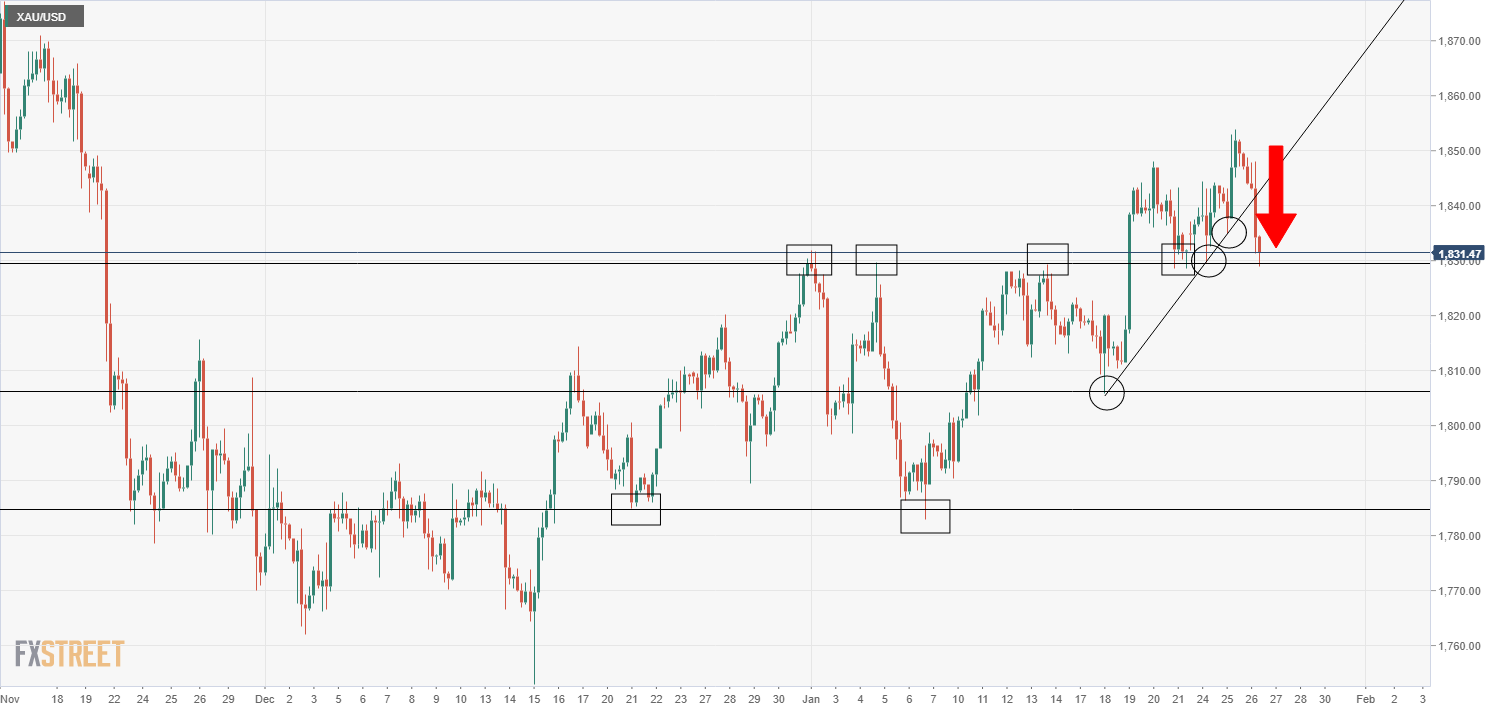
Moving on to the pre-Fed profit-taking; gold has been performing well in recent weeks and is up more than 2.5% from its lows in the $1780 area printed back on the first day of the year. That solid run of recent gains has come despite a US dollar that has been strengthening (over the last two weeks, anyway) and US bond yields, which have remained well support close to multi-month/year highs. The run higher this year in US bond yields (the 10-year is more than 25bps higher on the year already) has come amid increased bets on Fed hawkishness, something that would normally hit gold.
However, sharp equity market downside (since the start of the year) and geopolitical tensions appear to have infused gold with some safe-haven demand. But that doesn’t mean Fed tightening isn't still a threat to gold and it seems as though on Wednesday, traders were eager to book some profit on long XAU/USD positions just in case the Fed hits markets with a hawkish surprise (which would likely be gold negative). In a scenario where a hawkish surprise sends the US dollar and yields surging, key areas of support to watch for gold include last week’s low in the $1805 area, then the annual low just above $1780. In a bullish gold scenario, Tuesday’s highs just above $1850 would be the key resistance to watch.
Jerome Powell, Chairman of the Federal Reserve System, will be delivering his remarks on the monetary policy outlook at a press conference following the meeting of the Board of Governors. Powell's speech will start at 19:30 GMT.
Follow our live coverage of the Fed's policy announcements and the market reaction.
Related articles
Federal Reserve Interest Rate Decision Preview: Inflation, Omicron and equities.
Fed January Preview: Three possible scenarios for gold.
Fed Preview: Three ways Powell could out-dove markets, dealing a blow to the dollar.
About Jerome Powell (via Federalreserve.gov)
Jerome H. Powell took office as Chairman of the Board of Governors of the Federal Reserve System on February 5, 2018, for a four-year term. Mr. Powell also serves as Chairman of the Federal Open Market Committee, the System's principal monetary policymaking body. Mr. Powell has served as a member of the Board of Governors since taking office on May 25, 2012, to fill an unexpired term. He was reappointed to the Board and sworn in on June 16, 2014, for a term ending January 31, 2028.
- The shared currency edges low, amid a risk-on market mood ahead of the Fed.
- EUR/USD is downward biased though upside risks remain if the Fed fails to deliver a hawkish statement and could expose resistance levels at 1.1314 and 1.1398.
- A hawkish Fed statement could expose support levels at 1.1263 and 1.1186.
The shared currency remains slightly down, subdued ahead of the Federal Reserve unveiling of its first monetary policy statement of 2022. At the time of writing is trading at 1.1292, losing 0.11%.
A risk-on market mood prevails ahead of the FOMC, as shown by US equities rising between 0.90% and 2.56%. It appears that investors put the eastern Europe crisis on the side as they get ready for the Fed.
In the meantime, the US Dollar Index, which measures the greenback’s value against a basket of its rivals, advances some 0.12%, clings to 96.06, as the Fed looms. Furthermore, the US 10-year Treasury yield is flat, around 1.77%.
EUR/USD Price Forecast: Technical outlook
In the early stages of Wednesday’s Asian session, the EUR/USD was subdued in a 5-pip narrow range, within t.1300-05. When European traders got to their desks, the 1.1300 figure gave way for USD bulls ahead of the Fed, sending the pair tumbling to 1.1271.
That said, the EUR/USD daily chart depicts the pair as downward biased. The 50-day moving average (DMA) at 1.1314 is the first resistance level and would be under pressure when the Fed releases its monetary policy statement. IF that level is breached, the next resistance would be January 14 daily low previous support-turned-resistance at 1.1398, followed by a downslope trendline drawn from November 2021 cycle highs that pass around the 1.1435-50 area.
On the flip side, the pair’s first support would be January 25 daily low at 1.1263. A break of that level would expose December’s 15, 2021, low at 1.1261, followed by 2021 yearly low at 1.1186, and then 1.0870.
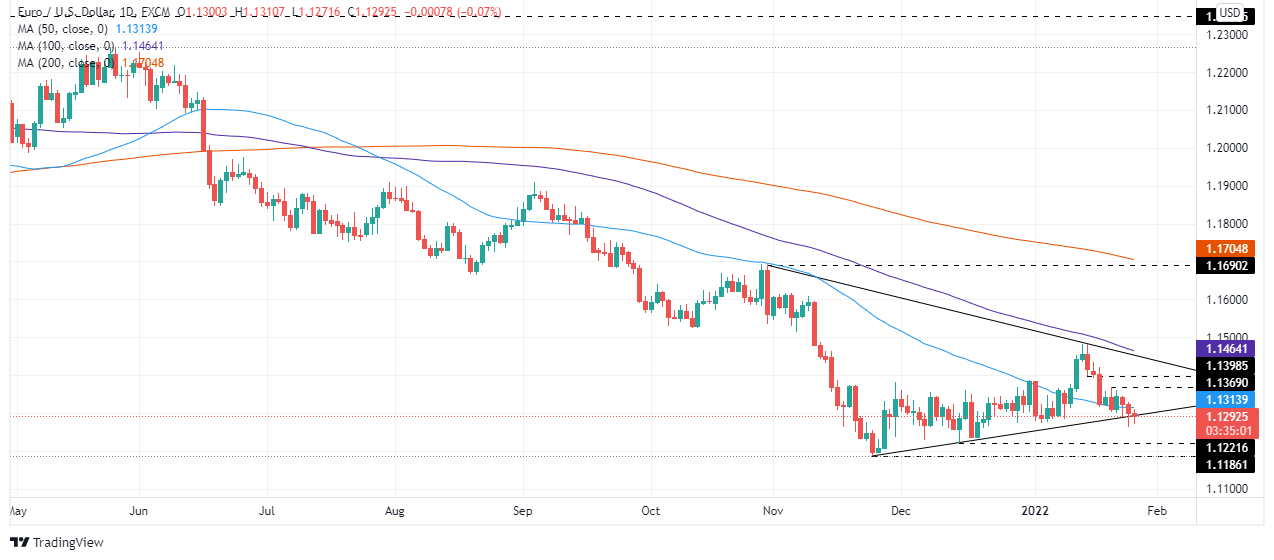
- AUD/USD bears are waiting in the wings of the Fed for a bullish outcome for the greenback.
- A fresh daily bearish impulse in AUD/USD could be in the making.
- However, a sell the fact outcome could play into the hands of the Aussie.
Trading near 0.7170, AUD/USD is firm ahead of the Federal Reserve at the top of the hour. The Aussie has benefitted this week from expectations of earlier domestic interest hikes, lower equity market volatility and a softer US dollar.
Since the start of the week, AUD/USD has climbed from a low of 0.7090 to a corrective high of 0.7177 in a technical move illustrated below. However, drivers from the geopolitical and central bank sentiments have underscored the bullish bias leading into today's showdown event in the Fed.
Risk sentiment improves ahead of Fed
Risk sentiment has improved on Wednesday with European stocks jumping. Eurostoxx50 was up 2.3% despite the Russia-Ukraine tensions that remain high. However, dialling down the angst, the Ukrainian Foreign Minister Dmytro Kuleba said Wednesday that Russia has not assembled sufficient forces to launch an imminent full-scale invasion of Ukraine.
This was in response to the Russian Foreign Minister Sergey Lavrov threatening "appropriate response measures" if the West continues its "aggressive line." Nevertheless, markets are of the mind that Word war III is not imminent as the West has said it is not going to get drawn in militarily. Instead, any sanctions for any invasion of Ukraine would be financial and economic.
Rising geopolitical tensions around Russia and Ukraine have weighed on the global equities market, and high beta currencies such as the Aussie, with the S&P 500 index flirting with a correction twice this week. However, Wall Street's main indexes have climbed on Wednesday after two turbulent sessions and ahead of the outcome of a Federal Reserve policy meeting, with a stellar outlook from Microsoft boosting technology stocks.
The US dollar has subsequently held below a 2-1/2 week high as risk sentiment stabilized hours before policymakers at the Federal Reserve are widely expected to indicate their readiness to start raising interest rates starting in March.
Nevertheless, the DXY is up for the third straight day and trading around 96.087 a the time of writing. The 2022 high near 96.462 is close but charts suggest an eventual test of the November high near 96.938, analysts at Brown Brothers Harriman argued.
''The dollar is mostly higher today, which supports our view that the dollar remains in the unique position of gaining during periods of both risk-on and risk-off. When all is said and done, the US fundamental story remains solid, giving the Fed confidence to continue removing accommodation at an accelerated pace. This is ultimately dollar-positive.''
Meanwhile, analysts at TD Securities said in a note today that ''USD resilience should persist through the January FOMC meeting, particularly on the risk of an earlier QT start. Barring that, the dollar bloc seem best positioned to weather the storm given tightening is already priced in. ''
What to watch for at the Fed
''Chair Powell is likely to take the opportunity to prepare markets for liftoff,'' the analysts at TD Securities said.
''Any hints around the starting point for QT or "sooner" and "faster" on hikes could be market-moving. A March rate hike is almost fully priced in and the market is pencilling in nearly 4 hikes in 2022. Equity weakness could leave the Fed a bit concerned, but the Chair is likely to stress only gradual removal of accommodation.''
Meanwhile, the analysts at BBH warn of some possible “buy the rumour, sell the fact” price action after the decision.
''A very hawkish Fed is universally expected and if Powell and company deliver anything remotely cautious or dovish, there may be some knee-jerk profit-taking on the long dollar and short UST positions.''
''We advise investors to look through this price action and instead focus on the fundamental story. Given what we know about the US labour market and recent inflation trends, the underlying story remains dollar-positive,'' the analysts said.
AUD domestic drivers
AUD/USD has been finding some support from a bigger-than-expected drop in Australia’s unemployment in December (to 4.2%) and firm inflation data. Australia’s Core Consumer Prices surpassed the midpoint of the Reserve Bank’s 2-3% target for the first time since June 2014.
This lifted bond yields and narrowed the divergence between the US and AU rates. The surprise lifted expectations of earlier interest-rate hikes. Traders are trying to second guess whether these factors will see the Reserve Bank of Australia react to such improvements in data with a significant hawkish turn at the 1 February meeting.
AUD/USD technical analysis
As per the prior analysis, AUD/USD Price Analysis: Bulls going against the grain to M-formation neckline target, the price has move din on the target as follows:
AUD/USD prior analysis
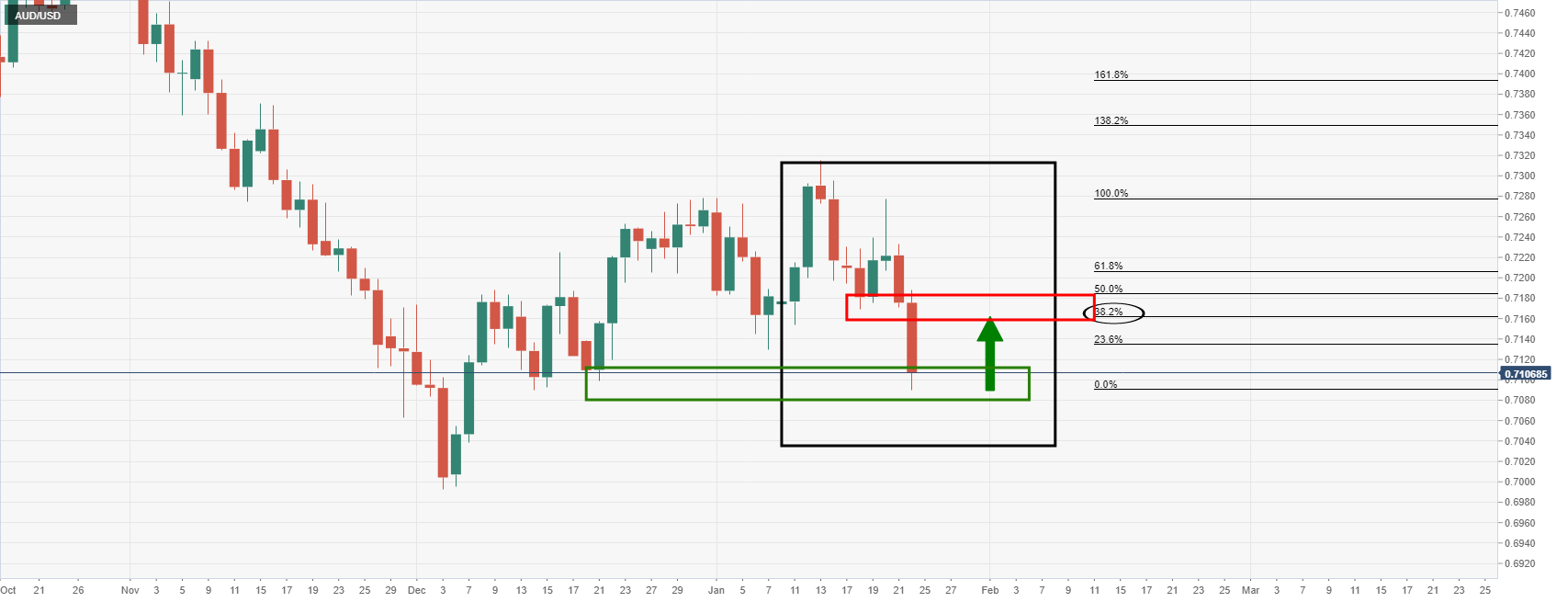
The M-formation was neckline was identified as a bullish target.
AUD/USD live market
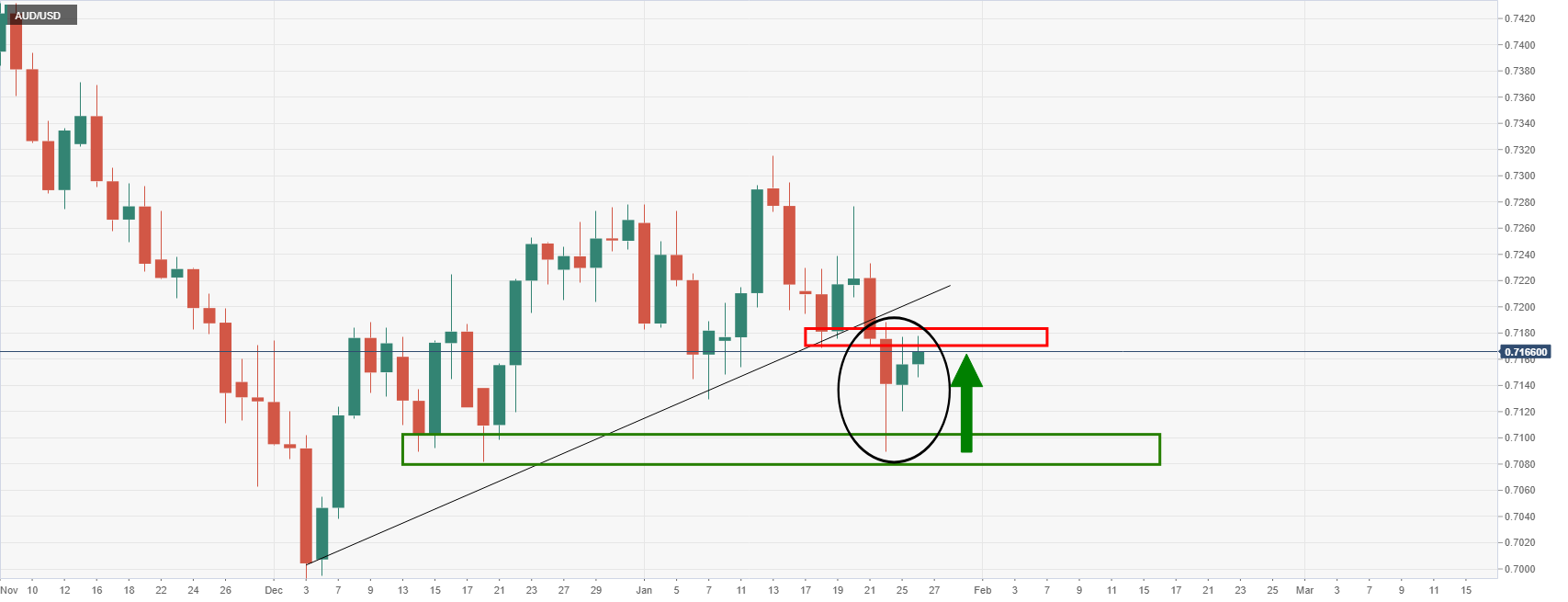
The neckline has been reached and traders will now wait to see what the outcome of the Fed entails for the currency markets.
AUD/USD levels to watch around Fed
In yesterday's approach to the target, from a lower time frame basis, the market structure and flight path were illustrated and forecasted as follows:

The price indeed moved in on the support before moving higher towards the M-formation's neckline:
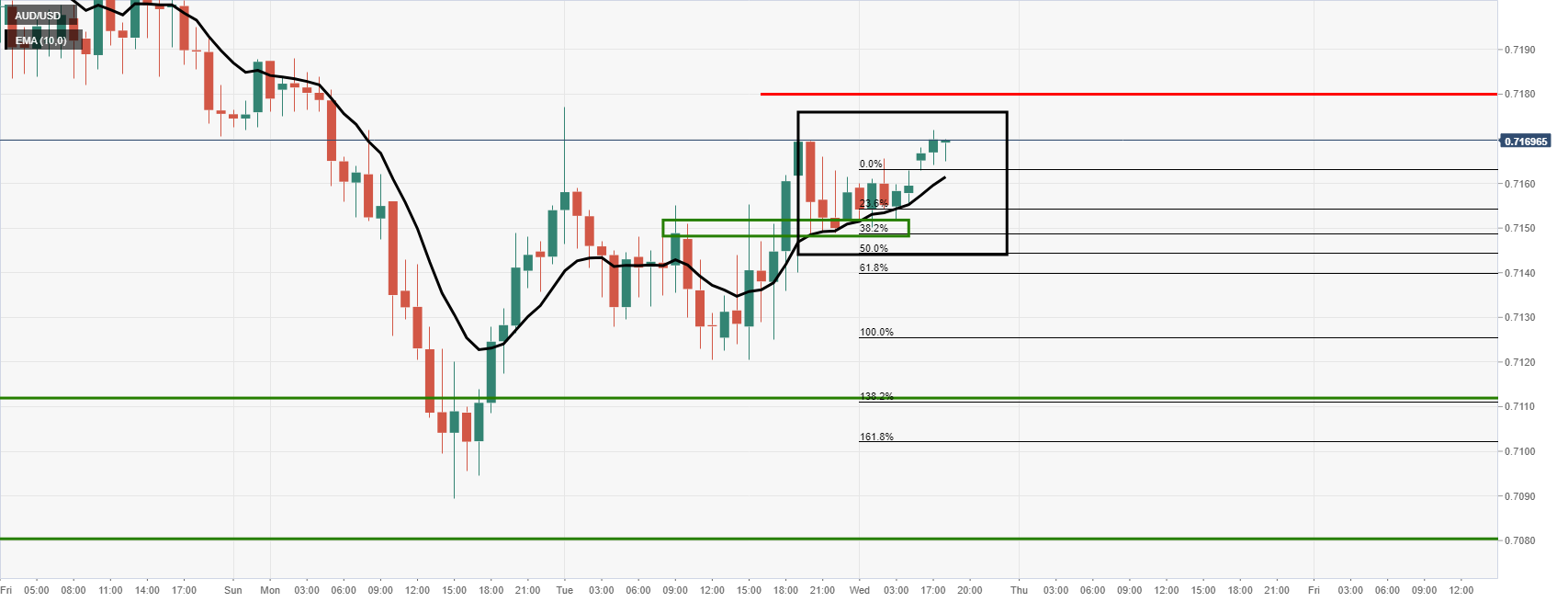
In doing so, 0.7180 is now only a handful of pips away. 0.7150 is key support heading into the Fed which aligns with the dynamic trendline support that protects 0.7120. A break of 0.7120 opens the risk of a significant breach of the lows near 0.7190 and then 0.7070 -272% Fibo. On the upside, a break of 0.7180 will open 0.7200, then 0.7220/30 as the last major resistance before 0.7250/80:
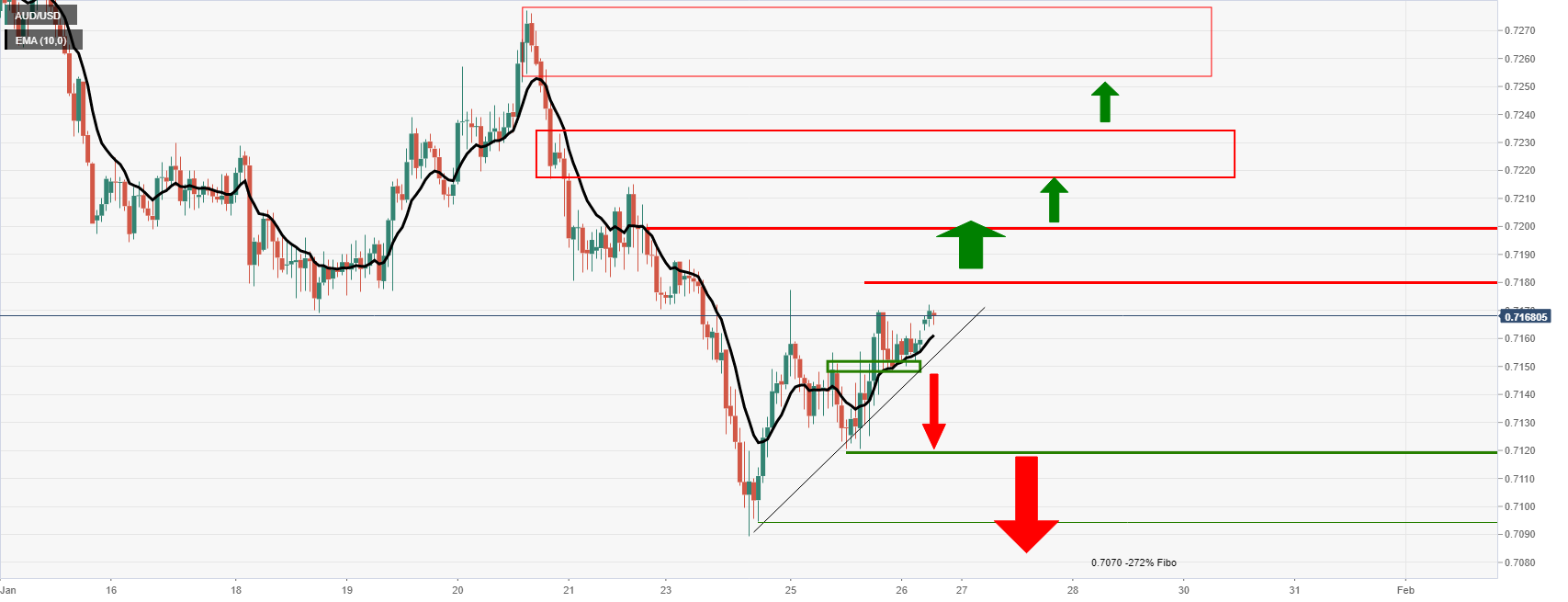
AUD/USD daily bearish outlook
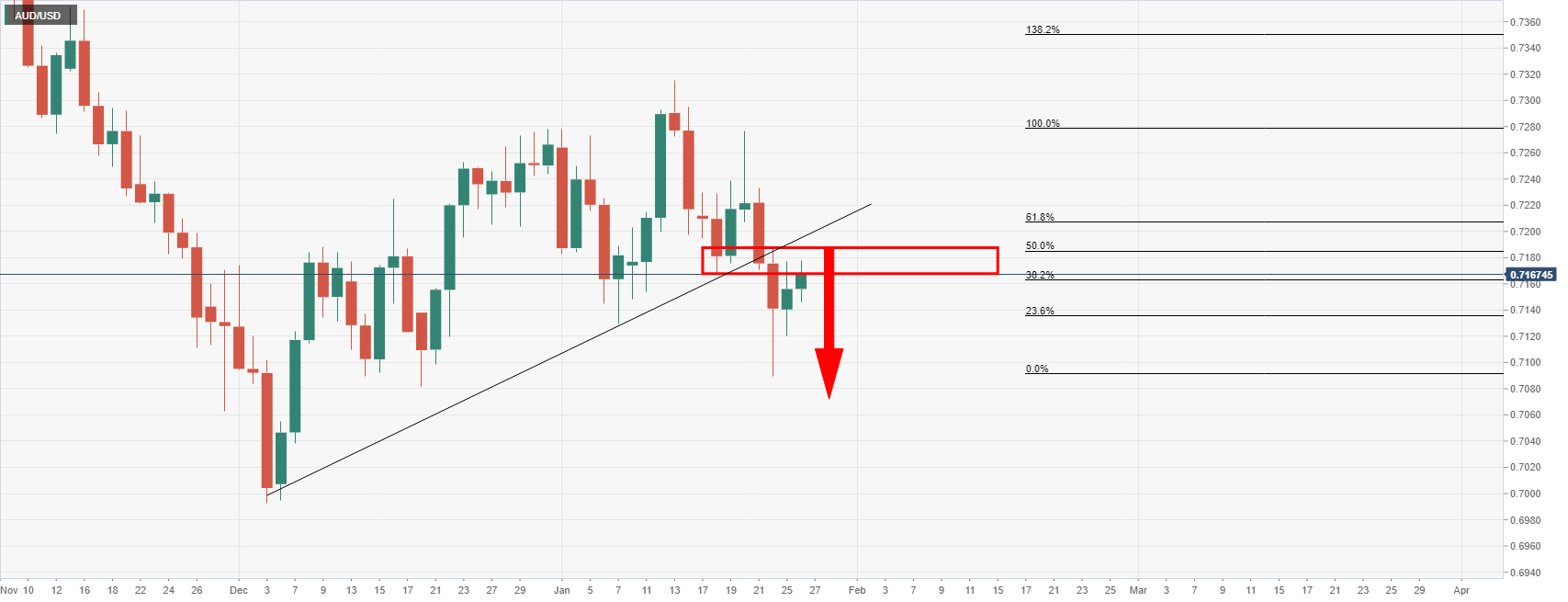
All in all, a bullish outcome for the US dollar would be expected to play out as a daily bearish continuation on the daily chart as illustrated above.
- The white metal extends its slide to four days in a row.
- Fed’s hawkish expectations weighed on silver, and any “dovish” signal could be viewed as an opportunity for XAG bulls.
- XAG/USD is downward biased, though upside risks remain due to the 200-DMA closing the spot price.
Silver (XAG/USD) slides for the fourth consecutive day, mainly attributed to monetary policy tightening expectations of the US central bank. At the time of writing, XAG/USD is trading at $23.79, down some 0.21%.
The market sentiment is upbeat, as portrayed by US equities trading higher. That alongside Fed policymakers signaling three rate hikes in 2022, amid the possibility of a fourth one, keep precious metals under pressure. At the same time, gold is plunging close to 1%, sitting at $1831,75, after reaching a daily high around $1,850, a $20 drop ahead of the release of the Fed monetary policy statement.
In the meantime, the US 10-year Treasury yield advances 0.5 basis points up to 1.783%, underpinning the greenback. The US Dollar Index, a gauge of the greenback’s performance against a basket of six peers, advances 0.18% sits at 96.118.
The consensus among some analysts cited by Bloomberg expects that Fed’s Chairman Jerome Powell will lay the groundwork for a March 2022 rate hike, at the same month that the Quantitative Easing (QE) ends. What keeps market participants nervous, as witnessed by the recent fall of the S&P close to 10%, is the Quantitative Tightening (QT) speed and when it will begin. Some investors expect it to kick in by the beginning of the second half of the year, others by the end, while the minority expects it to begin by June.
XAG/USD Price Forecast: Technical outlook
The non-yielding metal sits near the 50% Fibonacci retracement drawn from the last pivot low at $22.81 to the highest of the year at $24.70. Earlier in the session, it reached below of it, near the 61.8% Fibo level at $23.53, though it bounced back immediately.
Despite the aforementioned, silver is downward biased. On January 20, it faced strong resistance at the confluence of a downslope trendline and the 200-day moving average (DMA) around $24.70, but it was unable to break it, dropping $1.00 since then.
On the downside, the first support would be the 61.8% Fibo retracement at $23.53. A break under that level would open the door to the 78.6% Fibo level at $23.21 and then the January 18 cycle low at $22.82.
To the upside, the first resistance is the 38.2% Fibonacci retracement level at $23.98, unsuccessfully broken one time. The next supply zone would be the January 24 daily high at $24.31, followed by the abovementioned 200-DMA at $24.60.
- USD/CAD has slipped back to 1.2600 recently despite the BoC holding rates, as risk appetite/strong oil prices support CAD.
- BoC Governor Macklem’s press conference remarks didn’t move the loonie and attention is now on the upcoming Fed meeting.
After its initial post-BoC rate hold pop as high as the 1.2640s, USD/CAD has dropped back to the 1.2600 level and is back to trading lower by about 0.2% on the session. Whilst a minority of market participants/analysts had been expecting the central bank to hike interest rates by 25bps to 0.50% on Wednesday, explaining the initial post-policy announcement weakness, the loonie has remained underpinned by positive risk appetite and higher crude oil prices. The S&P 500 is currently trading about 1.5% higher on the day and is now trading in the green on the week, facilitating outperformance amongst the more risk-sensitive G10 currencies such as CAD. Meanwhile, WTI has surged nearly $2.0 and is only a whisker away from last week’s multi-year highs, supported by ongoing geopolitical (Russia/Ukraine/NATO) and OPEC+ supply concerns.
BoC Governor Tiff Macklem’s remarks in the post-meeting press conference did not seem to rock the boat much for the loonie. The governor explained the reason for holding off on a rate hike on Wednesday (Omicron weighing on the economy) and alluded to the need to raise interest rates and begin reducing the size of the balance sheet in the months ahead. Somewhat dovishly, he did emphasise that the rate hike path would not be automatic, with each hike to be taken on a meeting-by-meeting basis, and alluded to the possibility of a mid-hiking cycling pause if needed. But this doesn’t seem to have impacted longer-term expectations for the BoC rate path much.
With USD/CAD’s top on Wednesday confirming a downtrend from Monday’s highs, technicians may see the pair as having entered a short-term bearish trend. The bears may now be targetting a move back towards the 200-day moving average at 1.2500 and test of recent lows in the 1.2450 area. Should risk appetite continue to improve and crude oil prices continue to advance, USD/CAD’s short-term path should be downwards. One key event to watch on Wednesday is of course the upcoming Fed policy announcement; like the BoC, the Fed is expected to tee up rate hikes and QT in the coming months. FX markets could be volatile, having ignored US trade data earlier in the session that showed a larger than anticipated, monthly goods trade deficit in December of over $100B for the first time.
BoC Governor Tiff Macklem, in his post-monetary policy meeting and Monetary Policy Report release press conference, said that Wednesday's decision to hold interest rates was consistent with the bank's deliberate approach, before adding that the spread of Omicron is weighing on the economy.
Additional Remarks:
"Reopening the economy has proven complicated."
"We want monetary policy to be a source of confidence, not uncertainty."
"We are going to learn more about Omicron in the coming weeks."
"Confident inflation will come down because we are seeing evidence global supply chain issues are starting to be resolved."
"Rising rates will dampen demand growth and ensure domestic sources of inflation do not build up."
"Inflation is uncomfortably high."
"Rate hikes won't be automatic... we will take decisions at each meeting."
"Won't say how fast or how far rates will be going up."
"We might take a few steps, then pause the rate hiking path and assess progress."
In his post-BoC policy announcement/Monetary Policy Report release press conference on Wednesday, Governor Tiff Macklem said that interest rates will have to go up to counter inflation. Canadians should expect a rising path of interest rates, given the BoC is committed to bringing inflation back to target.
Additional Remarks:
"There is some uncertainty about how quickly inflation will come down because we’ve never experienced a pandemic like this before."
"Unevenness across sectors remains, but taking all the evidence together, the governing council judges the economy is now operating close to its capacity."
"Some evidence that supply disruptions may have peaked, but the spread of omicron is a new wildcard that could further disrupt global supply chains."
"We also considered the potential for some reversal of the large price increases for goods; this would pull inflation down more quickly than we forecast."
"Rising house prices and evident capacity pressures suggest that if demand continues to grow faster than supply this will put upward pressure on inflation."
"We were mindful that the rapid spread of omicron will dampen spending in the first quarter... so we decided to keep our policy rate unchanged today."
"Removing forward guidance is a significant shift in monetary policy, and we judged that it is appropriate to move forward in a deliberate series of steps."
"Bank will keep holdings of Canadian government bonds on our balance sheet roughly constant at least until we begin to raise the policy interest rate... at that time, we will consider exiting the reinvestment phase."
- Positive risk sentiment weighs on the Swiss franc, boosting the greenback.
- The US Dollar advances some 0.27% ahead of the release of the Fed monetary policy statement.
- USD/CHF is upward biased but faces strong resistance at the 100-DMA
The USD/CHF surges in the North American session reclaim the 0.9200 figure ahead of the FOMC monetary policy decision. At press time, the USD/CHF is trading at 0.9207.
Risk sentiment is positive, portrayed by European and US equities trading in the green, despite Ukraine and Russian tensions not easing. However, the expectations of a hawkish hold of the Federal Reserve keep USD bulls in charge of the pair.
USD/CHF Price Forecast: Technical outlook
In the Asian session, the USD/CHF remained subdued in a narrow range of 10-pips range, within 0.9170-80. However, as European traders got to their desks, USD bulls took control of the pair, propelling an upward move that reclaimed the 0.9200 figure.
From a technical perspective, the USD/CHF is neutral-upward biased. At press time, the pair faces strong resistance at the 100-day moving average (DMA) at 0.9211. A breach of that level would expose the January 11 daily high at 0.9278, followed by the confluence of a downslope trendline and December 15, 2021, around 0.9294-0.9305.
On the flip side, the USD/CHF first support would be 0.9200. If broken, the next support would be the 200-DMA at 0.9160, adding further downward pressure on the pair, sending it towards November 2, 2021, a daily low at 0.9085.
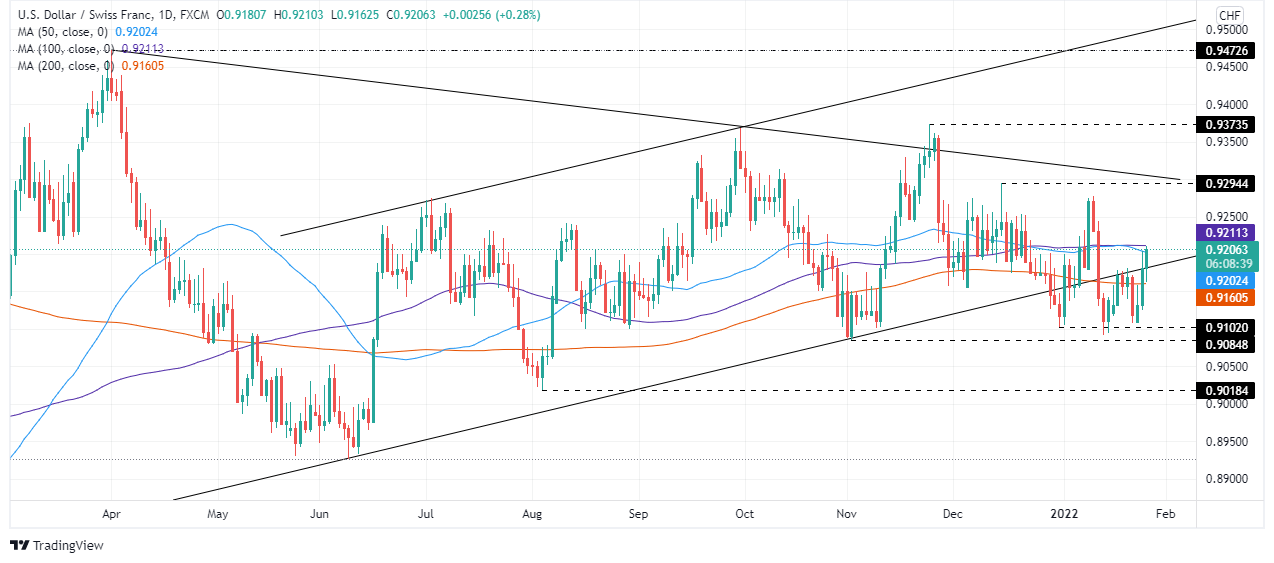
The Bank of Canada (BoC) held the overnight rate at 0.25% in January, in line with consensus. The CAD weakened following the decision. That said, a hawkish hold alongside what economists at TD Securities think will be a bit of a relief risk rally still leaves the loonie better placed for now.
Rate hikes will be coming soon
“The Bank of Canada held the overnight rate at 0.25% in January, in line with consensus, although markets were pricing a much higher probability of liftoff. The Bank also provided strong signal for a March hike by noting that economic slack has been absorbed.”
“We look for the Bank to hike by 25 bps at its next meeting.”
“We think it is difficult to fade the CAD with a central bank set to hike. That said, with how the curve is priced, we are cognisant that any additional gains will eventually be grounds for lightening up on longs.”
“Near-term, we are biased to a relief rally following a terrible start in equities this year. That should benefit the CAD.”
- The British pound slides in the New York session, some 0.10%.
- Market sentiment improvement since the Asian session underpins FX risk-sensitive currencies.
- GBP/USD is downward biased, but a Fed dovish hold could send the pair towards 1.3600.
As the New York session begins, the British pound slides for the second day in the week, ahead of the Fed monetary policy statement release. At the time of writing, the GBP/USD is trading at 1.3496.
Risk sentiment is upbeat, as portrayed by European stock indices in the green, and US equity futures point to a higher open. However, the Ukraine – Russia crisis looms. Despite investors’ good mood, market participants should be aware of geopolitical and central bank news crossing the wires.
UK's political domestic issues and a hawkish Fed weigh on the GBP
That, alongside domestic political issues spurred by the so-called “party gate” in No. 10 Downing Street, would dent the prospects of the GBP. Angela Rayner, Labour’s deputy leader, said that Conservative MP’s should stop propping the current PM, adding that he “should finally do the decent thing and resign.”
An absent UK economic docket leaves GBP/USD investors leaning on the greenback dynamics.
In the meantime, GBP/USD traders would take cues of the FOMC monetary policy meeting. The expectations are for a hawkish hold, though forward guidance of hiking rates and how soon the Quantitative Tightening (QT) would begin. Being the Fed’s first monetary policy meeting of 2022, there would not be any Summary of Economic Projections (SEP).
The GBP/USD was subdued during the overnight session for North American traders, around the 1.3490-1.3523 range, ahead of the FOMC meeting. The break of the 100-day moving average (DMA) lying at 1.3530 accelerated the fall near the 50-DMA at 1.3419. However, on Tuesday, the pair bounced off those levels and closed above 1.3500.
GBP/USD Price Forecast: Technical outlook
The GBP/USD is downward biased, per the location of the daily moving averages (DMAs), with the shorter time-frame below the longer time ones. However, the fact that price action broke above the 50-DMA, which lies at 1.3419, suggests that the pair might be subject to buying pressure in the near term. Nevertheless, unless the GBP/USD breaks above the 100-DMA at 1.3530, then that would open the door for further gains.
The GBP/USD first resistance would be the latter mentioned. A break above that level would expose a downslope trendline around 1.3550-60, which would expose the 1.3600 figure once broken.
On the flip side, the first support would be January 25 daily low at 1.3436. A breach of the latter would send the pair tumbling to the 50-DMA at 1.3419, followed by the 1.3400 figure.
- USD/CAD surged back above 1.2600 after the BoC disappointed some hawkish bets by holding interest rates steady at 0.25%.
- But it was a hawkish hold, with the bank signaling rate hikes and QT will be coming soon.
- That, plus recovering risk appetite and higher oil prices may limit loonie losses.
USD/CAD surged from the 1.2560s to the 1.2630 area after the Bank of Canada on Wednesday opted to hold interest rates at 0.25%, disappointing calls from a minority of market participants and economists for a 25bps rate hike to 0.50%. Ahead of the meeting, a Bloomberg poll revealed that seven out of 31 analysts were looking for a 25bps rate hike, thus the pricing out of these hawkish bets seems behind the latest bout of loonie weakness. On the session, USD/CAD is now back to trading flat, having been as much as 0.5% lower prior to the policy announcement.
The BoC’s latest policy announcement can be characterised as a hawkish hold. The bank noted that overall slack in the economy had now been absorbed, satisfying the condition for future rate hikes and strongly hinting towards a hike at the next meeting in March. The bank then added that, at the time when interest rates start to rise, it will consider ending balance sheet reinvestments and ways to reduce the balance sheet’s overall size. In other words, while the BoC held off on hiking rates on Wednesday, it signaled that rate hikes and quantitative tightening will be coming very soon.
This might serve to limit loonie downside for the time being, with the BoC looking very likely to at the very least keep pace with the Fed when it comes to monetary tightening. Note also that the backdrop of recovering risk appetite (US stocks are advancing strongly and are now higher on the week) and stronger crude oil prices as geopolitical tensions bubble may combine to shield the risk/commodity-sensitive loonie from further downside. Technicians will note resistance in the 1.2700 area and support in the 1.2450 area as the key levels to keep an eye on.
The Bank of Canada announced on Wednesday that it was holding its overnight interest rate at 0.25%, as the majority of market participants had been expecting. Note that a minority had expected a 25bps rate hike to 0.50%. The bank also signaled that a rate hike would likely be coming in March by saying that overall slack in the economy had been absorbed, satisfying the conditions outlined in the bank's forward guidance for an interest rate hike.
Additional Takeaways as summarised by Reuters:
On rate hikes...
- Overall slack in the economy has been absorbed, satisfying the condition outlined in the bank’s forward guidance on its policy interest rate.
- The BoC has decided to end its extraordinary commitment to hold its policy rate at the effective lower bound.
- The BoC will use its monetary policy tools to ensure that higher near-term inflation expectations do not become embedded in ongoing inflation.
- The BoC expects interest rates will need to increase, with the timing and pace of those increases guided by the bank’s commitment to achieving the 2% inflation target.
On possible balance sheet reduction...
- BoC will keep its holdings of Canadian government bonds on its balance sheet roughly constant at least until it begins to raise the policy interest rate.
- It is continuing its reinvestment phase, keeping its overall holdings of Canadian government bonds roughly constant.
- At that time, the BoC will consider exiting the reinvestment phase and reducing the size of its balance sheet.
Economic/financial commentary...
- Financial conditions remain broadly accommodative but have tightened with growing expectations that monetary policy will normalize sooner than was anticipated
- The Omicron variant is weighing on activity in the first quarter.
Market Reaction
USD/CAD saw a positive reaction to reflect loonie weakness after the BoC disappointed a minority of market participants by not opting to surprise with a 25bps rate hike on Wednesday, but rather signal a rate hike coming up at the next meeting. USD/CAD currently trades about 60 pips above its pre-BoC announcement levels. Given it was a hawkish hold, with the bank signalling rate hikes and quantitative tightening will be coming soon, the loonie's overall losses may be somewhat limited.
- Gold breaks under 1840$ and drops to the lowest in two days.
- US dollar remains mixed across the board as market participants await the FOMC statement.
- Wall Street opens in green, recovering from Tuesday’s slide.
Gold prices tumbled after the beginning of the American session. XAU/USD broke under 1840$ and quickly dropped to the 1830$ area, reaching the lowest level in two days. It remains under pressure ahead before the FOMC statement.
Probably technical factors weighed on the last leg lower in XAU/USD. The area around 1840$ offered support during several hours. Now the yellow metal is about to test the key $1830 support zone. A break lower would add more pressure, probably accelerating the decline. If XAU/USD holds above $1830, a rebound seems likely. The $1850 zone is the relevant resistance.
Market participants await the outcome of the FOMC meeting. The statement will be delivered at 19:00 GMT and could significantly impact gold prices. “A hawkish hold is widely expected as the Fed sets the market up for liftoff at the next meeting March 15-16. WIRP (Bloomberg World Interest Rate Probabilities) suggests a hike then is fully priced in, as are three more quarterly hikes this year. There won’t be any updated macro forecasts or Dot Plots for today’s decision, but we expect Chair Powell to send a very clear signal that the Fed is looking beyond recent stock market volatility and instead focusing on the tight labor market” explained analysts at Brown Brother Harriman.
“Markets will be keen to see any clues on how soon the Fed will allow balance sheet runoff. We had thought this would be a 2023 story, but given recent official comments and the Fed’s accelerated timeline, we believe runoff will begin in Q3”, said a BBH report. They warn of some possible “buy the rumor, sell the fact” price action after the decision that could send the dollar lower, and could benefit XAU/USD, particularly if the same behaviour takes place in the bond market.
Technical levels
- WTI hit highs for the week above $87.00 on Wednesday amid a risk appetite recovery and ongoing geopolitical concerns.
- Ahead, oil traders will be watching official US inventories, the Fed policy meeting, OPEC+ headlines and further geopolitical updates.
Front-month WTI futures hit fresh highs for the week above the $87.00 level on Wednesday, as a broad risk appetite recovery combined with ongoing geopolitical and OPEC+ supply concerns underpinned the price action. WTI is now nearly $4.50 or over 5.0% higher versus Monday’s lows near $82.00 per barrel and earlier in the session when prices surpassed the $87.00 mark, was only a whisker below last week’s multi-year highs at $87.90 per barrel. At current levels in the mid-$86.00s, WTI is trading higher by slightly more than $1.0 on the day.
“Anxiety over potential supply disruptions in the Middle East and Russia is providing bullish fodder for the oil market” said an analyst. “The market downside is limited due to heightened tensions between Russia and Ukraine and the threat to infrastructure in the UAE,” said another. To give context, tensions in Eastern Europe have escalated this week as Russia continues to amass troops near the Ukrainian border and as NATO has moved to beef up its Eastern European military presence. Some countries (like the UK) have been providing arms to Ukraine and most NATO/EU nations are threatening harsh economic sanctions should Russia invade Ukraine.
Some oil strategists have suggested that in a worst-case scenario where Russia did invade and Western powers took steps to sever the Russian economy off from the global market, sanctions on Russia energy exports could send oil prices well beyond the $100 per barrel mark. Meanwhile, tensions between the Saudi-led (sunni) coalition and regional Iran-backed (shia) militia groups have amped up over the past few weeks, with the Iran-backed Houthis in Yemen recently upping attacks on oil infrastructure in the UAE. Geopolitics is set to remain a key driver or oil prices in the days ahead, though oil traders would do well to watch how broad risk appetite is impacted by the Wednesday Fed policy announcement for any follow-through to oil prices.
OPEC+ headlines are also worth keeping an eye on, with the latest sources suggesting (as expected) that the cartel will stick to its plans to up production by another 400K barrels per day in March. The bigger theme for oil markets right now is whether smaller OPEC+ producers can actually keep up with these output hikes, which has not been the case in recent months. Oil traders should also keep an eye on the latest official weekly US EIA crude oil inventory figures out at 1530GMT. The weekly private API inventory report showed a slightly larger than expected draw of 0.9M barrels.
- DXY keeps the buying interest unchanged near 96.00.
- US yields remain vigilant ahead of the FOMC event.
- Consensus expects the Fed’s message to fall on the hawkish side.
The US Dollar Index (DXY), which gauges the greenback vs. a bundle of its main rivals, extends the weekly optimism around the 96.00 zone ahead of the FOMC gathering midweek.
US Dollar Index: Mind the “sell the fact” reaction
The index keeps the rebound from 2022 lows (January 14) well in place, this time aided by the mild uptick in US yields and sustained further by escalating geopolitical tensions.
Indeed, the recent strong advance in the dollar was accompanied by rising speculation of a Fed’s lift-off in March along with an intense move higher in US yields. However, much of the next steps by the Fed seems to be priced in and therefore this could spark a corrective move in the buck in case the Committee (or Powell) fails to surprise investors later on Wednesday.
In the docket, MBA Mortgage Applications contracted 7.1% in the week to January 21, while advanced trade balance figures showed the deficit is expected to widen to $101B in December.
Next on tap in the US calendar will be the December New Home Sales along with the EIA’s weekly report on US crude oil stockpiles.
US Dollar Index relevant levels
Now, the index is gaining 0.10% at 96.05 and a break above 96.27 (weekly high Jan.27) would open the door to 96.46 (2022 high Jan.4) and finally 96.93 (2021 high Nov.24). On the flip side, the next down barrier emerges at 94.89 (100-day SMA) followed by 94.62 (2022 low Jan.14) and then 93.27 (monthly low Oct.28 2021).
EUR/USD remains capped above 1.13. Economists at Scotiabank expect the world’s most popular currency pair to suffer significant losses on a break under the 1.12 level.
Resistance is at 1.1300/10
“EUR/USD is now targeting yesterday’s low of 1.1263 – with some minor support holding around 1.1280. The currency now faces further losses if it breaks under the mid-figure zone that acts as the next support marker ahead of the 1.12 area.”
“Beyond the 1.12 area, losses could mount to 1.10.”
“Resistance is 1.1300/10 followed by the mid-1.13s.”
GBP/USD posts minor gain but struggles to extend through low 1.35s. Economists at Scotiabank believe that cable continues to paint a bearish picture and needs to surpass the 1.3550 mark to alleviate downside pressure.
Support is located at 1.3490/50
“The technical picture remains bearish but a push past 1.3550 initially and then 1.36 could more clearly negate downward pressure for it to settle back in its uptrend since mid-Dec.”
“Resistance is the 100-day MA at 1.3534 followed by the mid-1.35s and 1.3580/00.”
“Support is 1.3490/50 followed by 1.3440/50.”
USD/CAD has drifted back to 1.2570. Economists at Scotiabank expect the pair to give up a little more of last week’s rally and push towards 1.2500 on a Bank of Canada (BoC) rate hike.
Loonie to plummet on a dovish outcome
“We expect the BoC to raise the Overnight Target Rate 25bps today. The policy statement should point to additional hikes coming in relatively quick order as well. A hike and a hawkish-looking statement will drive the CAD higher.”
“In the event of a more dovish outcome, the CAD will fall quite sharply (depending on what sort of policy outlook the Bank describes in its statement), given what the swaps curve has already factored in for the BoC moving forward.”
“The CAD’s reaction may be somewhat muted as markets await the FOMC result this afternoon but we think a rate hike plus a policy statement/press conference which supports the outlook for a sustained tightening round will drive USD/CAD back to/below 1.25 in the near-term.”
See – BoC Preview: Forecasts from 10 major banks, to hike or not to hike?
- USD/TRY remains side-lined in the mid-13.00s so far.
- The upside stays capped by the 2022 high near 14.00.
- The FOMC meets and is seen delivering a hawkish message.
Price action around USD/TRY became dull since the start of the year, keeping the trade within the 13.00 and 14.00 levels so far.
USD/TRY vigilant on FOMC, geopolitics
The consolidative phase around USD/TRY seems to have been reinforced after the Turkish central bank (CBRT) left the One-Week Repo Rate unchanged at 14.00% at its January meeting.
Moving forward, investors are now expected to closely follow the geopolitical developments coming from the Russia-Ukraine front and its implications on crude oil, as Turkey is a major energy importer.
In the domestic camp, and seconding inflation jitters, market participants stay wary of the advance (or absence of it) of the FX-protected lira deposits announced by the Erdogan government in late December to tackle the incipient currency crisis.
Later in the NA session, the FOMC is seen keeping the Fed Funds Target Range unchanged, although consensus among investors keep pointing to a hawkish message from the Committee, which carries the potential to put the EM FX space under extra pressure ultimately.
What to look for around TRY
The pair keeps the multi-session consolidative theme well in place, always within the 13.00-14.00 range. The range bound stance appears reinforced by the recent steady hand by the Turkish central bank, while skepticism keeps running high over the effectiveness of the recently announced plan to promote the de-dollarization of the economy. In the meantime, the reluctance of the CBRT to change the (collision?) course and the omnipresent political pressure to favour lower interest rates in the current context of rampant inflation and (very) negative real interest rates are forecast to keep the domestic currency under pressure for the time being.
Key events in Turkey this week: Economic Confidence Index (Friday).
Eminent issues on the back boiler: Progress (or lack of it) of the government’s new scheme oriented to support the lira via protected time deposits. Constant government pressure on the CBRT vs. bank’s credibility/independence. Bouts of geopolitical concerns. Much-needed structural reforms. Growth outlook vs. progress of the coronavirus pandemic. Earlier Presidential/Parliamentary elections?
USD/TRY key levels
So far, the pair is advancing 0.90% at 13.5575 and a drop below 12.7523 (2022 low Jan.3) would expose 10.2027 (monthly low Dec.23) and finally 9.8304 (200-day SMA). On the other hand, the next up barrier lines up at 13.9319 (2022 high Jan.10) followed by 18.2582 (all-time high Dec.20) and then 19.0000 (round level).
- NZD/USD is in wait-and-see mode just under 0.6700 ahead of the Fed policy announcement and key NZ CPI data.
- Some have warned that the US dollar might see some post-Fed profit-taking selling/a “sell the fact” reaction.
With FX markets having entered their typical pre-Fed policy announcement lull and the US dollar thus rangebound below recent highs, NZD/USD has been able to stabilise just below the 0.6700 level, comfortably above earlier weekly lows in the 0.6660 region. A slight improvement in the YoY rate of New Zealand Credit Card Spending growth to 1.2% in December from -0.4% in November, as revealed by data during the Asia Pacific session, didn’t trigger any notable FX market reaction. Nor did the latest US trade balance figures, despite the monthly trade deficit posting a surprise increase to nearly $101B in December versus expectations for a drop to $96.1B from $98.04B in November.
US dollar traders are unsurprisingly keeping their powder dry with the Fed expected to give the green light to multiple rate hikes in 2022 and offer up some more information on potential quantitative tightening plans. New Zealand markets also await the release of highly important domestic data during the early hours of the Thursday Asia Pacific session, with the Q4 2021 Consumer Price Inflation report due at 2145GMT. NZD has been unable to benefit from RBNZ hawkishness in recent months, with the bank hiking rates by 25bps on two occasions since October and expected to implement further hikes in 2022. But some might still hope that, should Thursday’s CPI data surprise to the upside, there might be room for hawkish RBNZ bets to bolster the kiwi.
Ultimately though, NZD/USD fate will most likely be determined for the rest of this week by USD flows and risk appetite, both of which have been mostly bearish for the pair in recent sessions. Indeed, NZD/USD fell under 0.6700 this week for the first time since November 2020 and, from a technical perspective, the door is open for a grind lower to the next key area of support near 0.6500. Some have warned that the US dollar might see some post-Fed profit-taking selling/a “sell the fact” reaction, which could offer some support to the pair and help it reclaim the 0.6700 handle.
BoC Monetary Policy Decision – Overview
The Bank of Canada (BoC) is scheduled to announce its monetary policy decision this Wednesday at 15:00 GMT. The Canadian central bank is expected to leave its benchmark interest rate unchanged at 0.2%. That said, some market participants anticipate an imminent start of the tightening cycle in January amid a surge in Canada’s annual inflation rate to a three-decade high in December. Apart from the policy decision, the accompanying policy statement and the post-meeting press conference will be looked upon for clues about the central bank's policy outlook.
Analysts at NBF offered their take on the upcoming policy decision and explained: “We are officially moving our call for the first Bank of Canada interest rate hike from March to January. That said, unlike other forecasters, we don’t see the BOS or December CPI report as having materially changed the policy trajectory for the rest of the year. Thus, we remain confident in our call for 5 interest rate hikes in 2022, with the overnight target hitting 1.50% by year-end.”
How Could it Affect USD/CAD?
Heading into the key event risk, bullish crude oil prices acted as a tailwind for the commodity-linked loonie and dragged the USD/CAD pair back closer to mid-1.2500s. A surprise rate hike should not come as a surprise, though should be enough to provide a goodish lift to the Canadian dollar and set the stage for an extension of this week's slide from the 1.2700 mark.
Conversely, a less hawkish tilt could lend some support to the major. That said, any immediate market reaction is likely to remain limited as the focus would then shift to the outcome of a two-day FOMC meeting, scheduled to be announced later during the US session. Nevertheless, the announcement should infuse some volatility and produce some meaningful trading opportunities around the pair.
Key Notes
• Bank of Canada Rate Decision Preview: No surprises for a 25bps rate hike
• BoC Preview: Forecasts from 10 major banks, to hike or not to hike?
• USD/CAD Analysis: 200-DMA/1.2500 mark holds the key, focus remains on BoC/FOMC
About the BoC Interest Rate Decision
BoC Interest Rate Decision is announced by the Bank of Canada. If the BoC is hawkish about the inflationary outlook of the economy and raises the interest rates it is positive, or bullish, for the CAD. Likewise, if the BoC has a dovish view on the Canadian economy and keeps the ongoing interest rate, or cuts the interest rate it is seen as negative, or bearish.
- A combination of supporting factors assisted AUD/USD to gain positive traction on Wednesday.
- RBA rate hike bets, the risk-on impulse in the markets benefitted the perceived riskier aussie.
- Hawkish Fed expectations acted as a tailwind for the USD and might cap gains ahead of FOMC.
The AUD/USD pair extended its steady intraday ascent and climbed to a fresh daily high, around the 0.7175 region heading into the North American session.
The pair attracted fresh buying on Wednesday and is now looking to build on this week's recovery move from the 0.7090 support area, or a one-month low. The Australian dollar was underpinned by rising bets for an earlier interest rate hike by the Reserve Bank of Australia, boosted by Tuesday's stronger domestic CPI report. Apart from this, a strong recovery in the global risk sentiment – as depicted by a generally positive tone around the equity markets – further benefitted the perceived riskier aussie.
On the other hand, the US dollar continued drawing support from expectations that the Fed will tighten its monetary policy at a faster pace than anticipated. In fact, investors now seem convinced about the prospects for an eventual Fed lift-off in March and have been pricing in a total of four rate hikes in 2022. This, in turn, might hold back traders from placing aggressive bullish bets and cap gains for the AUD/USD pair heading into the key event risk – the outcome of a two-day FOMC policy meeting.
The Fed is scheduled to announce its decision later during the US session and investors will look for clues about the likely timing of when the US central bank will commence its policy tightening cycle. This will play a key role in influencing the near-term USD price dynamics and provide some meaningful impetus to the AUD/USD pair. Apart from this, the broader market risk sentiment should further infuse some volatility across the FX markets during the latter part of the trading on Wednesday.
Technical levels to watch
- EUR/GBP recently slipped back under 0.8350 amid the ongoing rebound in US equities and macro risk appetite.
- Central bank divergence also continues to weigh while the pound remains resilient to political uncertainty.
EUR/GBP has been nudging back lower on Wednesday and recently dipped under the 0.8350 level, nearly 1.0% below Monday’s highs in the 0.8420 area and down a further 0.3% on the day. Macro sentiment has been unusually choppy this week with large swings seen in US equity markets. But sentiment is on a firmer footing this morning with S&P 500 futures about 1.4% up on the day to back in the green on the week and up about 4.5% versus earlier weekly lows ahead of Wednesday’s Fed meeting. This recovery in sentiment in stocks markets is translating into outperformance of risk-sensitive currencies in the G10 FX space, such as GBP.
Couple the recovery in risk appetite with ongoing bets that the ECB will lag the BoE by a substantial margin when it comes to monetary policy normalisation and it perhaps unsurprising to see EUR/GBP come under pressure. All signs, including recent upside inflation and labour market data surprises and business surveys that have highlighted inflationary/tight labour market concerns, point to the BoE hiking interest rates again next week (to 0.5% from 0.25%). Indeed, the British public’s 12-month inflation expectation hit a record high of 4.8% in January according to the latest YouGov/Citi poll. Citi economists said the data “suggest elevated risk inflation expectations could become de-anchored to the upside as inflation accelerates in the months ahead”.
Contrast that with remarks from ECB policymaker and Lithuanian Central Bank Governor Gediminas Simkus on Wednesday. He reiterated the central bank’s central viewpoint/stance that the inflation outlook is not a reason to change the path of policy and that there is no evidence of the need for a significant change to the bank’s forecasts. EUR/GBP bears are thus likely to remain confident in their forecasts that late-2019/early-2020 lows in the 0.8280s are will be hit sooner or later, as sterling continues to shrug off domestic political risk.
For reference, UK PM Boris Johnson appears on the verge of losing his job as the “partygate” scandal escalates (London police are now investigating Downing Street lockdown breaches). Much will depend on the highly anticipated Sue Gray report, which will be handed to the PM on Wednesday and apparently will not be good news for the PM. “While most Tory MPs have pledged to wait for the result of the investigations before moving to vote out Johnson, there now appears more consensus that the PM's tenure is close to its end,” said analysts at ING. “Chancellor Rishi Sunak is currently seen as the most likely candidate to take over the role as PM”. “Given no obvious implications for the UK economy or the Brexit stance for the moment, any change at the helm of the government should have a limited impact on the pound” they add.
EUR/USD has been pivoting around the 1.13 level since mid-November. In the view of economists at Rabobank, it is likely that the direction of the pair in the short term will be taken from the tone adopted by Fed Chair Powell in his post FOMC meeting press conference today.
Current long USD positions will continue to leave EUR/USD vulnerable to pullbacks
“Given the recent volatility in stocks and concerns about the impact of tighter Fed policy on EM, there is some speculation in the market that Powell could soften his tone today and that the FOMC could throw its weight behind 3 rather than 4 rate rises this year. This outcome would likely undermine USD sentiment and trigger another push higher in EUR/USD.”
“Overall, current long USD positions will continue to leave EUR/USD vulnerable to pullbacks. However, given the continued divergence in Fed and ECB policy in addition to the potential support to the USD from safe-haven flows, we would favour selling rallies in EUR/USD with the view that the USD can strengthen further into the middle of the year.”
See – Fed Preview: Forecasts from 14 major banks, building a March hike
Before testing $1,850, gold seems to have lost its bullish momentum, with investors remaining on the sidelines ahead of the US Federal Reserve’s policy announcements on Wednesday, January 26. FXStreet’s Eren Sengezer highlights gold’s technical levels to watch for depending on the Fed’s policy outlook.
A hawkish Fed policy outlook could cap gold's upside
“The yellow metal is facing static resistance at $1,850. A dovish Fed should lift XAU/USD above that level and open the door for an extended rally toward $1,870, where the October-December uptrend ended.”
“On the flip side, $1,830 (Fibonacci 23.6% retracement) aligns as first technical support. With a daily close below that level on a hawkish Fed policy outlook, gold could slide toward $1,810 (Fibonacci 38.2% retracement, 100-day SMA) and $1,800 (200-day SMA).”
See – Gold Price Forecast: XAU/USD has to do more to prove it is ready to soar higher – DBS Bank
- Spot gold has eased back into the mid-$1840s after hitting fresh multi-month highs above $1850 on Tuesday.
- Gold traders look ahead to Wednesday’s Fed meeting as a key upcoming risk event, whilst geopolitics are also eyed.
After breaking out to fresh two-month highs to the north of the $1850 level on Tuesday, spot gold (XAU/USD) prices have on Wednesday eased back to the mid-$1840s as gold bulls book some profit ahead of the Fed policy announcement. Gold has surprised some analysts recently given its resilience in recent days to an advancing US dollar (the DXY hit fresh multi-week highs on Tuesday). Analysts say the buck has been benefitting from a combination of hawkish Fed expectations ahead of Wednesday’s meeting where the bank is anticipated to greenlight multiple 2022 rate hikes (starting in March) and prompt quantitative tightening, as well as safe-haven demand.
Typically, hawkish Fed expectations plus a stronger dollar would be a bearish combination for spot gold but the precious metal has nonetheless maintained broadly positive momentum since its early 2022 dip below $1800. Technically speaking, the picture is bullish, with prices having found solid support at the resistance turned support $1830 area multiple times in recent sessions and in a pattern of posting consistently higher highs and higher lows. XAU/USD is above all of its major daily moving averages (21, 50 and 200) and all three pointing higher and conditions are still not nearly in “overbought” territory (according to the 14-day Relative Strength Index in the low 60s). That suggests the scope for longs to continue to build remains strong and bulls will still likely be targetting a test of Q4 2021 highs in the $1870s.
If there is a “sell the fact” reaction to Wednesday’s Fed meeting that sees the US dollar weaken amid profit-taking and/or any further weakness in US bond yields amid safe-haven demand, gold could continue pressing higher. The increasingly tense geopolitical situation in Eastern Europe between NATO/Ukraine/Russia has been cited by some as gold positive, not just because of generalised safe-haven demand, but also given any conflict would likely prove inflationary if it puts strong further upwards pressure on global energy prices. That may be bolstering gold as market participants seek inflation protection and is an important theme to watch.
- A combination of supporting factors assisted USD/JPY to regain positive traction on Wednesday.
- A strong recovery in the risk sentiment undermined the safe-haven JPY and extended support.
- Fed rate hike bets acted as a tailwind for the USD and also contributed to the ongoing move up.
- The focus remains on the outcome of a two-day FOMC meeting, due later during the US session.
The USD/JPY pair maintained its bid tone heading into the North American session and was last seen trading around the 114.20 region, or a near one-week high.
Following the previous day's two-way/directionless price moves, the USD/JPY pair caught fresh bids on Thursday and built on this week's recovery from the 113.45 region, or a two-month low. This marked the second day of a positive move for the USD/JPY pair in the previous three sessions and was sponsored by a combination of supporting factors.
Despite rising geopolitical risks, a strong recovery in the global risk sentiment – as depicted by a generally positive tone around the equity markets – undermined the safe-haven Japanese yen. Apart from this, modest US dollar strength extended additional support to the USD/JPY pair and remained supportive of the positive momentum.
The greenback continued drawing support from expectations that the Fed will tighten its monetary policy at a faster pace than anticipated. In fact, the markets have fully priced in a lift-off in March and expect a total of four hikes in 2022. This acted as a tailwind for elevated US Treasury bond yields and underpinned the buck.
It, however, remains to be seen if bulls are able to hold the upper hand or opt to lighten their bets ahead of the key event risk – the outcome of a two-day FOMC meeting. Investors will look for clues about the likely timing of when the Fed will commence its tightening cycle, which should provide a fresh directional impetus to the USD/JPY pair.
Technical levels to watch
- USD/CAD witnessed fresh selling on Wednesday and extended this week’s slide from the 1.2700 mark.
- Bullish crude oil prices, BoC rate hike bets underpinned the loonie and exerted downward pressure.
- Hawkish Fed expectations acted as a tailwind for the USD, though did little to stall the intraday decline.
The USD/CAD pair continued losing ground through the mid-European session and dropped to a two-day low, around the 1.2560 region in the last hour.
Following the previous day's good two-way price move, the USD/CAD pair came under renewed selling pressure on Thursday and extended this week's rejection slide from the 1.2700 mark. Anxiety over a potential supply disruption amid geopolitical tensions in Ukraine and the Middle East pushed crude oil prices back closer to a multi-year high touched earlier this January. This, in turn, underpinned the commodity-linked loonie and exerted downward pressure on the major.
The Canadian dollar was further supported by expectations that the Bank of Canada (BoC) could hike interest on Wednesday amid a jump in domestic inflation to a three-decade high in December. Bulls seemed rather unimpressed by modest US dollar strength, bolstered by the prospects for a faster policy tightening by the Fed. In fact, the markets seem convinced that the Fed will begin raising rates in March and have been pricing in a total of four hikes in 2022.
Hence, the market focus will remain on the key central bank event risks – the BoC monetary policy decision and the outcome of a two-day FOMC meeting. Apart from this, fresh developments surrounding the Russia-Ukraine tension will influence oil price dynamics and provide some meaningful impetus to the USD/CAD pair. Hence, it remains to be seen if the ongoing downfall marks the end of the recent bounce from the 1.2445 area, or is seen as a buying opportunity.
Technical levels to watch
- EUR/USD extends the bearish note for the third straight session.
- Below YTD lows emerges the December 2021 low near 1.1220.
EUR/USD remains well under pressure and trades at shouting distance from recent 2022 lows near 1.1260.
The bias appears tilted to a deeper pullback in the very near term. That said, the next support of note is now seen at the December 2021 low at 1.1221 (December 15) ahead of the 2021 low at 1.1186 (November 24).
The longer term negative outlook for EUR/USD is seen unchanged while below the key 200-day SMA at 1.1704.
EUR/USD daily chart
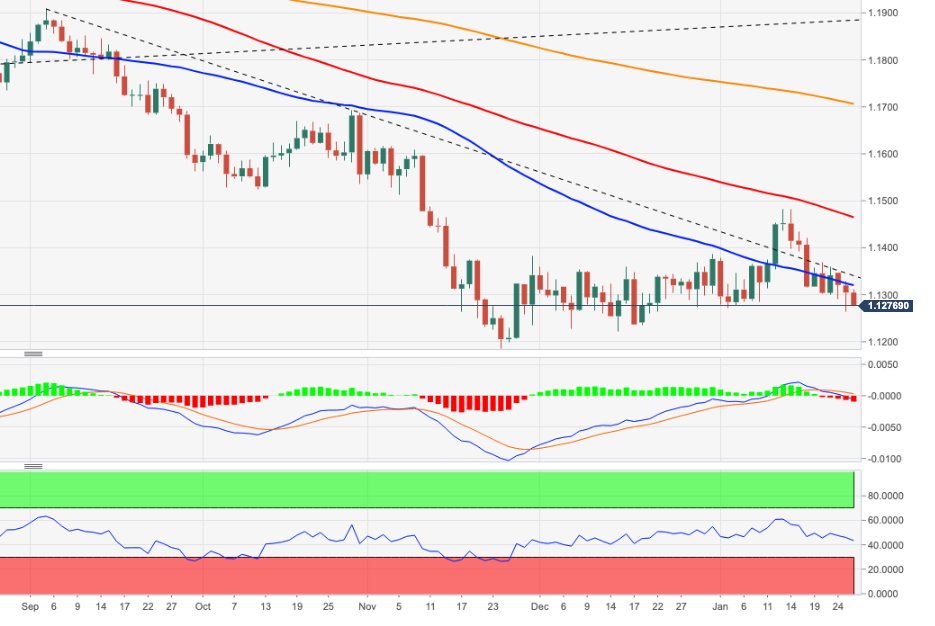
Barnabas Gan, Economist at UOB Group, assesses the recent unscheduled monetary policy meeting by the MAS.
Key Takeaways
“In an off-cycle monetary policy meeting (25 Jan), the Monetary Authority of Singapore (MAS) raised the S$NEER policy slope ‘slightly’, while keeping the width of the policy band and the level at which it is centred unchanged. We estimate that the current appreciation gradient of the band is now at 1.0%, up from 0.5% before today’s announcement.”
“We think that the off-schedule meeting … is in response to the elevated inflation risks in Singapore. According to the policy statement, policymakers cited that the outlook for Singapore’s inflation has shifted higher since Oct 2021, led by ‘recovering global demand and persistent supply-side frictions.”
“For the scheduled Apr 2022 monetary policy meeting, it is a ‘live’ decision and we expect the MAS to further steepen the S$NEER gradient ‘slightly’. This is estimated to bring the policy band gradient to an appreciation of 1.5% then. That said, there will also be a material risk for added tightening by policymakers via a recentring of the policy mid-point, given that the S$NEER has already appreciated within the upper half of the policy band since Oct 2021’s policy meeting.”
- DXY adds to the recent upside beyond the 96.00 yardstick.
- The 2022 peak at 96.46 emerges as the next key target.
DXY pushes higher and clinches the third consecutive daily advance amidst intentions to stabilize at/above the 96.00 zone on Wednesday.
The intense upside in the dollar has recently surpassed the 4-month line, today near 95.40, allowing for the continuation of the rebound in the short-term horizon. That said, the door now remains open to a potential assault of the so far 2022 top at 96.46 (January 4).
Looking at the broader picture, the longer-term positive stance in the dollar remains unchanged above the 200-day SMA at 93.29.
DXY daily chart
UOB Group’s Economist Ho Woei Chen, CFA, comments on the 2021 GDP figures in South Korea.
Key Takeaways
“South Korea’s 4Q21 GDP growth was in line with consensus and our forecast at 4.1% y/y, 1.1% q/q seasonally-adjusted as it maintained a steady recovery. The South Korean economy recovered by 4.0% in 2021 from a contraction of 0.9% in 2020.”
“We see robust external demand (in particular for technology products), gradual recovery in private consumption as well as government support measures to keep South Korea’s growth at an average of 3.0% in 2022, in line with Bank of Korea (BOK)’s and our forecasts.”
“The robust economic backdrop and higher inflation suggest that the BOK will proceed with its monetary policy tightening this year. We maintain our forecast for another 50 bps interest rate hike to 1.75% by end-2022 given the hawkish posturing, likely with 25 bps each in 2Q and 3Q.”
In its recently published annual economic report, Germany's economy ministry said that they lowered the 2022 GDP growth forecast to 3.6% from the October estimate of 4.1%, as reported by Reuters.
Additional takeaways
"German government expects 2022 GDP growth to be solely driven by domestic demand, local investments."
"German government expects consumer price inflation to accelerate to 3.3% in 2022 from 3.1% in 2021."
"German government expects higher wage demands in 2022 but sees no signs of wage-price-spiral so far."
Market reaction
The EUR/USD pair continues to edge lower during the European trading hours and was last seen losing 0.17% on the day at 1.1280.
- EUR/JPY bounces off recent lows in the 128.20 region on Wednesday.
- The cross could still attempt a move to the December 2021 low (127.50).
EUR/JPY seems to have met some dip buyers in the 128.20 region (January 25).
Price action in the cross keeps signalling a scenario of lower prices for the time being. Indeed, EUR/JPY accelerated the losses following the convincing breakdown of the key 200-day SMA (130.50) in past sessions, opening the door to a potential drop to the December 2021 low near 127.50 (December 3).
While below the 200-day SMA, the outlook for the cross is expected to remain negative.
EUR/JPY daily chart
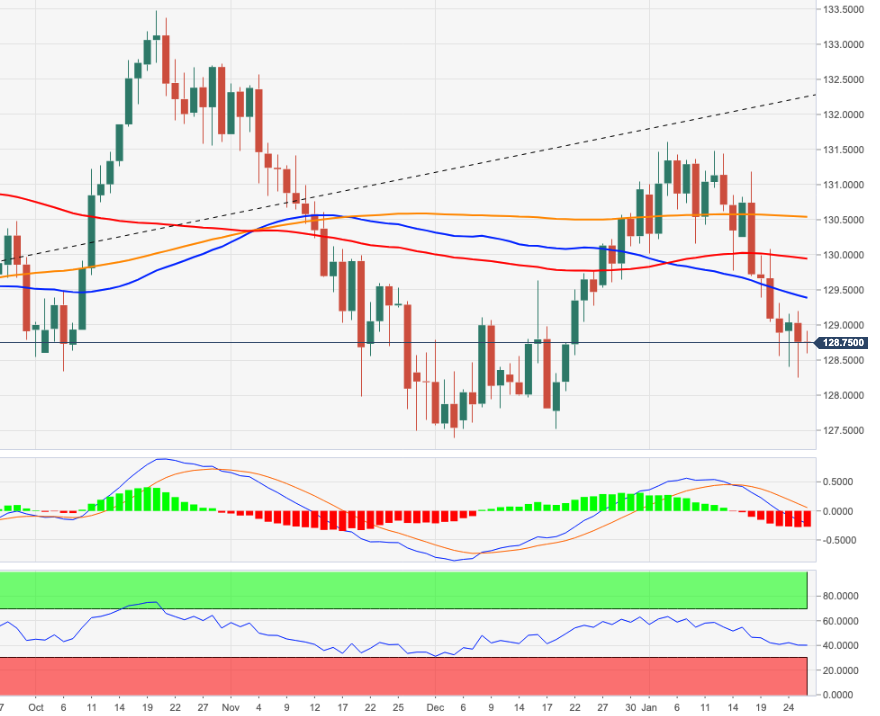
Economist at UOB Group Lee Sue Ann reviews the latest inflation figures in the Australian economy.
Key Takeaways
“Headline CPI surged in 4Q21. More importantly, core CPI surpassed the midpoint of the Reserve Bank of Australia (RBA)’s 2-3% target for the first time since June 2014.”
“The 1 Feb RBA meeting will take on a greater significance, given the scheduled review of the bond buying programme. We now think the RBA will decide to cease bond purchases altogether at the Feb meeting.”
“We still look for rate hikes only in 4Q23, though we now flag the potential risk for that to occur earlier than our projection.”
- GBP/USD gained some positive traction on Wednesday and built on the overnight recovery move.
- Rising bets for additional BoE rate hikes extended some support to the British pound and the pair.
- The UK political crisis capped any meaningful upside as investors await the FOMC policy decision.
The GBP/USD pair traded with a positive bias through the first half of the European session and was last seen hovering just a few pips above the 1.3500 psychological mark.
The pair built on the previous day's recovery move from the vicinity of the monthly low, around the 1.3435 region and edged higher for the second successive day on Wednesday. The uptick, however, lacked any fundamental catalyst and could be solely attributed to some repositioning trade ahead of the key central bank event risk.
The Fed is scheduled to announce its policy decision later during the US session and investors will look for clues about the timing of when the US central bank will commence its policy tightening cycle. It is worth recalling that the markets have fully priced in an eventual Fed lift-off in March and expect a total of four hikes in 2022.
Hence, the outcome will play a key role in influencing the near-term US dollar price dynamics and provide a fresh directional impetus to the GBP/USD pair. In the meantime, expectations that the Bank of England will hike interest rates further at the upcoming meeting turned out to be a key factor that extended some support to the British pound.
That said, the recent political developments in the United Kingdom held back traders from placing aggressive bullish bets around the GBP/USD pair and capped gains. In fact, British Prime Minister Borish Johnson has been facing calls to resign amid public anger over a series of alleged lockdown-busting parties in Downing Street.
Even from the technical perspective, bulls, so far, have struggled to lift the GBP/USD pair back above the 100-day SMA support breakpoint, around the 1.3520 region. This further makes it prudent to wait for a strong follow-through buying before confirming that the corrective pullback from the 1.3750 area or a two-month high has run its course.
Technical levels to watch
Analysts at Goldman Sachs remain upbeat on the global equity markets, despite the recent correction, citing that “markets have reached "danger zone" levels yet.”
“While it has not reached danger zone levels that typically precede a bear market (a fall of at least 20%), it has reached levels which have typically been consistent with corrections and relatively low returns over the next one and five years.” Goldman Sachs noted.
Related reads
- Tesla Stock Price and Forecast: TSLA earnings preview
- The Nasdaq is pulling back and retesting its lows
- A combination of factors dragged gold away from over two-month high touched on Tuesday.
- A recovery in the risk sentiment, Fed rate hike bets acted as a headwind for the commodity.
- Rising geopolitical tensions helped limit the downside ahead of the FOMC policy decision.
Gold witnessed some selling on Wednesday and moved further away from the highest level since November 19, around the $1,854 region touched in the previous day. The XAU/USD remained depressed through the first half of the European session and was last seen flirting with the daily low, near the $1,845 zone.
The pullback could be attributed to some repositioning trade ahead of the key central bank event risk – the outcome of a two-day FOMC policy meeting. It is worth recalling that the markets have fully priced in an eventual Fed lift-off in March and expect a total of four hikes in 2022. Hence, investors will look for fresh clues over the likely timing of when the US central bank will commence its policy tightening cycle. This, in turn, will play a key role in determining the next leg of a directional move for the non-yielding gold.
In the meantime, elevated US Treasury bond yields and expectations for a faster policy tightening by the Fed continued underpinning the US dollar. This, in turn, was seen as a key factor that acted as a headwind for the dollar-denominated gold. Apart from this, a strong recovery in the global risk sentiment – as depicted by a generally positive tone around the equity markets – drove flows away from the safe-haven precious metal. The downside, however, seems cushioned amid concerns about geopolitical tensions over Ukraine.
In the latest developments, the United States put 8,500 troops on alert to be ready to deploy in case of an armed conflict. Moreover, President Joe Biden said that he would consider personal sanctions on President Vladimir Putin, while Britain urged its European allies to have sanctions ready if Russia invades Ukraine. This, in turn, might hold back traders from placing aggressive bearish bets and help limit losses for gold.
Technical outlook
From a technical perspective, the emergence of some dip-buying near the $1,830 horizontal resistance breakpoint supports prospects for additional near-term gains. Hence, a subsequent strength towards testing a downward-sloping trend-line extending from June 2021 swing high, currently around the $1,860 region, remains a distinct possibility. A convincing breakthrough would be seen as a fresh trigger for bullish traders and pave the way for an extension of the recent move up witnessed over the past one month or so.
On the flip side, any meaningful slide might still be seen as a buying opportunity near the $1,830 region. A convincing break below might prompt some technical selling and accelerate the fall towards the $1,812 zone. This is followed by the very important 200-day SMA, currently around the $1,805 region and an upward sloping trend-line support, extending from August 2021 swing low, currently around the $1,797 region. Some follow-through selling will negate the near-term positive bias and turn gold vulnerable.
Gold daily chart
-637787870277717071.png)
Levels to watch
GBP/USD seems to have stabilized around 1.3500 early Wednesday. But in the view of FXStreet’s Eren Sengezer, it is too early to say that the pair has gone into a recovery phase.
Markets eye FOMC's January policy announcements
“If FOMC Chairman Jerome Powell notes that they could start shrinking the balance sheet in the second half of the year instead of ‘toward the end of the year’ this could have a bullish impact on the dollar and weigh on GBP/USD. On the other hand, Powell might adopt a cautious tone on policy tightening and cause the dollar to face renewed selling pressure. In that case, GBP/USD should extend its rebound, at least in the near-term.”
“On the downside, 1.3460 (200-period SMA, Fibonacci 50% of the latest uptrend) aligns as first support ahead of 1.3410 (Fibonacci 61.8% retracement).”
“Resistances are located at 1.3530 (Fibonacci 38.2% retracement) and 1.3580 (50-period SMA, 100-period SMA).”
See – Fed Preview: Forecasts from 14 major banks, building a March hike
European Central Bank (ECB) Governing Council member and Lithuanian Central Bank Governor Gediminas Simkus said on Wednesday, warned that Europe’s economy could face ‘huge’ economic loss if tensions escalate further between Russia and Ukraine, per Bloomberg.
Key quotes
“The situation adds uncertainty; if it escalates, it will obviously have an impact on our economies, on the Lithuanian economy, on the euro-area economy.”
“We, Europe and the others need to find, a decision leading to de-escalation, as further escalation means huge loss, and not only in terms of economic wealth but also losses in terms of lives.”
“We’re dealing with something that we call undeclared sanctions” and need help from European partners to respond.”
“It’s of crucial importance to have a single and uniform answer to this threat that Lithuania has experienced.”
Market reaction
EUR/USD was last seen trading at 1.1285, down 0.10% on the day, as the US dollar catches a fresh bid amid a rebound in the US Treasury yields. All eyes on the Fed decision.
FX option expiries for January 26 NY cut at 10:00 Eastern Time, via DTCC, can be found below.
- EUR/USD: EUR amounts
- 1.1225 1.2b
- 1.1300 539m
- 1.1350 548m
- 1.1440 482m
- 1.1500 1.1b
- GBP/USD: GBP amounts
- 1.3650 309m
- AUD/USD: AUD amounts
- 0.7350 680m
- EUR/GBP: EUR amounts
- 0.8325 360m
- 0.8400 389m
- 0.8440 299m
The delegates of OPEC and its allies (OPEC+) are likely to adhere to its plan of a modest hike in oil output, Bloomberg reports, citing sources with knowledge of the matter.
This comes as markets expect the Ukraine crisis to have a limited impact on the oil and gas flows.
- Energy flows unlikely to be significantly impacted from Russia-Ukraine crisis – Goldman Sachs
Market reaction
WTI is extending the previous rebound above $85.50, adding 0.52% on the day.
USD/CNH could still give away some ground and retest the 6.3180 level in the next weeks, noted UOB Group’s FX Strategists.
Key Quotes
24-hour view: “We expected USD to ‘trade between 6.3240 and 6.3430’ yesterday. USD subsequently traded within a narrower range than expected (6.3288/6.3385). Despite the quiet price actions, the underlying tone has softened and USD is likely to edge lower. That said, the major support at 6.3180 is unlikely to come under threat (there is another support at 6.3240). Resistance is at 6.3350 followed by 6.3400.”
Next 1-3 weeks: “There is not much to add to our update from yesterday (25 Jan, spot at 6.3300). As highlighted, downward momentum has not improved by much but USD could weaken further to 6.3180. However, a breach of 6.3500 (no change in ‘strong resistance’ level from yesterday) would indicate that the weak phase in USD that started more than a week ago has come to an end.”
- USD/JPY recaptures 114.00 amid resurgent US dollar demand.
- Markets expect Fed to shift to the hawkish pivot, hinting at a March rate hike.
- 50-DMA is the level to beat for bulls while above the critical support at 113.72.
USD/JPY is bouncing back above 114.00, having found fresh buyers once again near the 113.70 region.
The latest uptick in the major could be associated with the resurgent demand for the US dollar across the board, as investors prefer holding the buck heading into the Fed’s interest decision, the first of 2022 and expected to be a hawkish one.
The US central bank is likely to hint at a March rate hike while expressing concerns over hotter inflation. The Treasury yields are also attempting a comeback amid hawkish Fed expectations, adding to the upside in the major.
Markets have shifted their attention from the Russia-Ukraine crisis to the Fed verdict, as the risk sentiment remains elevated in European trading. The S&P 500 futures are up 0.88% on the day while the Euro Stoxx 50 Index is higher by 1.95% so far.
USD/JPY: Technical outlook
USD/JPY’s daily chart shows that the price has once again bounced from the two-month-old ascending trendline support at 113.72.
The rebound needs acceptance above the horizontal 50-Daily Moving Average (DMA) at 114.30 to confirm a meaningful recovery.
The next stop for bulls is seen at the January 20 highs of 114.54.
USD/JPY: Daily chart

The 14-day Relative Strength Index (RSI), however, remains below the 50.00 level, indicating that any bounce is likely to remain shallow.
Daily closing below the abovementioned key support of 113.72 will trigger a fresh downswing towards the bullish 100-Daily Moving Average (DMA) at 113.35.
That cap will be the line in the sand for the bullish traders.
USD/JPY: Additional levels to consider
- EUR/USD trades within a tight range around the 1.1300 zone.
- The FOMC is expected to strike a hawkish tone at its meeting.
- German 10y Bund auction, French labour market report next of note.
The single currency remains depressed for yet another session and puts EUR/USD under further pressure around the 1.1300 neighbourhood.
EUR/USD looks to Fed for direction
EUR/USD trades in the negative territory for the third session in a row on Wednesday amidst a broad-based cautious note ahead of the key FOMC event due later in the NA session.
The persevering offered stance in the pair comes in response to the continuation of the recovery in the dollar, although this trend seems to have been losing momentum in past hours against the backdrop of inconclusive direction in US yields.
The immediate catalyst for the pair’s price action comes from the FOMC meeting due later in the European evening, while geopolitical tensions stemming from the Russia-Ukraine conflict continues to drive the macro sentiment in the global markets.
In the domestic calendar, Consumer Confidence in France eased a tad to 99 in January, while Unemployment Benefit Claims are due later seconded by the German 10y Bund Auction.
Across the pond, weekly MBA Mortgage Applications are due followed by December’s flash Goods Trade Balance and New Home Sales.
What to look for around EUR
EUR/USD seems to have met a tough barrier in the area below 1.1500 in mid-January, sparking a corrective downside soon afterwards in tandem with the strong recovery in the greenback. Moving forward, there is not much optimism around the pair, particularly in light of the Fed’s imminent start of the tightening cycle vs. the accommodative-for-longer stance in the ECB, despite the high inflation in the euro area is not giving any things of cooling down for the time being. On another front, the unabated advance of the coronavirus pandemic remains as the exclusive factor to look at when it comes to economic growth prospects and investors’ morale in the region.
Key events in the euro area this week: Germany GfK Consumer Confidence (Thursday) – Germany Advanced Q4 GDP, EMU Final Consumer Confidence.
Eminent issues on the back boiler: Asymmetric economic recovery post-pandemic in the euro area. ECB stance/potential reaction to the persistent elevated inflation in the region. ECB tapering speculation/rate path. Italy elects President of the Republic in late January. Presidential elections in France in April.
EUR/USD levels to watch
So far, spot is losing 0.11% at 1.1288 and faces the next up barrier at 1.1369 (high Jan.20) seconded by 1.1464 (100-day SMA) and finally 1.1482 (2022 high Jan.14). On the other hand, a break below 1.1263 (2022 low Jan.25) would target 1.1221 (monthly low Dec.15 2021) en route to 1.1186 (2021 low Nov.24).
- USD/CHF gained traction and scaled higher for the third successive session on Wednesday.
- Stability in the equity markets undermined the safe-haven CHF and extended some support.
- Fed rate hike bets acted as a tailwind for the USD and remained supportive of the move up.
The USD/CHF pair inched back closer to a two-week high during the first half of the European session, with bulls making a fresh attempt to conquer the 0.9200 mark.
A combination of supporting factors assisted the pair to attract some dip-buying near the 0.9160 region on Wednesday and turn positive for the third successive day. Despite rising geopolitical risks, signs of stability in the equity markets undermined the safe-haven Swiss franc and extended some support to the major. Apart from this, the uptick was further supported by modest US dollar strength.
The USD held steady just below the highest level since January 10 touched on Tuesday and continued drawing support from the prospects for a faster policy tightening by the Fed. In fact, the markets seem convinced that the US central bank will begin raising interest rates in March and have been pricing in a total of four hikes in 2022 amid worries about stubbornly high inflationary pressures.
Hence, the focus will remain glued to the outcome of a two-day FOMC monetary policy meeting, scheduled to be announced later during the US session. Heading into the key central bank event risk, investors might refrain from placing aggressive directional bets. This, in turn, might turn out to be the only factor that might cap any meaningful upside for the USD/CHF pair, at least for the time being.
Hence, it will be prudent to wait for a sustained strength beyond the 0.9200 mark before positioning for an extension of this week's goodish rebound from the vicinity of the 0.9100 round figure. Nevertheless, the USD/CHF pair, so far, has managed to hold its neck comfortably above a technically significant 200-day SMA, which supports prospects for a further near-term appreciating move.
Technical levels to watch
The US Dollar Index (DXY) has rebounded after dipping towards interim support of 94.60/94.50 representing the peak of October and has reached its highest level in more than two weeks at 96.27. Economists at Société Générale note that a break above 96.50 would open up the 97.00 level and perhaps 97.45.
Failure to defend 95.25 can lead to continuation of down move
“DXY has crossed above a descending trend line which denotes possibility of further upside towards the peak formed earlier this month near 96.50. If this hurdle is overcome, the index can extend its uptrend towards 97.00 and perhaps even towards next projections at 97.45.”
“Failure to defend 95.25, the 61.8% retracement of the bounce can lead to continuation of down move.”
See: Ending the Fed’s QE may weigh on the US dollar – ING
The benchmark 10-year US Treasury bond yield continues to fluctuate between 1.75% and 1.8% after the up move has paused after facing resistance near 1.90% last week. However, economists at Société Générale expect to see further upside beyond the 1.90% mark towards the November 2019 peak of 1.97% and projections of 2.13%
A short-term pullback is not ruled out
“10Y UST has so far defended last October/November peaks of 1.69% which is first layer of support. A short-term pullback is not ruled out however neckline of the previous Inverted Head and Shoulders at 1.65%/1.62% should be a crucial level. Holding above this, the up move is expected to persist.”
“Beyond 1.90%, next objectives are located at November 2019 peak of 1.97% and projections of 2.13%.”
Economists at ING expect the Federal Reserve to announce the early termination of QE asset purchases today. Markets might read this as a sign that the Fed's focus is more on balance sheet management than tightening, ultimately pushing back bets on aggressive hikes and weighing on USD.
DXY to consolidate around the 96.00 level into the end of the week
“We expect the early termination of QE asset purchases to be announced today. This move may fuel speculation that the Fed may want to let the balance sheet reduction do the heavy lifting in the policy normalisation process, which could ultimately cause a dovish re-pricing of tightening expectations.”
“As the Fed-induced dollar strength relies on the market’s conviction around four hikes in 2022, we think that the balance of risks is skewed to the downside for the dollar today. That said, the predominance of geopolitical risk in the current market narrative and its impact on equity markets means that any post-Fed dollar weakness should not be particularly pronounced – appetite for the safe-haven dollar should remain high.”
“DXY may stabilise around the 96.00 level into the end of the week.”
See – Fed Preview: Forecasts from 14 major banks, building a March hike
The US Federal Reserve will announce its monetary policy decisions on Wednesday, January 26 at 19:00 GMT and as we get closer to the release time, here are the expectations as forecast by analysts and researchers of 14 major banks.
The Fed is widely expected to leave its policy rate unchanged in January. Current market expectations are for the Fed to keep its March bond terminus, hike rates 0.25% at that meeting and use balance sheet reductions, passive or active, as a hedge against future inflation.
Danske Bank
“We expect the Fed to indicate that the first-rate hike is likely in March if the economy develops in line with expectations, supported by the tight labour market and still very high inflation. It is one of the interim meetings without updated projections or dots. We have changed our Fed call now expecting four 25bp rate hikes this year (in March, June, September and December, up from three previously) and still four rate hikes in 2023. We expect the Fed to start reducing the balance sheet from September. Given the combination of a strong economy and high underlying inflation, we see risks as skewed towards more, not less, tightening. If this scenario plays out, the Fed is likely to hike 25bp at each meeting, not skipping interim meetings.”
Rabobank
“Recent testimony, speeches and interviews have made it clear that the FOMC is gung ho and ready to start hiking in March. Unless we see a setback in the real economy, we expect the Fed to hike each quarter this year. Balance sheet normalization is also likely to come soon. In fact, we expect May to be the first live meeting.”
TDS
“A likely hike in the funds rate in March has been well communicated, so a ‘prepare for liftoff’ signal should not surprise anyone. More important for markets will be any guidance on the likely pace of tightening, via QT as well as the funds rate, in the year/years ahead. We don’t expect definitive signals, unfortunately, and the result could be mixed messages. The chairman will likely talk about ‘normalization,’ consistent with making policy less accommodative rather than restrictive, but he will undoubtedly also express a willingness to move more aggressively if needed.”
ING
“We strongly suspect that we could see the announcement of the ending of QE asset purchases brought forward from the mid-March end-point currently signalled, to an immediate cessation. We also expect the Bank to indicate that March is the likely lift-off point for interest rates and confirm expectations that the balance sheet will start to be reduced later in the year. However, policymakers may note some caution on near-term activity relating to Omicron, which has seen consumer caution kick in while increased worker absences on health grounds are also set to have hit the economy hard in the December-January period. Nonetheless, Covid cases appear to have peaked and a swift economic rebound in February and March should allow the Bank to hike rates by 25bp on 16 March.”
RBC Economics
“We look for the Fed to raise rates soon, but a change is not expected at the January meeting.”
NBF
“With uncertainty and volatility already elevated, we don’t think the Fed will eliminate asset purchases altogether in January as the taper is already on cruise control to finish by March. However, with inflation continuing to surge and uneasiness growing, their stance is likely to remain hawkish. We expect them to prime markets for a policy rate increase as soon as March. There will be no new summary of economic projections published but we will get the usual post-decision press conference with Chair Powell.”
ANZ
“We are doubtful that the Fed will end QE as some in the market speculate. We are also doubtful that the Fed would begin to tighten policy with a 50bps rate rise. Markets may stabilise if the Fed is not as hawkish as some worst-case fears suggest. We do expect that Chair Powell will elaborate on quantitative tightening (QT) although it may be the case that no firm decision has yet been made. From a sequencing perspective, it may be too draconian to signal a near-term start to QT before QE has finished and rates have started to rise.”
Deutsche Bank
“This January meeting is set to be the last before they kick off that hiking cycle, with lift-off set to commence in March as part of the first of 4 hikes this year. However, we argue that there’s a tail risk of an even bigger hawkish surprise over the months ahead, with the possibility that the Fed raises rates in March and then goes onto raise rates 6 or 7 times this year. So maybe the calm before the storm. Also, watch out to see if the committee wants to outline more of their current QT plans. The Q&A could be a popcorn moment for the markets with plenty of questions likely on inflation, the Fed’s hiking path, financial conditions and QT amongst other things.”
CIBC
“The Fed will still keep rates on hold but might ramp up the rhetoric enough to make a March hike more likely than a wait for the meeting after that. A move in March would more readily open the door to four quarter-point hikes, rather than our last official projection for three, so stay tuned on that front. Clues on how quickly the Fed might transition to quantitative tightening after rate hikes commence likely won’t be available in the statement, but we’ll see if the subsequent press conference adds some colour.”
SocGen
“For the current meeting, no action is expected. The Fed is still cutting back on asset purchases and is not in a position to lift rates now. The Fed should complete its tapering and conclude asset purchases in February. It could stop tapering in January, but skipping the last purchases in February would not achieve much, and the Fed has positioned for rate lift-off in March either way. The interest now has shifted to any guidance on reducing the balance sheet. Fed Chair Powell may use the press conference to introduce guidance here, likely saying that Fed officials should be discussing balance sheet normalization at upcoming meetings. The Fed could make an announcement as early as June. The direction matters more than the incremental dollar amounts, and we expect the Fed to consider market and economic feedback on rate hikes before taking on balance sheet normalization.”
Wells Fargo
“We highly doubt the FOMC will start the tightening process and there will not be an update to the summary of economic projections. Instead, we expect Chair Powell to use the meeting to signal the fed funds rate could be lifted at its next meeting on March 15-16. Such a hint could come by indicating that the labor market is close to maximum employment, the remaining criteria the Committee has laid out for lift-off. We expect the statement and Chair Powell in his press conference to downplay the temporary slowdown in growth due to the most recent wave of the virus and highlight the overall strength of the labor market. Following a rate increase in March, we look for the FOMC to raise rates 25 bps per quarter through the third quarter of 2023, bringing the fed funds rate to 1.75%-2.00%. Any new clues regarding the details of balance sheet run-off will be important since several open questions remain regarding the timing, pace, and composition of the Fed's intended balance sheet reductions.”
Citibank
“Our base case is that the Fed will lift-off policy rates in March, hike four times in 2022 and begin balances sheet reduction in July. There are a number of items to watch this week – (1) possible signaling a March rate hike; (2) what about a 50bp first hike? – highly unlikely but Chair Powell and the committee probably will not rule it out; (3) Path of rate hikes; (4) timeline on stopping asset purchases; (5) timeline on balance sheet reduction; (6) No longer a ‘challenging time’ – it is hard to call a 3.9% unemployment rate a “challenging time” for the US economy. The Fed may remove this language in January or another upcoming meeting.”
ABN Amro
“The FOMC is widely expected to keep policy on hold. In light of the continued upside surprises in inflation, and a surge in wage growth, we expect the Committee to strongly signal in its policy statement that it is likely to implement a 25bp rate hike when it next meets in March. This would be consistent with comments from a range of FOMC members in recent weeks that have suggested they favour such a move. A March rate hike would be in line with our newly updated forecast for the Fed – we now expect four such hikes this year, with the risk tilted to an even steeper rise in rates. There could also be some suggestion in the statement that the balance sheet unwind will likely start soon after the end of asset purchases (our base case is May), though we do not expect a formal plan to be announced on this until March. In the press conference, we expect Chair Powell to be asked about the Committee’s current views of inflation risks, whether the Fed might hike at a more aggressive pace, and what the balance sheet unwind might entail. We expect him to strike a hawkish tone given the upside risks to inflation, with the recent weakness in equity markets unlikely to be enough to cause the Fed to change tack at this stage. Indeed, given that tighter financial conditions will likely be necessary for the Fed to bring inflation back under control in the US, we continue to think the bar will be much higher for the Fed to postpone rate hikes than in the past.”
Nordea
“We expect the FOMC to telegraph a rate hike in March. Powell will almost surely dismiss 50 bp. hike speculations. We do not expect any formal announcement on quantitative tightening (QT). Marginally tighter USD liquidity, as well as rate differentials, should support the USD.”
USD/JPY could slip back to the 113.00 zone in case 113.40 is breached, noted FX Strategists at UOB Group.
Key Quotes
24-hour view: “Our view from last Friday (21 Jan, spot at 113.90) still stands. As highlighted, while shorter-term downward momentum has improved, USD has to break 113.40 before a decline to 113.00 is likely. The chance for USD to break 113.40 is not high but it would remain intact as long as USD does not move above 114.45 (no change in ‘strong resistance level’).”
Next 1-3 weeks: “USD traded between 113.65 and 114.14 yesterday, slightly narrower than our expected sideway-trading range of 113.65/114.20. Despite the relatively quiet trading, the underlying tone appears to have weakened somewhat. While USD could dip below 113.60, the major support at 113.40 is unlikely to come under threat. Resistance is at 113.95 followed 114.15.”
- GBP/JPY gained some positive traction on Wednesday, though lacked strong follow-through.
- Signs of stability in the equity markets undermined the safe-haven JPY and extended support.
- BoE rate hike bets remained supportive; UK political crisis kept a lid on any meaningful gains.
The GBP/JPY cross traded with a mild positive bias through the early European session, with bulls now awaiting a sustained strength beyond the 154.00 round-figure mark.
Following the previous day's good two-way price moves, the GBP/JPY cross attracted some buying on Thursday and is now looking to build on this week's bounce from the very important 200-day SMA. Signs of stability in the financial markets – despite rising geopolitical risks – undermined the safe-haven Japanese yen and acted as a tailwind for the cross.
On the other hand, expectations that the Bank of England will hike interest rates further at the upcoming meeting extended some support to the British pound. This was seen as another factor lending some support to the GBP/JPY cross, though the recent political developments in the United Kingdom held back bulls from placing aggressive bets and capped gains.
In fact, British Prime Minister Borish Johnson has been facing calls to resign amid public anger over a series of alleged lockdown-busting parties in Downing Street. UK foreign minister Liz Truss said on Wednesday that the findings of an internal enquiry into allegations will be published soon, which might determine PM Johnson's future.
In the absence of any major market-moving economic releases from the UK, the fundamental backdrop warrants some caution for aggressive bullish traders. Hence, it will be prudent to wait for a strong follow-through buying before confirming that the GBP/JPY pair has bottomed out and positioning for any meaningful appreciating move in the near term.
Technical levels to watch
USD/CAD retreated to 1.2600 area as markets prepare for the Bank of Canada's rate decision. Economists at ING expect the BoC to hike rates by 25 bps, allowing the USD/CAD pair to challenge the 1.2500 support.
Bank of Canada set to hike today
“We expect the Bank of Canada to hike the policy rate by 25 bps today. A hike is around 70% priced in by the futures market, which implies some upside potential for the loonie if our call proves correct.”
“The combination of a CAD-positive BoC meeting and a USD-negative Fed meeting could send USD/CAD to re-test the 1.2500 support as early as today.”
“Any further escalations of geopolitical tensions and/or weakness in equities will clearly work against any CAD appreciation, although geographical distance and supported oil prices are reducing the loonie’s vulnerability compared to its European peers.”
See – BoC Preview: Forecasts from 10 major banks, to hike or not to hike?
EUR/USD has recovered modestly after dropping to fresh monthly lows. Nonetheless, bears are to remain in control as 1.1300 resistance stays intact, FXStreet’s Eren Sengezer reports.
Investors wait for the US Federal Reserve to announce its policy decisions
“The Fed is widely expected to leave its policy rate unchanged while confirming that the first-rate liftoff will happen in March. In case the Fed notes that every meeting will be live after March, this could be seen as a hawkish development and cause EUR/USD to come under renewed bearish pressure. On the other hand, a cautious stance by the FOMC could provide relief to US stocks and make it difficult for the dollar to find demand.”
“On the downside, 1.1270 (static level) aligns as the next bearish target ahead of 1.1250 (static level) and 1.1230 (static level).”
“Resistances are located at 1.1300 (psychological level), 1.1330 (200-period SMA) and 1.1350 (100-period SMA, 50-period SMA).”
- DXY adds small gains to Tuesday’s advance past the 96.00 barrier.
- US yields trade on a mixed performance so far on Tuesday.
- The FOMC meeting will be the salient event later in the NA session.
The greenback, when tracked by the US Dollar Index (DXY), extends the weekly recovery above 96.00 amidst the mixed tone in US yields and alternating risk appetite trends.
US Dollar Index remains focused on the Fed
The index trades with gains for the third session in a row on Wednesday, although the ongoing bullish stance in the dollar seems to have me a solid hurdle near 96.30, or weekly highs (January 25).
The positive momentum in the dollar comes amidst mixed performance of yields in the US cash markets, where the short end looks to extend the rebound vs. some consolidative mood seen in the belly and the long end of the curve.
The index, in the meantime, is expected to move within a range bound theme in light of the key FOMC meeting due later in the NA session. Despite a move on rates by the Fed is largely ruled out, investors expect the Committee to deliver a hawkish message and signal the start of the normalization phase as soon as at the March event. In addition, market participants will closely follow any mention regarding the balance sheet runoff.
In the US docket and other than the FOMC meeting, MBA will release its weekly report on Mortgage Applications seconded by advanced Goods Trade Balance and December New Home Sales.
What to look for around USD
The index started the week on a positive note and reclaimed the 96.00 barrier and above so far this week. In spite of consensus already pricing in a probable move on rates by the Fed at the March event, the constructive outlook for the greenback is expected to remain unchanged into this week and ahead of the FOMC event later in the session. Looking at the broader scenario, higher US yields, persistent elevated inflation, supportive Fedspeak and the solid pace of the US economic recovery should continue to underpin the buck in the months to come.
Key events in the US this week: Trade Balance, New Home Sales, FOMC Meeting, Powell’s Press Conference (Wednesday) – Durable Goods Orders, Advanced Q4 GDP, Initial Claims, Pending Home Sales (Thursday) – PCE, Personal Income/Spending, Final Consumer Sentiment (Friday).
Eminent issues on the back boiler: Fed’s rate path this year. US-China trade conflict under the Biden administration. Debt ceiling issue. Escalating geopolitical effervescence vs. Russia and China.
US Dollar Index relevant levels
Now, the index is gaining 0.08% at 96.03 and a break above 96.27 (weekly high Jan.25) would open the door to 96.46 (2022 high Jan.4) and finally 96.93 (2021 high Nov.24). On the flip side, the next down barrier emerges at 95.41 (low Jan.20) followed by 94.92 (100-day SMA) and then 94.62 (2022 low Jan.14).
The Bank of Canada (BoC) is set to announce its policy decision this Wednesday at 15:00 GMT and as we get closer to the release time, here are the expectations as forecast by the economists and researchers of 10 major banks, regarding the upcoming announcement.
The central bank is seen holding the overnight rate steady at 0.25%, although a surprise 25-basis points (bps) could not come as a surprise amid Canada’s multi-decade high inflation rate and robust labor market.
NBF
“We are officially moving our call for the first Bank of Canada interest rate hike from March to January. That said, unlike other forecasters, we don’t see the BOS or December CPI report as having materially changed the policy trajectory for the rest of the year. Thus, we remain confident in our call for 5 interest rate hikes in 2022, with the overnight target hitting 1.50% by year-end.”
Standard Chartered
“We now expect the BoC to raise its policy rate by 25bps to 0.5% amid soaring inflation readings and robust economic recovery. We expect the BoC to hike again in March and bring the end-2022 policy rate to 1.5% (1.25% prior). The hike is about 65% priced in, so markets could be modestly surprised. We doubt that the BoC will endorse the six hikes now priced in, but the CAD could strengthen a bit if the BoC signals a follow-up hike in March. BoC Governor Macklen may be worried enough about the run-up in inflation to indicate an intention to frontload hikes a bit to bring the policy rate closer to neutral. A clear signal that balance sheet shrinkage is likely to start in H1 would add support for the CAD.”
Scotiabank
“We look for rate lift-off with the benchmark rate expected to reach 2.0% this year. Markets remain reluctant to fully endorse a 1/4 point hike next week (swaps are pricing in around 17bps of a hike) but higher rates are coming sooner or later as the BoC responds to signs that inflation expectations are becoming unanchored.”
ING
“We now look for the BoC to raise interest rates 25bp at the 26 January meeting – the same day as the Fed. Activity is strong, the economy is at record employment and inflation is at 30-year highs. Covid containment measures are also set to be eased at the end of the month and this should signal the green light to hike rates. At least three more hikes are likely this year with some analysts expecting as many as five increases. Expect a positive impact on CAD, although external risks are mounting”
TDS
“Given recent strong labour market, survey, and inflation data in Q4, the most prudent course of action is for the BoC to look through the Omicron lockdown and hike by 25 bps in January in order to ensure that inflation expectations do not become unanchored. We also look for 25 bp hikes in March, April, and October this year.”
RBC Economics
“We expect the bank to hold off on a change but in a very close call. Clearly, the conditions are in place to support higher rates. The BoC is clearly running out of reasons to keep interest rates at emergency low levels. Rates will rise soon, even if the bank only uses this announcement to foreshadow them (as we expect) rather than hiking immediately.”
CIBC
“The BoC will shift from forward guidance to a mission mostly accomplished message by saying that, prior to an Omicron pull back, the economy had essentially met some key conditions for tightening to commence. Aside from some elbow room on total hours worked, we were nearing full employment at the last reading. The issue is that we’ve likely taken a step back from that precipice due to Omicron, and with some uncertainty on where that story is going, the Bank could still opt to set the stage for a hike in March or April when there’s greater clarity. The Bank’s growth forecast will be marked down to make room for a weak Q1, but of greater interest is whether there’s much of a change in their inflation outlook. If it is revised upwards for the latter half of the year, that might portend a slightly firmer pace for rate hikes in 2022.”
MUFG
“Even if the BoC does not begin raising rates, we expect a hawkish signal that hikes will be delivered soon at either the March or April meetings in response to evidence that both headline and core inflation both moved further above target in December. There is a risk though that Canada’s economy could be hit more in the near-term by the latest Omicron wave given of tighter restrictions have been re-imposed than in other major economies. It could argue for a little more near-term caution from the BoC.”
Citibank
“We expect the BoC to raise rates by 25bp. We then expect quarterly 25bp rate hikes, although with risks of faster rises. However, this base case is notably slower than the market that is looking for 25bp rate hikes at each consecutive meeting through October.”
Danske Bank
“While its latest guidance for the first-rate hike has been for the ‘middle quarters of 2022’ there is a real likelihood that BoC will hike policy rates by 25bp. Analysts are almost evenly divided on the call while markets are leaning slightly towards a hike. As recent data supports the need for policy tightening we would not be surprised to see a hike even if our base case (based on BoC's guidance) is for unchanged policy rates.”
See – USD/CAD: Unchanged BoC to offer a good entry point for shorts aimed at 1.2500 – Credit Suisse
Volatility continued to roil markets the past week, leading the S&P 500 Index and the technology-heavy Nasdaq Index to their worst week since the onset of the pandemic. But it is unlikely, in the view of strategists at Morgan Stanley, that the markets have now entered calm waters.
A ways to go for rising rates
“The Fed will need to play catch-up on raising rates in an effort to normalize policy. There’s room for the 10-year Treasury yield to rise further. Specifically, we expect it to reach 2.3% by year-end, and this could deliver another 5%-7% hit to equity markets, as rising rates typically lower stock valuations, all else equal.”
A massive balance sheet to wind down
“The Fed has an enormous balance sheet to unwind – and little experience doing so at such a scale. If it does this too quickly, markets could see higher volatility, much like the turbulence that hit investors in December 2018 amid tightening financial conditions and worries that the Fed was moving too fast.”
Geopolitical risks
“Oil prices climbed to their seven-year high last week amid rising tensions around the Russia-Ukraine conflict. Sanctions or military engagements could drive global energy prices higher, further complicating the Fed’s job and consumer expectations. Also, with China now facing down its own Omicron coronavirus wave with another zero-tolerance policy, the potential for renewed global supply-chain disruptions is once again a concern.”
GBP/USD managed to erase a small portion of its weekly losses on Tuesday and stays relatively calm around 1.3500 on Wednesday. Economists at ING expect the pair to stabilize above the 1.3500 level following post-Fed USD weakness later in the day.
Even more troubles for PM Johnson
“While most Tory MPs have pledged to wait for the result of the investigations before moving to vote out Johnson, there it now appears more consensus that the PM’s tenure is close to its end.”
“Chancellor Rishi Sunak is currently seen as the most likely candidate to take over the role as PM: given no obvious implications for the UK economy or the Brexit stance for the moment, any change at the helm of the government should have a limited impact on the pound.”
“Cable may consolidate above the 1.3500 level on post-Fed USD weakness today.”
Today’s Bank of Canada (BoC) decision is likely to be a close call. In case the central bank leaves the policy rate unchanged at 0.25%, USD/CAD could offer an occasion to go tactically short, in the view of economists at Credit Suisse.
USD/CAD targets 1.2500
“We continue to think that the decision will be a very close call, but overall we anticipate the BoC delivering a 25bp hike. The alternative most likely outcome to an outright rate hike is one in which the BoC does not hike but instead moves towards a more aggressive forward guidance. Other, more dovish, scenarios still seem unlikely.”
“In the event of an unchanged outcome, USD/CAD rallies to 1.2738 will offer a good entry point for more tactical minded shorts aimed at our 1.2500 target.”
- NZD/USD lacked any firm directional bias and remained confined in a narrow trading band.
- Signs of stability in the equity markets extended some support to the perceived riskier kiwi.
- Fed rate hike bets, elevated US bond yields underpinned the USD and kept a lid on the pair.
The NZD/USD pair remained on the defensive through the early European session and was seen trading with modest losses, around the 0.6680 region.
The pair struggled to capitalize on the overnight late recovery from the 0.6660 area and was seen consolidating its recent slide to the lowest level since November 2020. Despite rising geopolitical risks, signs of stability in the equity markets turned out to be a key factor that extended some support to the perceived riskier kiwi.
On the other hand, the US dollar stood tall near a two-week high and continued drawing support from expectations that the Fed will tighten its policy at a faster pace than anticipated. In fact, the markets seem convinced that the US central bank will begin raising rates in March and have been pricing in a total of four hikes in 2022.
Apart from this, concerns about a potential armed conflict in Ukraine further benefitted the safe-haven greenback and acted as a headwind for the NZD/USD pair. Investors also seemed reluctant to place aggressive bets and preferred to wait on the sidelines ahead of the key central bank event risk – the outcome of a two-day FOMC policy meeting.
The Fed is scheduled to announce its decision later during the US session. Investors will look for fresh clues about the likely timing of when the Fed will commence its policy tightening cycle. This will play a key role in influencing the near-term USD price dynamics and help determine the next leg of a directional move for the NZD/USD pair.
In the meantime, elevated US Treasury bond yields should continue to underpin the greenback. This, along with the broader market risk sentiment, might provide some impetus to the NZD/USD pair and allow traders to grab some short-term opportunities.
Technical levels to watch
Here is what you need to know on Wednesday, January 26:
The greenback capitalized on safe-haven flows on Tuesday and the US Dollar Index (DXY) reached its highest level in more than two weeks at 96.27. With Wall Street's main indexes rebounding modestly from daily lows ahead of the closing bell, the DXY retreated and seems to have gone into a consolidation mode early Wednesday. The US Federal Reserve will announce its monetary policy decisions later in the day. December Goods Trade Balance and New Home Sales will be featured in the US economic docket as well. The Bank of Canada will publish its Monetary Policy Report after concluding its January meeting.
Fed Preview: Three ways Powell could out-dove markets, dealing a blow to the dollar.
The Fed is widely expected to leave its policy rate unchanged in January. Investors expect FOMC policymakers to signal that there will be a 25 basis points rate hike in March. FOMC Chairman Jerome Powell will likely be asked about the timing of the balance sheet reduction, the possibility of a 50 bps rate increase in March and the number of possible rate hikes until the end of the year. Powell's comments on the inflation outlook will also be watched closely by market participants.
Federal Reserve Interest Rate Decision Preview: Inflation, Omicron and equities.
Meanwhile, US stocks futures indexes are up 0.8% and 2.1% in the early European morning, pointing to a positive shift in market sentiment. The benchmark 10-year US Treasury bond yield continues to fluctuate between 1.75% and 1.8%.
EUR/USD fell to its weakest level in a month mear 1.1260 on Tuesday before recovering toward 1.1300. The pair is moving sideways around that level early Wednesday.
GBP/USD managed to erase a small portion of its weekly losses on Tuesday and stays relatively calm around 1.3500 on Wednesday.
Gold jumped to its highest level in more than two months at $1,854 on Tuesday. The risk-averse market environment continues to help the yellow metal find demand but the broad-based dollar strength might limit XAU/USD's upside for the time being.
Fed January Preview: Three possible scenarios for gold.
USD/CAD retreated to 1.2600 area as markets prepare for the Bank of Canada's rate decision. Although the BoC is expected to leave the policy rate unchanged at 0.25%, January's hot inflation readings could open the door for a hawkish policy move.
Bank of Canada Rate Decision Preview: No surprises for a 25bps rate hike.
USD/JPY fluctuates in a narrow band around 114.00 mid-week. The data from Japan showed on Wednesday that the Leading Economic Index in November improved to 103.2 from 101.5 but this reading was largely ignored by market participants.
Bitcoin is struggling to find direction following Monday's sharp drop and continues to trade around $37,000. Ethereum is waiting for the next catalyst while staying relatively calm at around $2,500.
Gold price is treading water below $1,850 heading into the Fed showdown this Wednesday. As FXStreet’s Dhwani Mehta notes, death cross confirmation and potential Fed hawkishness keep doors open for a correction in the yellow metal.
XAU/USD risks correction on death cross
“Gold’s upside remains capped by the upper boundary of a month-long rising wedge formation, now pegged at $1,853. Rejection at that level could prompt a corrective pullback in gold price towards Tuesday’s low of $1,835. Should the downside gather traction, then bears will target the recent range lows around $1,829.
“The 200-Daily Moving Average (DMA) crossed the 50-DMA for the upside on a daily closing basis, validating a death cross and adding credence to a potential leg down in gold price.”
“If the Fed fails to cheer the hawks, then gold bulls will gain a fresh life, triggering a fresh upswing for a retest of two-month highs of $1,854. This will confirm an upside breakout from a rising wedge formation, defying the bearish odds, with a rally towards $1,860 in the offing.”
See – Gold Price Forecast: XAU/USD has to do more to prove it is ready to soar higher – DBS Bank
- EUR/GBP holds lower ground inside a short-term trading range.
- January 18 high adds strength to 0.8380 hurdle, 200-HMA acts as extra filter to the south.
- Steady RSI keeps the quote tight-lipped on a short timeframe.
EUR/GBP eases to 0.8365 amid an inactive trading session during early Wednesday morning in Europe.
Even so, the cross-currency pair remains inside a nearby trading range between 50-HMA and a three-day-old ascending support line, respectively around 0.8380 and 0.8360.
Given the steady RSI line, the latest sideways performance is likely to extend.
However, a one-week-old horizontal line adds strength to the 0.8380 resistance, making it harder to cross.
On the contrary, a downside break of 0.8360 will need validation from the 200-HMA level of 0.8352 before directing EUR/GBP bears towards the monthly low of 0.8305, also the lowest level since February 2020.
If at all the pair stays bearish below 0.8305, the 0.8300 round figure will probe the sellers before directing them to a February 2020 low of 0.8282.
It’s worth noting that the EUR/GBP upside past 0.8380 will propel it towards the 0.8400 threshold and then to the monthly peak of 0.8422.
EUR/GBP: Hourly chart
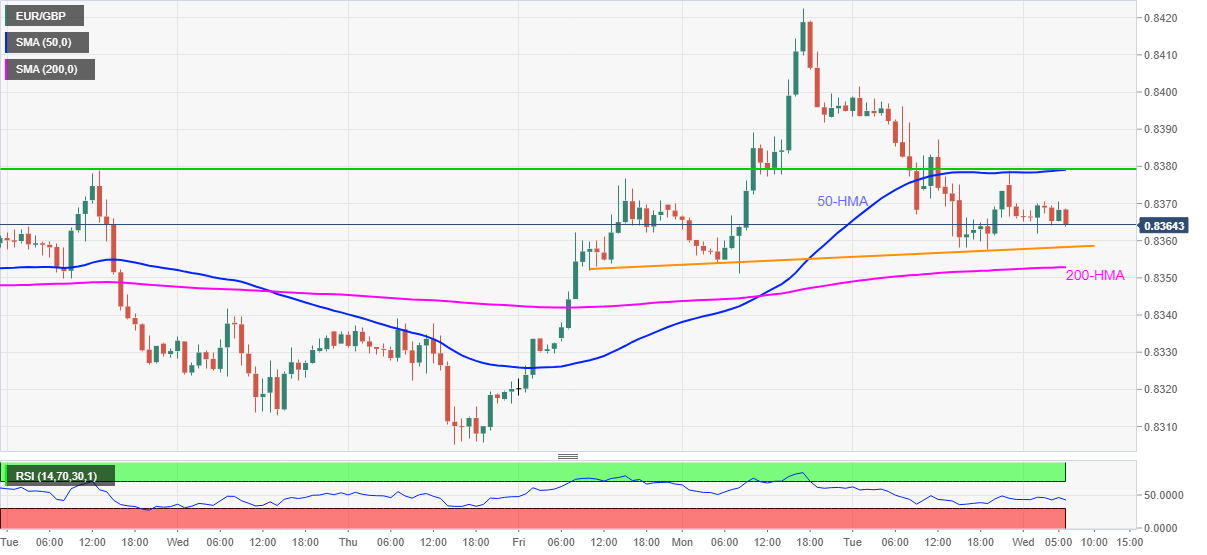
Trend: Sideways
- EUR/USD remains vulnerable while defending key support.
- Bulls take a breather ahead of the critical Fed decision.
- RSI stays bearish, Tuesday’s low of 1.1263 remains in sight.
EUR/USD is flirting with 1.1300, holding the lower ground amid a pause in the US dollar decline across the board.
The US Treasury yields remain on the defensive, as investors await the Fed decision to gauge how hawkish Jerome Powell and Company have turned out.
The divergent monetary policy outlooks between the Fed and the ECB will likely keep the bulls on the sidelines, as the FOMC is widely expected to hint at a March interest-rate hike on Wednesday.
The main currency pair staged a decent comeback on Tuesday, although finished in the red zone amid mixed German IFO indicators and unimpressive comments from the ECB Chief Economist Phillip Lane.
Looking at EUR/USD’s daily chart, the price is challenging the two-month-long ascending trendline support, aligned at 1.1295.
Daily closing below the latter will fuel a fresh downswing towards 1.1250. Ahead of that, Tuesday’s low of 1.1263 will be put to test.
The 14-day Relative Strength Index (RSI) is inching lower below the midline, suggesting that the downside bias remains intact.
EUR/USD: Daily chart
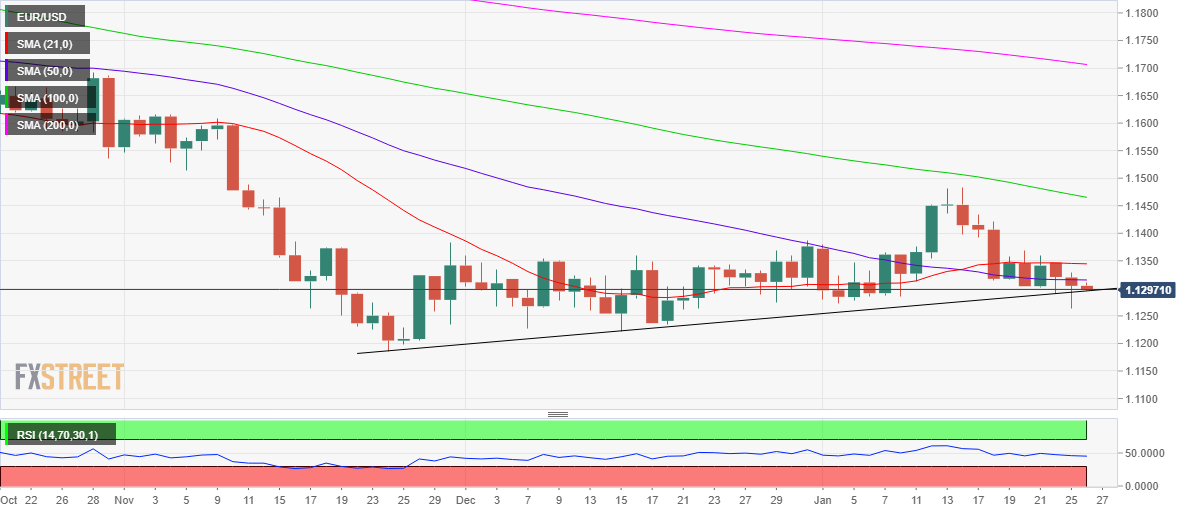
On the flip side, recapturing 50-Daily Moving Average (DMA) support-turned-resistance at 1.1315 is critical to unleashing the further recovery.
The next significant resistance is envisioned at the horizontal 21-DMA at 1.1345. Further up, buyers will look to take out the 1.1400 round level.
EUR/USD: Additional levels to consider
- A combination of factors assisted AUD/USD to gain some positive traction on Wednesday.
- Stability in the equity markets, RBA rate hike bets benefitted the perceived riskier aussie.
- Investors, however, preferred to wait on the sidelines ahead of the crucial FOMC decision.
The AUD/USD pair traded with a positive bias heading into the European session and was last seen hovering near the daily high, around the 0.7160 region.
Following the previous day's good two-way price move, the AUD/USD pair regained positive traction on Wednesday and was supported by a combination of factors. Signs of stability in the global equity markets, along with expectations for an earlier interest rate hike by the Reserve Bank of Australia acted as a tailwind for the perceived riskier aussie.
Tuesday's stronger Australian CPI report fueled speculations that the RBA will scrap its bond-buying program at its upcoming meeting and open the door to rate rises this year. In fact, the headline CPI rose 1.3% in Q4, pushing the yearly rate to 3.5%. Adding to this, the core CPI surpassed the midpoint of the RBA's 2-3% target for the first time since June 2014.
On the other hand, the US dollar consolidated its recent gains to a two-week high and remained well supported by expectations that the Fed will tighten its policy at a faster pace than anticipated. The markets seem convinced that the US central bank would begin raising interest rates in March and have been pricing in a total of four hikes in 2022.
Hence, the focus will remain glued to the outcome of a two-day FOMC monetary policy meeting, scheduled to be announced later during the US session. Heading into the key event risk, investors might refrain from placing aggressive directional bets and prefer to wait on the sidelines. This, in turn, should keep a lid on any further gains for the AUD/USD pair.
Even from a technical perspective, the recent breakdown below an upward sloping trend-channel extending from the 2021 low warrants some caution for bullish traders. Hence, it will be prudent to wait for a strong follow-through buying before confirming that the AUD/USD pair has formed a strong base near the 0.7090 area and positioning for any meaningful upside.
Technical levels to watch
In opinion of FX Strategists at UOB Group, further decline in AUD/USD should meet a tough contention around 0.7090 in the next weeks.
Key Quotes
24-hour view: “We highlighted yesterday that ‘a temporary low may be in place’ and we expected AUD to ‘trade sideways between 0.7110 and 0.7180’. Our view for sideway-trading was not wrong even though AUD traded within a narrower range than expected (07122/0.7178). Momentum indicators are mostly neutral and further sideway-trading appears likely. Expected range for today, 0.7120/0.7185.”
Next 1-3 weeks: “Two days ago (24 Jan, spot at 0.7180), we highlighted that downward momentum is showing tentative signs of building and the risk of AUD breaking 0.7140 has increased. After AUD dropped sharply to 0.7091 and rebounded, we highlighted yesterday (25 Jan, spot at 0.7150) that the rapid drop appears to be overdone but the downside risk remains intact. There is no change in our view but a break of 0.7225 (no change in ‘strong resistance’ level from yesterday) would indicate that the downside risk has dissipated. Looking ahead, the next support below 0.7090 is at 0.7060.”
Open interest in natural gas futures markets extended the downtrend for the fifth consecutive session on Tuesday, now by around 10.8K contracts according to advanced figures from CME Group. Volume followed suit and dropped for the third straight session, this time by around 7.1K contracts.
Natural Gas faces resistance at the 200-day SMA
Prices of natural gas extended the recovery for yet another session on Tuesday. However, shrinking open interest and volume signal the presence of short covering behind the move. That said, the upside momentum in the commodity could struggle around the key 200-day SMA, today at $4.11 per MMBtu.
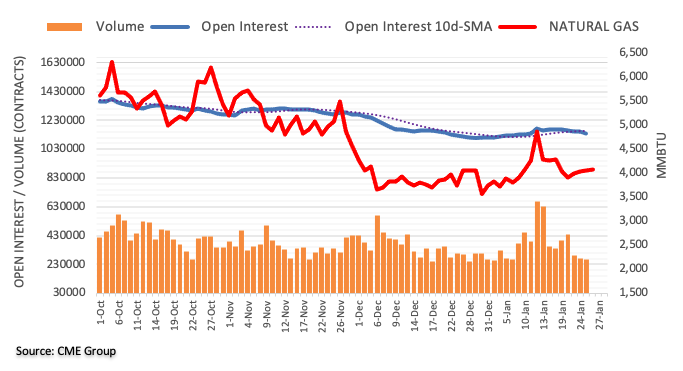
Lee Sue Ann, Economist at UOB Group, expects the Federal Reserve to keep its monetary conditions unchanged at its event later on Wednesday.
Key Quotes
24-hour view: “The December 2021 FOMC indicated a shift forward to the Fed’s policy normalization timeline.”
“The Fed will accelerate QE tapering which we now expect to be completed in March 2022.”
“Thereafter, we expect three rate hikes in 2022 (in line with the Dotplot guidance), the first one likely in June. This is followed by rate hikes in September and December. There is a risk the Fed may hike any time after QE taper ends in March.”
- Asia-Pacific equities trade mixed as market players await FOMC.
- Complex signals over China and Japan’s Omicron woes add to trading filters.
- IMF downgrades global economic growth forecasts, Russia-Ukraine fears ease.
- Fed is up for a hawkish halt but expectations are too high and virus woes do test the bulls.
Asian investors fail to portray a clear trend while tracking the market’s cautious sentiment ahead of Wednesday’s Federal Open Market Committee (FOMC) meeting. Adding to the inaction are the national holidays in India, Australia and Indonesia.
That said, MSCI’s index of Asia-Pacific shares outside Japan drops 0.20% and so does Japan’s Nikkei 225. It should be noted that the Bank of Japan (BOJ) policymakers have conveyed fears of Omicron spread, via BOJ Summary of Opinions, as the nation escalation drive to curb the virus variant by taking 34 of the 47 prefectures under quasi-emergency.
The virus also pushed policymakers at the IMF to downgrade global growth forecasts as No.2 official Gita Gopinath said, “We project global growth this year at 4.4%, 0.5 percentage point lower than previously forecast, mainly because of downgrades for the United States and China,” per Reuters.
It should, however, be noted that a former People’s Bank of China (PBOC) official Yu Yongding said, “China's economy can grow 5.5% in 2022, and policymakers could set a higher economic growth target as long as inflation and systemic financial risks are under control.” The same joins the PBOC’s heavy liquidity injection to help stocks in China and New Zealand. Though, fears of further US-China tussles seem to keep Hong Kong markets in mild losses.
Elsewhere, the US, the UK and European Union (EU) are determined to levy economic sanctions on Russia if it invades Ukraine, which in turn keeps geopolitical fears on the table. However, the latest updates suggest receding fears of an imminent war between Moscow and Kyiv.
On a broader front, the US 10-year Treasury yields remain sluggish around 1.78% after a five-day downtrend while the stock futures print mild gains.
Moving on, investors will pay major attention to Fed Chairman Jerome Powell’s speech with hopes of getting hints for the March rate hike. Also important to watch will be clues on when the Quantitative Easing (QE) will end, as well as balance sheet normalization. Should Fed policymakers shrug off virus woes to battle reflation fears, equities will have a further downside to track.
Read: Federal Reserve Interest Rate Decision Preview: Inflation, Omicron and equities
Considering preliminary readings from CME Group for crude oil futures markets, traders added around 25.3K contracts to their open interest positions on Tuesday, reaching the second daily build in a row. In the same line, volume, reversed two pullbacks in a row and went up by around 188.5K contracts.
WTI keeps targeting the 2022 high near $88.00
Tuesday’s decent uptick in prices of the barrel of WTI was accompanied by a sharp increase in open interest and volume, allowing for the continuation of the rally in the very near term. That said, the next magnet for oil bulls remains at the YTD low just below the $88.00 mark (January 19).
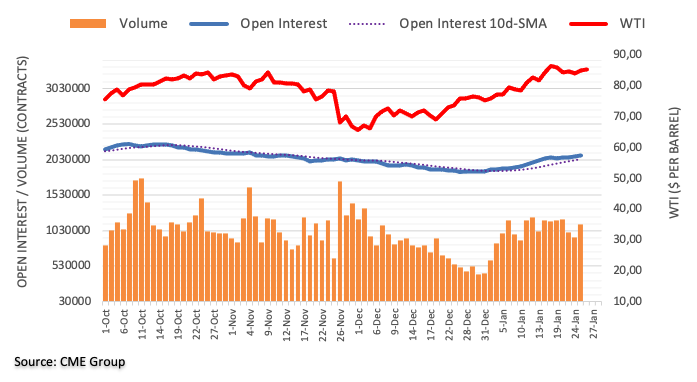
Cable still risks extra losses, although a drop to 1.3400 appears unlikely for the time being, suggested FX Strategists at UOB Group.
Key Quotes
24-hour view: “We highlighted yesterday that ‘there is room for GBP to dip to 1.3430 first before a more sustained rebound can be expected’. GBP subsequently dipped to 1.3436 before rebounding sharply to close slightly higher at 1.3507 (+0.12%). Downward pressure has dissipated and GBP is likely to trade sideways for today, expected to be within a range of 1.3460/1.3550.”
Next 1-3 weeks: “On Monday (24 Jan, spot at 1.3550), we highlighted that GBP is likely to trade with a downward bias towards 1.3500. After GBP plummeted to 1.3441, we highlighted yesterday (25 Jan, spot at 1.3485) that while further GBP weakness is likely, oversold shorter-term conditions suggest that a slower pace of decline and the next support at 1.3400 may not come into the picture so soon. There is no change in our view for as GBP subsequently dropped to 1.3436 before rebounding. Downward pressure has eased somewhat but only a breach of 1.3575 (no change in ‘strong resistance’ level from yesterday) would indicate that 1.3400 is out of reach.”
CME Group’s flash data for gold futures markets noted open interest rose for the second session in a row on Tuesday, this time by around 15.6K contracts. Volume, instead, resumed the downtrend and shrank by more than 71K contracts.
Gold remains supported by the $1,800 area
Tuesday’s continuation of the recovery in gold was amidst increasing open interest, which is supportive of further gains in the very near term. However, shrinking volume might warn against this move, which in turn stays underpinned by the key $1,800 region, where the 200-day SMA also coincides.
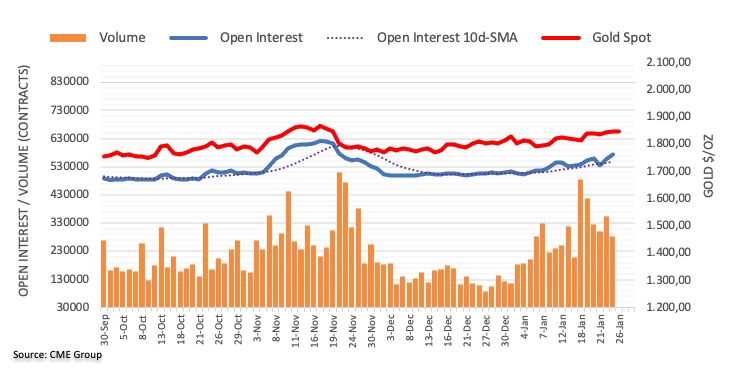
- Silver takes offers to refresh intraday low during four-day downtrend.
- Pullback from 200-DMA, easing bullish bias of MACD favor sellers.
- 100-DMA adds to the downside filters, five-month-old horizontal area appears tough nut to crack for bulls.
Silver (XAG/USD) prices remain on the back foot for the fourth consecutive day, down 0.50% around the intraday low of $23.72 heading into Wednesday’s European session.
The bright metal’s latest weakness becomes the extension of the previous week’s pullback from the 200-DMA. Also weighing on the quote is the recently easing MACD line.
However, the 10-DMA and an ascending trend line from January 17, respectively around $23.70 and $23.55, challenge the commodity’s short-term declines.
If XAG/USD bears remain dominant past $23.55, the 100-DMA level of $23.24 and the $23.00 will be on their radars.
Alternatively, the corrective pullback may initially aim to regain the $24.00 round figure before challenging the 200-DMA level near $24.60.
Following that, multiple resistances marked since September 2021, near $24.90-80, will challenge the silver buyers before directing them to the year 2021 peak of $25.40.
Overall, silver prices remain vulnerable to the further downside but the 10-DMA and two-week-long support line may restrict the quote’s short-term declines.
Silver: Daily chart
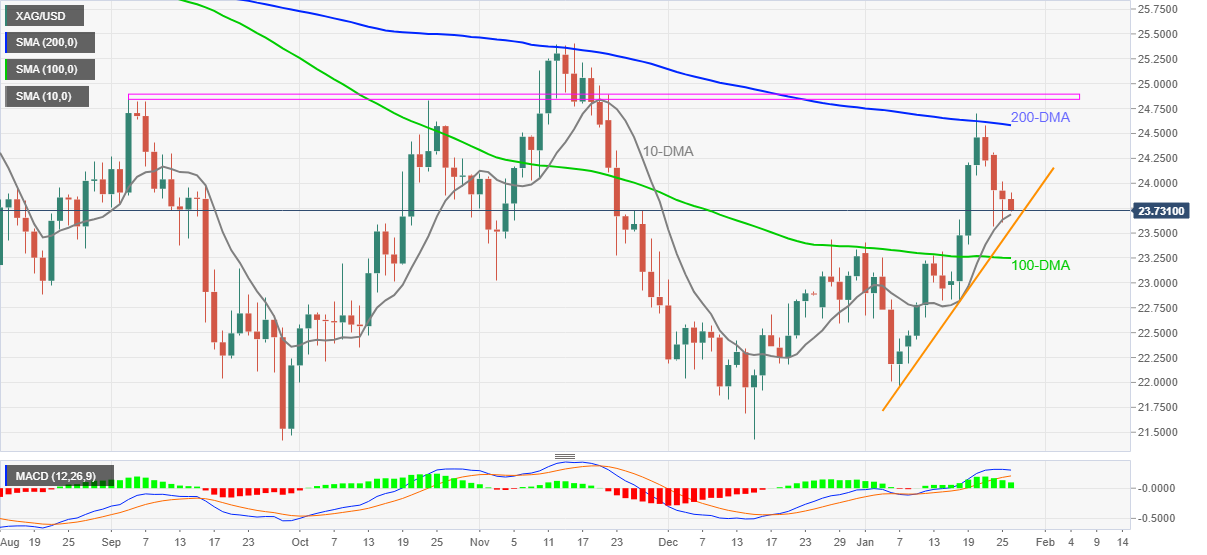
Trend: Further weakness expected
The brewing Russia-Ukraine geopolitical crisis is unlikely to have any significant impact on oil and gas flows, Jeff Currie, Goldman Sachs’ Global Head of Commodities Research, said in a Bloomberg TV interview.
Key quotes
The bank’s base case is “no disruption.”
“Sanctions or an accident are the two main potential sources of disruption to raw materials markets from Ukraine.”
“A sanctions-driven disruption would be “mutually-assured destruction” as “it’s not in the interest of anybody to stop the flows of energy through Ukraine.”
“However, there could be some upside for prices.”
“For oil, it’s probably worth about $2 a barrel and for natural gas about $4 per million British thermal unit,” he said, adding that “grain prices were also worth watching, given that Ukraine is a major exporter of wheat and corn.”
In opinion of FX Strategists at UOB Group, EUR/USD could be headed towards the 1.1240 level in the next weeks.
Key Quotes
24-hour view: “Yesterday, we held the view that EUR could ‘test the major support at 1.1285 but the odds of EUR breaking this major support are not high’. However, EUR breached 1.1285 and dropped to 1.1261 before rebounding. The rebound amid lackluster downward momentum indicates that EUR is unlikely to weaken further. For today, EUR is more likely to trade sideways between 1.1280 and 1.1335.”
Next 1-3 weeks: “We have the same view since last Thursday (20 Jan, spot at 1.1340) where there is a slight downward bias in EUR but any weakness is likely limited to a test of 1.1285. Yesterday (25 Jan), we highlighted, that ‘Looking ahead, if there is a clear break of 1.1285, the next support level to watch is at 1.1240’. EUR dropped below 1.1285 during London session before rebounding from 1.1261. Despite the breach of 1.1285, downward momentum has not improved by much. That said, the downward bias is still intact and EUR could edge lower to 1.1240. On the upside, a breach of 1.1365 (‘strong resistance’ level was at 1.1385 yesterday) would indicate that the downward bias has eased.”
- GBP/USD fades corrective pullback from three-week low, indecisive during Asia.
- France reissues legal threat to UK over fishing issues, EU’s Sefcovic ‘frustrated’ over Brexit deadlock.
- The UK eases covid-linked restrictions on international arrivals, PM Johnson awaits Tory reaction to ‘Partygate’.
- Fed, BOE both expected to turn hawkish but today is the FOMC day and hence pair bears stay hopeful.
GBP/USD consolidates the previous day’s rebound near 1.3510 during a sluggish session ahead of Wednesday’s London open.
Although the pre-Fed anxiety becomes the key burden weighing down the pair prices, downbeat concerns over Brexit and the UK politics also exert an additional downside burden on the GBGP/USD prices.
The cable pair bounced off a monthly low the previous day amid escalating chatters over the Bank of England’s (BOE) rate hike and political fraternity flashing lesser negatives for UK Prime Minister (PM) Boris Johnson. On the same line was the market’s cautious sentiment ahead of today’s US Federal Reserve (Fed) monetary policy meeting.
Although UK activity numbers couldn’t match the likes of the British important and employment data for January, the Omicron-linked supply outage is likely to push the “Old Lady” towards a rate hike earlier than previously signaled. In this regard, Reuters said, “Britain's central bank looks on course to raise interest rates next week for the second time in less than two months, reversing more of its COVID-19 pandemic stimulus, after inflation jumped to its highest in nearly 30 years.”
Also positive for the GBP/USD prices could be the UK’s reduction in the covid-linked entry barriers for the foreign arrivals, as well as talks that Britain will have good post-Brexit trade deals with the US and India.
On the contrary, France reiterates dislike for the post-Brexit fishing laws per European affairs minister Clement Beaune. Also portraying the Brexit fears were headlines from the UK Express saying, “(EU) Brexit negotiator Maros Sefcovic is "frustrated" with the UK after another week of talks with Liz Truss that brought no breakthrough.”
It’s worth noting that the Russia-Ukraine woes, downbeat economic forecasts by the International Monetary Fund (IMF) and hawkish Fed expected, backed by firmer US inflation expectations, per the 10-year, breakeven inflation rate per the St. Louis Federal Reserve (FRED) data, also play their roles to limit immediate GBP/USD moves.
Moving on, GBP/USD traders will pay attention to Fed Chair Jerome Powell’s speech as the Fed Boss is likely to tease the March rate hike, which in turn could weigh on the GBP/USD prices.
Read: Federal Reserve Interest Rate Decision Preview: Inflation, Omicron and equities
Technical analysis
Unless crossing the 100-DMA level of 1.3535, GBP/USD remains vulnerable to retest the 50-DMA, around 1.3420 at the latest.
- Gold price remains stuck between the Russia-Ukraine crisis and the Fed.
- Traders turn cautious as Fed is likely to hint at a March rate hike.
- Gold Price Forecast: XAU/USD risks correction on death cross, potential Fed’s hawkishness
Gold price has paused its two-day uptrend, as bulls contemplate the next move, in anticipation of the critical Fed interest rate decision. Fed is seen hinting at a March rate lift-off while traders will closely eye any signals on the timing of the balance sheet reduction. Expectations of a hawkish Fed outcome are limiting the upside in gold price, although bulls draw support from the ongoing Russia-Ukraine geopolitical turmoil. Let’s take a look at gold’s key technical levels in the run-up to the Fed showdown.
Read: Fed January Preview: Three possible scenarios for gold
Gold Price: Key levels to watch
The Technical Confluences Detector shows that the gold price is consolidating below a bunch of healthy resistance levels stacked up around $1,849.
At that supply zone, the previous week’s high coincides with Fibonacci 38.2% one-day.
The immediate upside meets strong offers around $1,852, the confluence of the pivot point one-week R1, Fibonacci 23.6% one-day and Bollinger Band one-day Upper.
The intersection of the pivot point one-day R1 and pivot point one-month R1 at $1,856 is the level to beat for gold bulls.
On the other hand, if the correction picks up steam, then the immediate support awaits at the Fibonacci 61.8% one-day at $1,842.
The next significant cushion is placed at $1,840, the SMA5 one-day, below which the Fibonacci 23.6% one-week at $1,837 will get tested.
A sharp sell-off will be triggered below the last, calling for a test of the previous month’s high of $1,831.
Here is how it looks on the tool
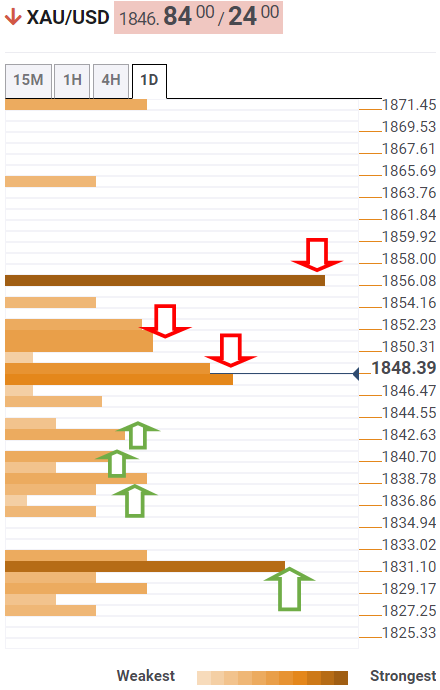
About Technical Confluences Detector
The TCD (Technical Confluences Detector) is a tool to locate and point out those price levels where there is a congestion of indicators, moving averages, Fibonacci levels, Pivot Points, etc. If you are a short-term trader, you will find entry points for counter-trend strategies and hunt a few points at a time. If you are a medium-to-long-term trader, this tool will allow you to know in advance the price levels where a medium-to-long-term trend may stop and rest, where to unwind positions, or where to increase your position size.
- USD/JPY pares early Asian session losses but stays neutral on a day.
- Bullish chart pattern keeps buyers hopeful amid upbeat MACD, RSI.
- Sellers have a bumpy road before testing 113.00, December’s low.
USD/JPY licks its wounds near 113.90 amid the pre-Fed inactive Asian session on Wednesday.
In doing so, the yen pair stays inside a short-term bullish chart pattern, namely ascending triangle, amid firmer MACD and RSI signals.
However, a convergence of the 61.8% Fibonacci retracement (Fibo.) of November-January upside and the upper line of the stated triangle from January 14, challenge the pair’s immediate upside moves near 114.00.
Also acting as important resistances are the 50-SMA and 200-SMA levels surrounding 114.15 and 114.55 in that orders.
Should USD/JPY rises past 114.55, its run-up towards the monthly high of 116.35 can be expected.
Meanwhile, the lower line of the triangle close to 113.45 limits the quote’s nearby declines, a break of which will direct USD/JPY sellers towards multiple supports marked since early December near 113.20.
Following that, the 113.00 threshold and the previous month’s low of 112.53 will be in focus.
USD/JPY: Four-hour chart
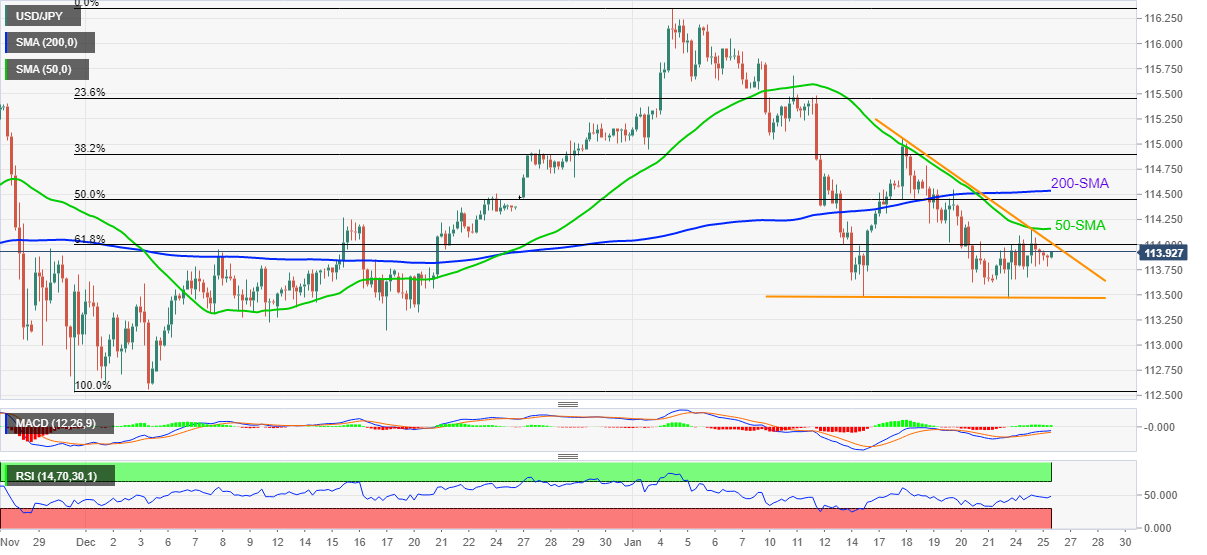
Trend: Recovery expected
- EUR/USD fades bounce off monthly low amid pre-Fed caution.
- US Dollar tracks downbeat yields as markets prepare for hawkish FOMC.
- ECB’s Lane turned down concerns over Omicron-linked challenges to inflation, wages.
- Second-tier US data may entertain traders with eyes on Fed Chair Powell.
EUR/USD bears take a breather around 1.1300 as markets brace for the Fed’s verdict, following a two-day downtrend.
Even so, hawkish expectations from the US Federal Reserve (Fed), versus recently shrugged off inflation fears by the ECB policymaker, keep EUR/USD bears hopeful.
It should be noted, however, that sluggish yields and the US dollar’s pullback from a three-week top challenges the pair’s short-term moves ahead of crucial market events.
That said, the US Dollar Index (DXY) pulls back from the three-week top, marked on Tuesday while easing to 95.95 at the latest. Further, US 10-year Treasury yields seesaw around 1.78%, being barely positive after declining for the last five days.
In addition to the Fed concerns, the recently downbeat yields could be linked to the geopolitical tension surrounding Russia and Ukraine, as well as the downbeat economic forecasts by the International Monetary Fund (IMF).
Talking about data, firmer German and Eurozone IFO numbers joined downbeat US CB Consumer Confidence and Richmond Fed Manufacturing Index to lift the EUR/USD pair the previous day. However, the upbeat US inflation expectations, per the 10-year breakeven inflation rate per the St. Louis Federal Reserve (FRED) data, kept sellers in control afterward.
On the contrary, , the European Central Bank (ECB) Chief Economist Philip Lane’s rejection of Omicron-linked inflation fears also weighs on the EUR/USD prices. “The coronavirus Omicron variant is not turning out to be a factor that will influence the activity levels for the year,” said the policymaker.
Looking forward, second-tier US data relating to housing and trade may entertain EUR/USD traders as markets await Fed Chair Jerome Powell’s speech amid hopes of getting clues for March rate lift-off and/or balance sheet normalization. It should be observed that the Fed’s tapering is on and the hint for ending the same during February may also be termed as a bearish case for the EUR/USD.
Read: Federal Reserve Interest Rate Decision Preview: Inflation, Omicron and equities
Technical analysis
Failures to extend the bounce off a two-month-old support line beyond a one-week-old resistance line and 20-DMA, respectively around 1.1320 and 1.1345, keep EUR/SD sellers hopeful around the stated support line near 1.1300.
If at all the major currency pair rises past 1.1345, the 38.2% Fibonacci retracement (Fibo.) of October-November 2021 downside, near 1.1380, will be the key as it holds the gate for the pair’s further rally towards the monthly high of 1.1481.
Alternatively, multiple lows marked since late November highlight 1.1230 as the next support following the EUR/USD pair’s clear downside break of 1.1290.
- USD/CHF stays pressured around two-week high despite the recent bounce off daily low.
- Failures to cross 50-DMA join steady RSI to keep sellers hopeful.
- Three-month-old horizontal support is the key, 61.8% Fibonacci retracement tests immediate downside.
USD/CHF pares weekly gains around 0.9175 during early Wednesday morning in Asia.
The Swiss currency (CHF) pair jumped the most in a fortnight before taking the U-turn from the 50-DMA.
Given the failures to cross the key moving average joins mostly steady RSI, USD/CHF prices ease towards the 61.8% Fibonacci retracement (Fibo.) of August-November upside.
It should be noted, however, that the pair’s declines past 0.9153 nearby support will be challenged by a horizontal area comprising lows marked since early November, near 0.9090, a break of which will direct bears towards August month’s low of 0.9018.
Alternatively, 50% Fibo. near 0.9195 can act as an immediate upside hurdle ahead of the 50-DMA level of 0.9205.
In a case where USD/CHF bulls manage to cross the 0.9205 resistance, the run-up to the monthly high of 0.9278 can’t be ruled out.
USD/CHF: Daily chart

Trend: Pullback expected
- USD/CAD extends the previous day’s losses, drops towards intraday bottom of late.
- US dollar tracks downbeat Treasury yields amid pre-Fed anxiety.
- Oil prices struggle as IMF cuts global growth forecasts, Russia-Ukraine tussles pause.
- BOC is widely anticipated to maintain the status quo versus hawkish expectations from Fed.
USD/CAD remains pressured towards an intraday low of 1.2599 during the two-day downtrend amid early Wednesday in Europe.
In doing so, the quote benefits from the broad US dollar weakness while tracking the US Treasury yields.
The Loonie pair snapped a three-day uptrend the previous day as prices of Canada’s main export item, WTI crude oil rose the most in a week. Also favoring the USD/CAD sellers was the market’s indecision ahead of the monetary policy meetings by the Bank of Canada (BOC) and the US Federal Reserve (Fed).
Read: Bank of Canada Rate Decision Preview: No surprises for a 25bps rate hike
That said, the US Dollar Index (DXY) pulls back from the three-week top, marked on Tuesday, while easing to 95.95 at the latest.
US 10-year Treasury yields seesaw around 1.78%, being barely positive after declining for the last five days.
Prices of WTI crude oil, down 0.35% daily around $84.80, fails to respect the upbeat weekly inventory report by the American Petroleum Institute (API). That said, the
API Weekly Crude Oil Stock for the week end of January 21 flashed -0.872M figures versus the previous addition of 1.404M. The reason could be linked to the downbeat economic forecasts by the International Monetary Fund (IMF), as well as Ukrainian policymakers’ readiness to placate the tension with Russia.
To sum up, the USD/CAD pair fails to cheer the broad risk-off mood as the US dollar steps back ahead of the Fed’s likely hawkish verdict, considering firmer US inflation expectations, per the 10-year, breakeven inflation rate per the St. Louis Federal Reserve (FRED) data. Also favoring the Fed optimists are fears of supply-chain constraints due to the Omicron.
Moving on, USD/CAD traders will pay attention to Fed Chair Jerome Powell as neither the US central bank nor BOC are expected to alter the current monetary policy settings. However, the US Federal Open Market Committee (FOMC) needs to confirm the March rate hike and/or balance sheet normalization to beat the pair bears.
Read: Federal Reserve Interest Rate Decision Preview: Inflation, Omicron and equities
Technical analysis
Failures to stay beyond the 100-DMA, around 1.2620 by the press time, direct USD/CAD prices towards the mid-January peak of 1.2570. However, the 200-DMA level of 1.2500 will challenge the pair’s further downside.
It’s worth noting that the latest peak of 1.2700 and the monthly low near 1.2450 act as additional trading filters.
- USD/INR bulls are in charge, breaking the inverse H&S's neckline.
- 75 the figured is eyed ahead of a 50% mean reversion to 75.20.
USD/INR has been a strong performer since the midpoint of the month with the bulls running through the 73 and 74 areas with 75 the figure in their sights.
The following illustrates the market structure in a weekly and daily analysis as the countdown to the Federal Reserve outcome begins.
USD/INR weekly chart

The bulls are in charge here having already piled in from the trendline support and there are prospects of a continuation towards a 50% mean reversion near 75.20. The 61.8% Fibonacci retracement aligns with the prior structure near 75.50 thereafter.
USD/INR daily chart
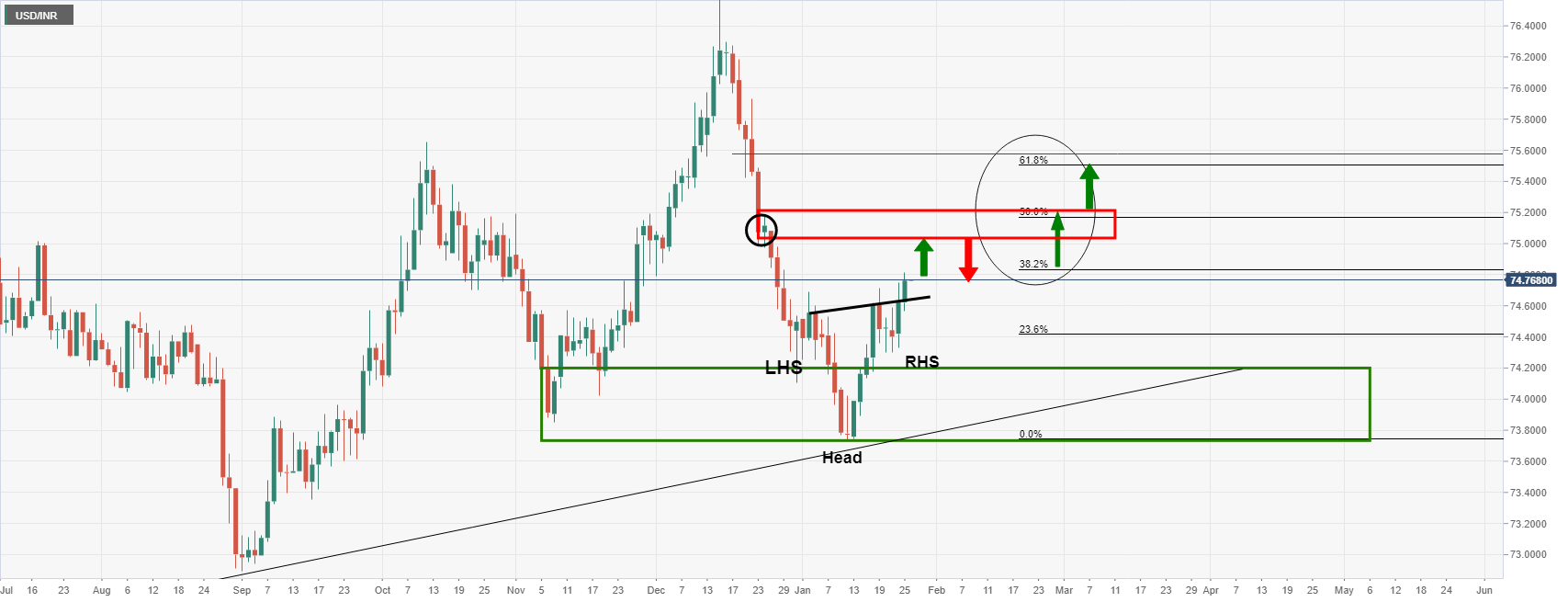
The daily chart's inverse head and shoulders are compelling with the price breaking the neckline and well en route to the 38.2% Fibonacci retracement level. The structure to the upside aligns with 75 the figure just ahead of the 50% mean reversion around 75.20.
- GBP/JPY bulls stepping in and the Fibo levels align with prior structures for which to target.
- Bears will be seeling a discount to target a lower low in days to come.
GBP/JPY has been strongly offered at the start of the year and the following illustrates the daily chart's market structure and prospects of a downside continuation.
However, the price is now stalling on the downside with a decoration that would be expected to evolve into a potentially significant correction
GBP/JPY daily chart

The bulls can keep the Fibonacci retracements in mind whereby the 38.2% aligns with the 4-hour consolidative highs near 154.50, the 50% mean reversion with the 3rd Jan highs near 154.50 and the 61.8% near 155.50.
Any of these areas could be an attractive area for bears to reengage at a discount to target daily extensions to the downside with 152.50 in mind.
- USD/CNH drops for the sixth consecutive day, stays pressured around intraday low.
- PBOC keeps pumping the markets, hopes of economic recovery battles IMF comments.
- Sino-American tussles, Russia-Ukraine drama also try to stop the bears.
- Second-tier US housing, trade numbers may entertain trades but Fed Chair Powell’s speech is the key.
USD/CNH cheers US dollar pullback to print a six-day downtrend around $6.3280 during early Wednesday.
In doing so, the Chinese currency (CNH) pair justifies the economic recovery hopes conveyed by the ex-People’s Bank of China (PBOC) official while paying a little heed to the central bank’s heavy liquidity injection.
A former member of People’s Bank of China’s (PBOC) monetary policy committee Yu Yongding said, “China's economy can grow 5.5% in 2022, and policymakers could set a higher economic growth target as long as inflation and systemic financial risks are under control.”
His comments were in contrast to the International Monetary Fund’s (IMF) downbeat economic forecasts. “We project global growth this year at 4.4%, 0.5 percentage point lower than previously forecast, mainly because of downgrades for the United States and China,” said No.2 official Gita Gopinath per Reuters.
It should be noted that the PBOC has recently cut benchmark rates and propelled ample liquidity into the markets to defend against the Fed’s rate hikes. The Chinese central bank injected 100 billion yuan on a net basis at the latest.
Elsewhere, geopolitical concerns relating to Russia’s readiness to attack Ukraine and the America COMPETES Act weigh on the market sentiment and should have helped the US Treasury yields. However, pre-Fed anxiety stops the US bond sellers from retaking controls after five consecutive days of absence.
Moving on, the Fed’s readiness to scale back easy money contrasts the PBOC’s mammoth liquidity infection and hence signals the USD/CNH rebound if the US Fed policymakers meet the hawkish expectations.
Read: Federal Reserve Interest Rate Decision Preview: Inflation, Omicron and equities
Technical analysis
An eight-month-old descending support line near $6.3238 restricts immediate USD/CNH downside amid oversold RSI conditions.
“We are fully committed to a diplomatic solution to current tensions with Russia,” Ukrainian Ambassador to Japan Sergiy Korsunsky said in a statement on Wednesday.
Korsunsky added, “we have no plan to attack any part of occupied territories.”
“If Russia is allowed to move forward with force, we will see more such cases in the world,” Ukrainian envoy to Japan said.
Late Tuesday, when asked about whether he could see Russian leader Vladimir Putin facing US sanctions, President Joe Biden said, “Yes, I would see that.”
Further comments
“As I’ve said, there are going to be serious economic consequences if he moves.”
“If he were to move in with all those forces, it would be the largest invasion since World War II. It would change the world.”
Market reaction
The above conciliatory comments help ease off the tensions between Russia and Ukraine, underpinning the risk-on trading in Asia so far this Wednesday.
The S&P 500 futures gain 0.15% on the day while AUD/USD consolidates the recent recovery above 0.7150. All eyes remain on the Fed verdict.
| Raw materials | Closed | Change, % |
|---|---|---|
| Brent | 86.82 | 1.27 |
| Silver | 23.808 | -0.68 |
| Gold | 1847.702 | 0.25 |
| Palladium | 2196.82 | 2.56 |
“China's economy can grow 5.5% in 2022, and policymakers could set a higher economic growth target as long as inflation and systemic financial risks are under control,” a blog post run by China Finance 40 Forum reported on Wednesday, citing comments from Yu Yongding, a former member of People’s Bank of China’s (PBOC) monetary policy committee.
Additional quotes
“Boosting growth relies on infrastructure investment given the continuing economic downturn and weak expectations, so as to further drive manufacturing investment and lift consumption.”
“China should consider expanding the issuance of treasury bonds to raise funds for infrastructure projects, as local governments are short of funds to undertake investment tasks.”
Market reaction
USD/CNY flirts with daily lows just above 6.3200, down 0.09% on the day. The Chinese currency is benefiting from the amply liquidity injected by the central bank ahead of the Lunar New Year.
China's central bank Wednesday conducted 200 billion yuan (USD31.6 billion) of reverse repos to maintain liquidity in the banking system, per Reuters.
- NZD/USD remains sidelined around 14-month low, recently off intraday bottom.
- RSI, MACD signals further downside towards 61.8% FE.
- The year 2021 low, two-week-old resistance line guard recovery moves.
NZD/USD follows the global pre-Fed trading inaction while treading water around 0.6690 during Wednesday’s Asian session.
In doing so, the kiwi pair struggles to overcome the multi-day low printed during the last two days.
Given the bearish MACD signals and downbeat RSI, not oversold, the NZD/USD prices have further downside room, which in turn highlights the 61.8% Fibonacci Expansion (FE) of the pair’s moves between November 15, 2021, and January 13, 2022, near 0.6650.
It at all the NZD/USD bears refrain from stepping back past 0.6650, a descending trend line from September 2021 and November 2020 lows, respectively around 0.6615 and 0.6590, will gain the market’s attention.
Meanwhile, corrective pullback needs to cross the year 2021 bottom surrounding 0.6700 before heading towards a downward sloping resistance line from January 13, near 0.6735.
If the NZD/USD bulls cross the 0.6735 hurdle, tops marked since late November close to 0.6900 should flash on their radar.
NZD/USD: Daily chart
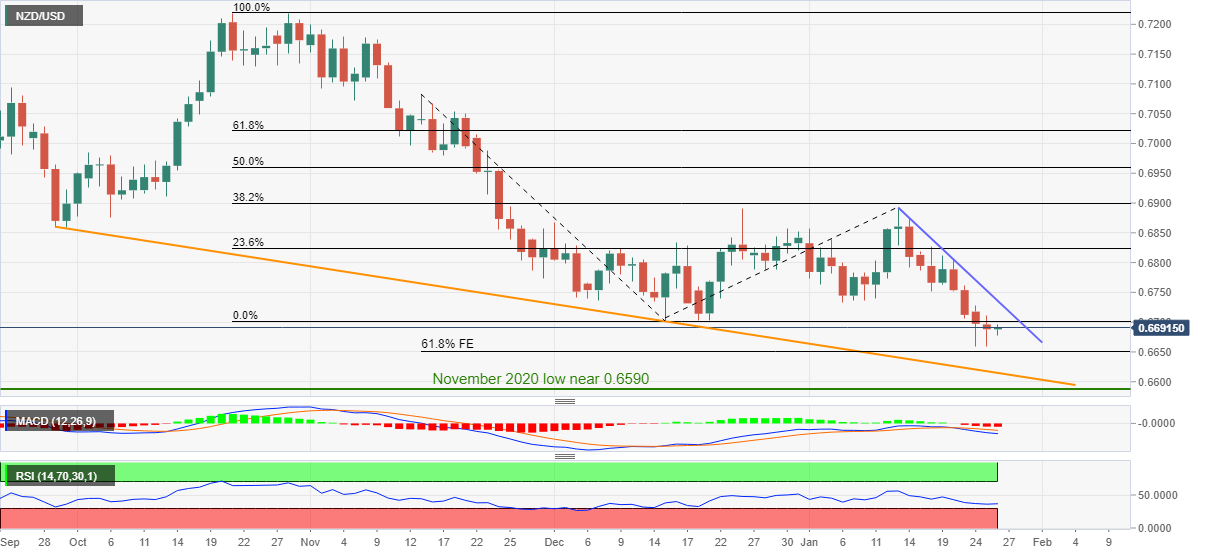
Trend: Bearish
According to the economists at Bank of America (BofA), the US Federal Reserve’s (Fed) hawkish signal at the January FOMC meeting will fuel another leg up in the UIS dollar.
Key quotes
"The Fed will announce the last round of asset purchases at the Jan FOMC meeting, and we see risk for a further hawkish pivot...Chair Powell is likely to signal the first hike at the March meeting and note that every meeting is live."
"In our view, a hawkish FOMC this week should serve as a key catalyst for another leg of US dollar appreciation against lower beta FX.”
“Our forecasts for EUR/USD and USD/JPY this year remain 1.10 and 118, respectively, and we see the risks of attaining that sooner."
“We expect the first-rate hike to be in March, with 25 by hikes in each of the next eight quarters.”
“We now expect QT to be announced at the June FOMC meeting, with risks skewed earlier to the May FOMC meeting.”
- The US dollar is consolidating ahead of Fed day.
- Bulls are lurking in the flanks with eyes on a correciton.
The US dollar retreated from a two-week peak on Tuesday as investors set aside the tensions between Russia and the West over Ukraine and instead focussed on today's Federal Reserve policy meeting. The DXY, an index that measures the greenback vs a basket of currencies, has fallen to test the bullish commitments near 96 the figure where it is stabilising in Asia.
The markets have priced in a March hike for some time and this left the greenback vulnerable to a long squeeze into today's revealing of policy decisions in the last week of the month. Additionally, there was a focus on today's 5-year Treasury auction.
The bid-to-cover ratio was high and so too was the yield with the US selling 5-year notes at 1.533% vs WI 1.547% on a $55 billion sale. That was the highest yield since October 2019. The prior was 1.263% and the bid to cover at 2.50 vs 2.41 prior. This indicates that the market could be pricing the Fed too hawkish for the medium term which has dented the US dollar before today's big event.
Meanwhile, on the geopolitical front, Russia said it was watching with great concern after the US sent 8,500 troops on alert to deploy to Europe. This is a theme that is expected to keep the greenback underpinned and the euro on the back foot.
DXY technical analysis
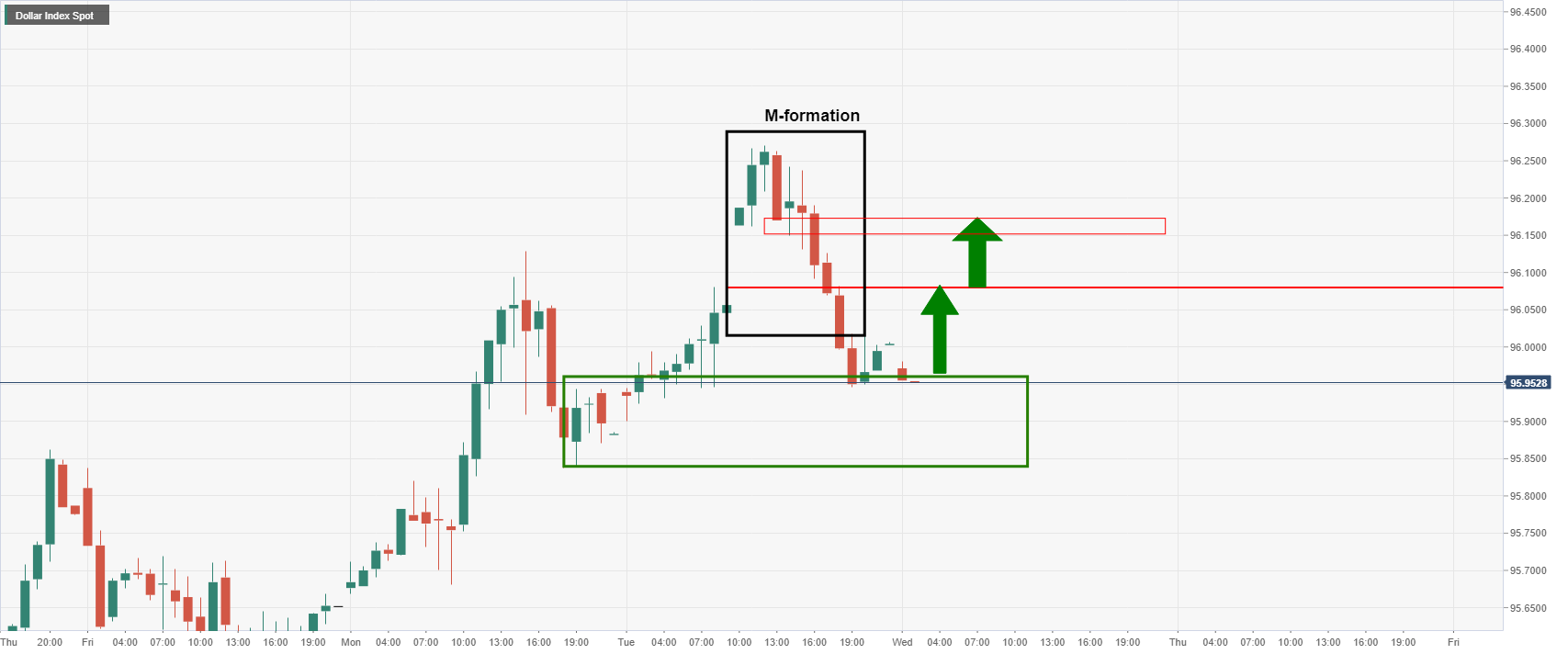
The M-formation is a reversion pattern and the price would be expected to correct higher following the slide from the daily highs.
- US 10-year Treasury yields struggle to defend fist daily positive in six.
- Stock futures pare early gains, Asia-Pacific equities trade mixed.
- Pre-Fed caution gains major attention, Omicron, IMF’s growth forecasts and trade/geopolitical fears add to market’s risk-off mood.
Global markets remain lackluster during Wednesday’s Asian session as investors await the US Federal Reserve’s (Fed) verdict.
Also weighing on the risk appetite are the Omicron woes, geopolitical risks emanating from Russia and downbeat economic forecasts by the International Monetary Fund (IMF).
While portraying the mood, the US 10-year Treasury yields seesaw around 1.78%, being barely positive after declining for the last five days. On the same line is the S&P 500 Futures that remain indecisive around 4,350 whereas the Asia-Pacific stocks traded mixed following the rating giant Moody’s comments.
Read: Moody's: The economic recovery will stabilize in Apac
The South African covid variant pushed policymakers at the IMF to downgrade global growth forecasts as No.2 official Gita Gopinath said, “We project global growth this year at 4.4%, 0.5 percentage point lower than previously forecast, mainly because of downgrades for the United States and China,” per Reuters.
Also weighing on the market sentiment are the US, the UK and European Union’s (EU) readiness to levy economic sanctions on Russia if it invades Ukraine. That said, the latest updates suggest receding fears of an imminent war between Moscow and Kyiv.
Furthermore, the recent passage of the America COMPETES Act offers extra support to the gold prices amid fears of escalating US-China tussles.
It’s worth observing that the Fed hawks ignored softer US CB Consumer Confidence and Richmond Fed Manufacturing Index figures on firmer US inflation expectations, per the 10-year, breakeven inflation rate per the St. Louis Federal Reserve (FRED) data, which in turn favored gold buyers. The inflation gauge rose for the third consecutive day at the latest after declining to the lowest since September on January 20.
Moving on, market sentiment may remain sluggish ahead of the Federal Open Market Committee (FOMC) meeting. Should policymakers fail to meet the market’s hawkish hopes, the disappointment will be responded with more force.
Read: Federal Reserve Interest Rate Decision Preview: Inflation, Omicron and equities
The Bank of Japan (BOJ) published the ‘Summary of Opinions' of its January meeting on Monday, with the key takeaways noted below.
"There's a chance year-on-year growth in consumer inflation may briefly approach 2per cent. If that happens, what's important is to look at facts behind the rise and whether they're sustainable."
"Consumer inflation may temporarily reach levels of around 1.5per cent in the first half of 2022. Whether that momentum is sustained enough for inflation to stably approach the BOJ's 2per cent target would depend on wage and inflation expectations - or in sum the strength of demand."
"Many companies are now having to drop their traditional view that prices will keep falling, and change the way they set prices.”
"It will be difficult to achieve the BOJ's price target by the end of fiscal 2023.”
- USD/JPY tracks downbeat Treasury yields to stay pressured below 114.00 ahead of Fed
- AUD/USD remains indecisive after bouncing off three-week low the previous day.
- Bearish MACD signals, sustained trading below 50-DMA keeps sellers hopeful.
- 23.6% Fibonacci retracement limits immediate downside, 100-DMA acts as an extra hurdle to the north.
AUD/USD treads water around 0.7150, fading the bounce off multi-day low during Wednesday’s Asian session.
In doing so, the Aussie pair remains below 50-DMA amid bearish MACD signals, which in turn suggests the quote’s further downside.
However, fresh declines will wait for a clear break of the 23.6% Fibonacci retracement (Fibo.) late June to December 2021 downside, near 0.7140.
Following that, the 0.7080 mark may offer an intermediate halt during the slump to the year 2021 low of 0.6993.
It’s worth noting that the 61.8% Fibonacci Expansion (FE) of the pair’s moves between June 26 to January 13, around 0.6920, will lure the AUD/USD bears after 0.6993.
Alternatively, recovery moves may initially battle the 50-DMA level of 0.7182 before challenging the 38.2% Fibo. of 0.7230.
It should be noted, however, that the 100-DMA level of 0.7270 and the monthly high of 0.7315 act as tough resistance for AUD/USD bulls to watch past 0.7230.
AUD/USD: Daily chart
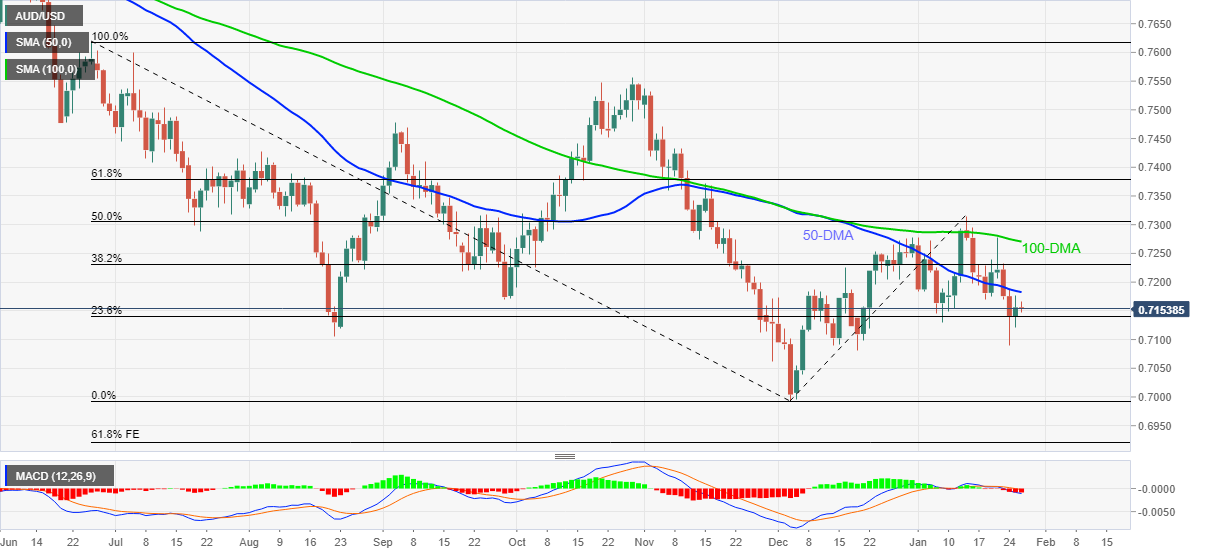
Trend: Further weakness expected
| Time | Country | Event | Period | Previous value | Forecast |
|---|---|---|---|---|---|
| 05:00 (GMT) | Japan | Leading Economic Index | November | 101.5 | |
| 05:00 (GMT) | Japan | Coincident Index | November | 89.8 | |
| 07:45 (GMT) | France | Consumer confidence | January | 100 | 98 |
| 09:00 (GMT) | Switzerland | Credit Suisse ZEW Survey (Expectations) | January | 0.0 | |
| 13:30 (GMT) | U.S. | Goods Trade Balance, $ bln. | December | -97.78 | |
| 15:00 (GMT) | U.S. | New Home Sales | December | 0.744 | 0.76 |
| 15:00 (GMT) | Canada | Bank of Canada Monetary Policy Report | |||
| 15:00 (GMT) | Canada | Bank of Canada Rate | 0.25% | 0.25% | |
| 15:30 (GMT) | U.S. | Crude Oil Inventories | January | 0.515 | -0.728 |
| 19:00 (GMT) | U.S. | Fed Interest Rate Decision | 0.25% | 0.25% | |
| 19:30 (GMT) | U.S. | Federal Reserve Press Conference | |||
| 21:45 (GMT) | New Zealand | CPI, q/q | Quarter IV | 2.2% | 1.3% |
| 21:45 (GMT) | New Zealand | CPI, y/y | Quarter IV | 4.9% | 5.7% |
One-month risk reversal (RR) of GBP/USD, a gauge of calls to puts, not only reversed the previous day’s downside but also printed the biggest daily figures since January 05 by the end of Tuesday’s North American session.
In doing so, the RR prints 0.075 level, following the -0.238 numbers marked the previous day.
It should be noted, however, that the weekly RR print signals that the bears are in control. That said, the RR drops for the third consecutive week so far, with the latest figures of -0.163 being the lowest since the week ended on November 12.
Although the options market data suggests that the GBP/USD buyers are taking risks on the key Fed day, the pair prices struggle to keep the bounce off the lowest levels since January 03, marked the previous day.
The reason could be linked to cautious sentiment ahead of the US Federal Reserve (Fed) meeting joins geopolitical risks emanating from Russia and Omicron woes in Japan, not to forget downbeat economic forecasts by the International Monetary Fund (IMF).
Read: GBP/USD Price Analysis: Bulls packing a punch through 1.35 the figure, 1.3580 eyed
In recent trade today, the People’s Bank of China (PBOC) set the yuan (CNY) at 6.3246 vs the last close of 6.3257 and estimate at 6.3253. This was the strongest fix since April 2018.
About the fix
China maintains strict control of the yuan’s rate on the mainland.
The onshore yuan (CNY) differs from the offshore one (CNH) in trading restrictions, this last one is not as tightly controlled.
Each morning, the People’s Bank of China (PBOC) sets a so-called daily midpoint fix, based on the yuan’s previous day closing level and quotations taken from the inter-bank dealer.
- USD/TRY extends short-term sideways grind, recently challenges bears.
- 50-DMA adds to the downside filters, bulls need validation from November’s high.
- Momentum line’s retreat hints at bears' struggles to retake controls.
USD/TRY remains sidelined around $13.48, keeping two-week-old momentum between 21-DMA and descending trend line resistance. That said, the quote eases to $13.47 during Wednesday’s Asian session.
The Turkish lira (TRY) pair’s weakness aims to retest the 21-DMA level of $13.46, a break of which will highlight the 50-DMA, around $13.20, as the next support.
Should USD/TRY bears keep reins past $13.20, the 23.6% Fibonacci retracement of December 2021 moves, around $12.20, can’t be ruled out. However, the $13.00 threshold may offer an intermediate halt during the fall.
Alternatively, an upside clearance of the stated resistance line, near $13.72, will aim for the tops marked during late November and December 2021, around $13.95 and $14.15 in that order.
In a case where USD/TRY buyers remain dominant past $14.15, the 61.8% Fibo. level of $15.26 may offer an intermediate halt during the expected rally targeting the $20.00 psychological magnet.
It should be noted that the Momentum line recently retreats from the higher area and the prices are also losing bullish bias, which in turn keeps sellers hopeful.
USD/TRY: Daily chart
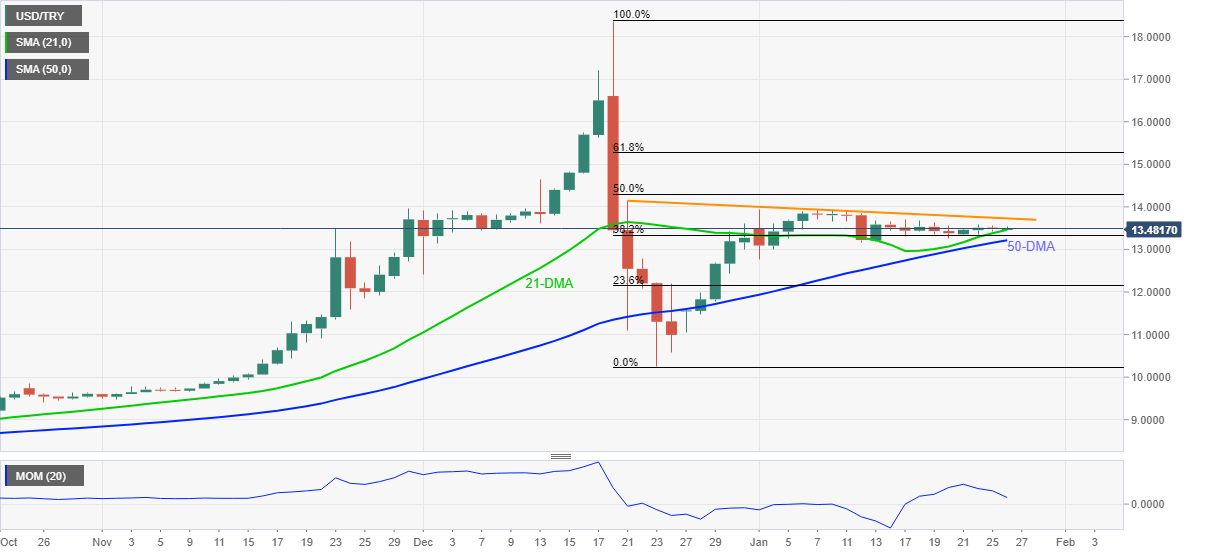
Trend: Sideways
Reuters reports Moodys' forecast that suggests the economic recovery will stabilize in Apac, despite risks from the pandemic and secular trends.
Key notes
Economic recovery will stabilize in Apac, despite risks from the pandemic and secular trends gradual recovery in Apac reflects the reopening of economies on increasing vaccination rates, continued fiscal, monetary support.
Growth disparities in Apac will remain as the pandemic, geopolitical tensions, supply chain issues and climate considerations exacerbate differences.
Market implications
Meanwhile, the focus remains on Central Asis and tensions between Russia and Ukraine as well as the Federal Reserve, both of which are weighing on global equity prices.
Asian stock markets largely retreated on Tuesday and are no better off on Wednesday, bleeding red across the board ahead of the Fed.
Fed fund futures now imply a nearly 85% chance of a 25 basis points increase in the fed funds rate in March, compared with about 54% a month ago, according to the CME Group's Fed Watch tool.
- USD/JPY remains on the back foot around intraday low, extends previous day’s losses.
- US T-bond yields struggle to overcome five-day downtrend amid pre-Fed anxiety, as well as geopolitical and growth fears.
- BOJ Summary of Opinions highlights Omicron fears over Japan’s economy.
- Second-tier data from Japan, the US may entertain traders ahead of the Fed’s verdict.
USD/JPY holds lower ground near the intraday low of 113.79 as Tokyo opens for Wednesday.
The risk barometer pair drops for the second consecutive day amid the market’s anxiety ahead of the US Federal Reserve (Fed) meeting joins geopolitical risks emanating from Russia and Omicron woes in Japan, not to forget downbeat economic forecasts by the International Monetary Fund (IMF).
As per the latest Bank of Japan (BOJ) Summary of Opinions, “Uncertainty over Japan's economic outlook heightening due to increase in omicron coronavirus cases.” The policy document conveying the January meeting talks also states, “BOJ must take additional easing steps as needed, appropriate to maintain current forward guidance on interest rates, monetary base commitment.”
It should be noted that the South African covid variant has been troubling Japan the most of late. “Japan on Tuesday expanded a COVID-19 quasi-state of emergency to 34 of the nation's 47 prefectures with the addition of 18 more areas, as the country continues to battle record coronavirus infections amid the rapid spread of the Omicron variant,” said Kyodo News.
The virus also pushed policymakers at the IMF to downgrade global growth forecasts as No.2 official Gita Gopinath said, “We project global growth this year at 4.4%, 0.5 percentage point lower than previously forecast, mainly because of downgrades for the United States and China,” per Reuters.
Elsewhere, the US, the UK and European Union (EU) are determined to levy economic sanctions on Russia if it invades Ukraine, which in turn keeps geopolitical fears on the table. However, the latest updates suggest receding fears of an imminent war between Moscow and Kyiv.
Furthermore, the recent passage of the America COMPETES Act offers extra support to the gold prices amid fears of escalating US-China tussles.
Moving on, the Fed’s action will be crucial for the USD/JPY prices while sentiment numbers from Japan and housing data from the US, as well the trade figures, could offer intermediate moves.
On Tuesday, the Fed hawks ignored softer US CB Consumer Confidence and Richmond Fed Manufacturing Index figures on firmer US inflation expectations, per the 10-year, breakeven inflation rate per the St. Louis Federal Reserve (FRED) data, which in turn favored gold buyers. The inflation gauge rose for the third consecutive day at the latest after declining to the lowest since September on January 20.
Read: Federal Reserve Interest Rate Decision Preview: Inflation, Omicron and equities
Technical analysis
A three-week-old descending triangle bullish chart pattern restricts short-term USD/JPY moves between 114.30 and 113.45. However, bearish MACD signals and downward sloping RSI line, not oversold, keep sellers hopeful.
- USD/CAD bears are taking control with eyes on the Fibonacci retracement levels.
- The W-formation's neckline is located near a 61.8% Fibo.
USD/CAD bears stayed in charge despite yesterday's prospects of an upside continuation from hourly support. Instead, the bears have cracked this important area and the price is now offering a discount on a restest of what would be expected now act as resistance.
USD/CAD daily charts

The double bottom lows have resulted in the bullish impulse of late which ran into old support that acted as resistance. Now, the price is en route to significant Fibonacci retracement levels where a deep correction to the W-formation's neckline near 1.2550 would be expected to hold initial tests. In doing so, the price could build up a pile of demand and result in an upside continuation.
On the other hand ...

The double bottom lows, however, will be exposed again should the W-formation's neckline give out. The lower time frames have formed a bearish structure as follows:
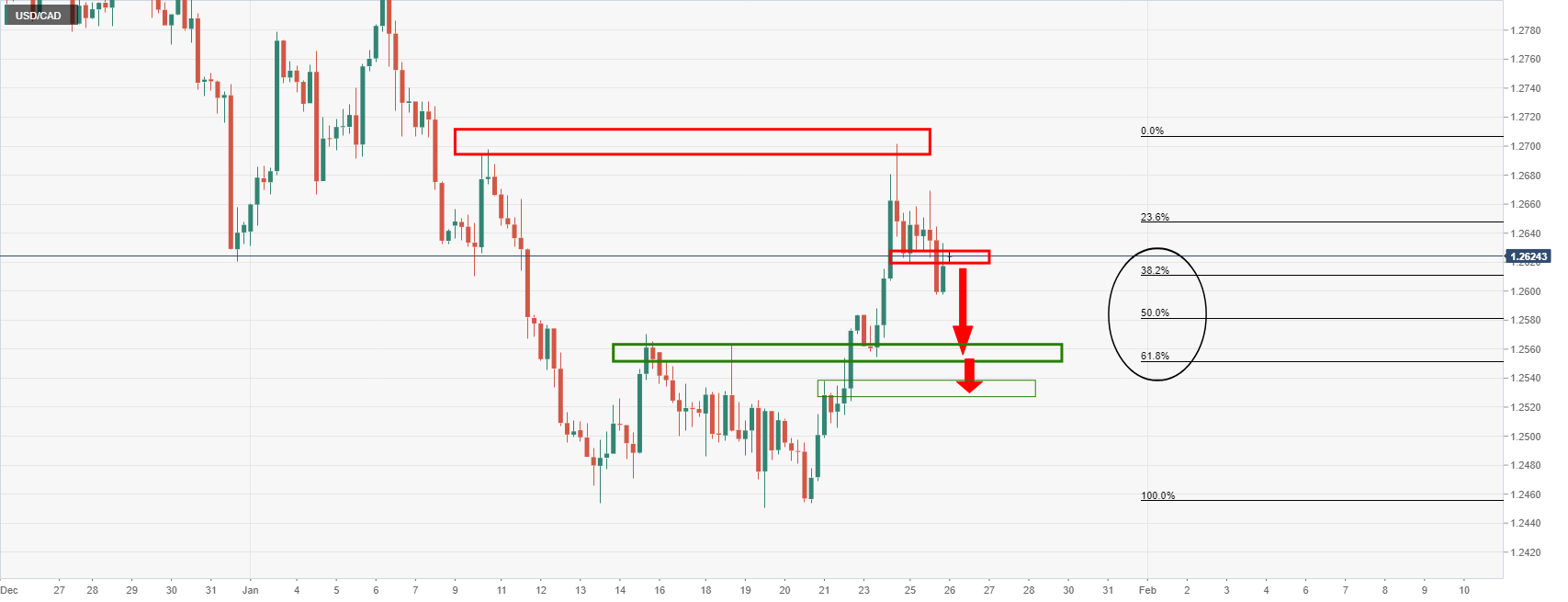
The 4-hour chart's liquidity grab has resulted in the bears taking control. The M-information's neckline has been tested and is acting as resistance. This could be regarded as a discount to the bears engaging here with a focus on the daily Fibos and the W-formation's neckline.
- Gold prices remain mildly bid after piercing yearly resistance, 13-day-old rising channel eyed.
- Downbeat yields, fears of Fed rate hike join Ukraine-Russia tussles to underpin gold’s safe-haven demand.
- IMF’s downbeat economic growth forecasts also sour the mood.
- Fed January Preview: Three possible scenarios for gold
Gold (XAU/USD) struggles to extend early gains around $1,850 as markets brace for the key Fed verdict during Wednesday’s Asian session.
The yellow metal rose during the last two consecutive days, also crossed the key hurdle to the north the previous day, as traders rushed to traditional risk-safety amid the market’s anxiety over the US Federal Reserve’s (Fed) next step. Adding to the bullish impulse could be geopolitical tensions and downbeat economic forecasts by the International Monetary Fund (IMF).
The Fed hawks ignored softer US CB Consumer Confidence and Richmond Fed Manufacturing Index figures on firmer US inflation expectations, per the 10-year, breakeven inflation rate per the St. Louis Federal Reserve (FRED) data, which in turn favored gold buyers. The inflation gauge rose for the third consecutive day on Tuesday after declining to the lowest since September on January 20.
Elsewhere, the US, the UK and European Union (EU) are determined to levy economic sanctions on Russia if it invades Ukraine, which in turn keeps geopolitical fears on the table.
Furthermore, the IMF No. 2 official Gita Gopinath conveyed downbeat economic forecasts the previous day as Omicron spreads. “We project global growth this year at 4.4%, 0.5 percentage point lower than previously forecast, mainly because of downgrades for the United States and China,” said IMF’s Gopinath per Reuters.
Additionally, the recent passage of the America COMPETES Act offers extra support to the gold prices amid fears of escalating US-China tussles.
While portraying the mood, the US Treasury yields remain on the back foot while the S& 500 Futures print mild gains at the latest. That said, Wall Street printed losses and the US Dollar Index (DXY) rose the previous day.
Moving on, gold buyers keep their eyes on the Fed’s verdict amid increasing hopes of witnessing March rate hike clues. It should, however, be noted that the recent doubts over the monetary policy tightening amid Omicron spread may push Powell to sound cautiously optimistic, which in turn could propel the gold’s upside, by taking the USD.
Technical analysis
A daily closing beyond a one-year-old resistance, now support around $1,846, keeps gold buyers hopeful of further advances towards the November 2021 peak of $1,877.
The bullish bias also takes clues from the upbeat RSI line, not overbought, as well as the metal’s rejection to ‘Death Cross”, a moving average bearish crossover.
Gold: Daily chart
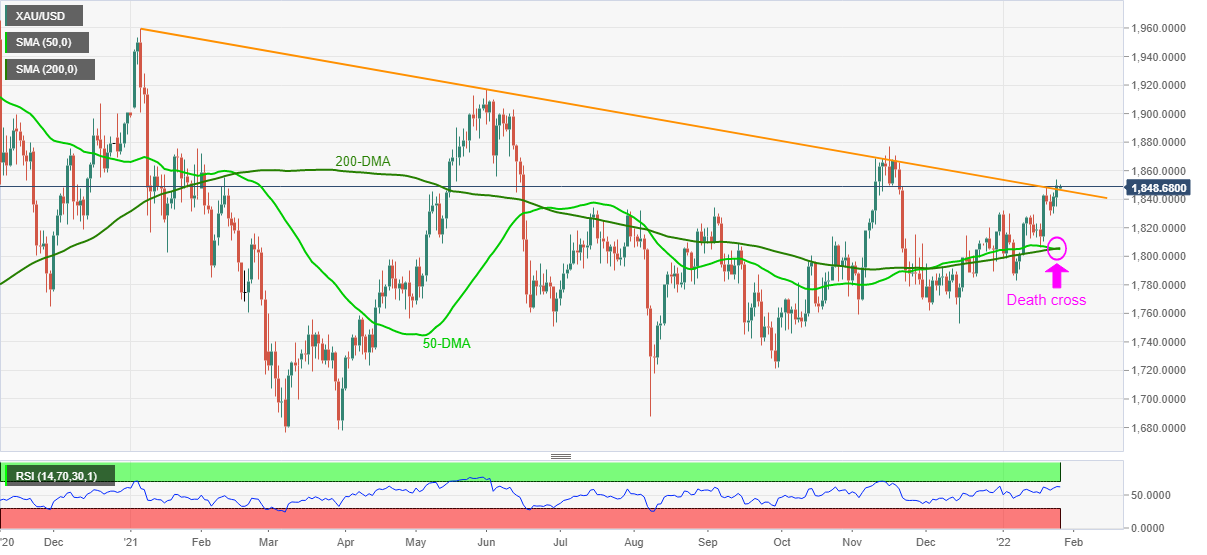
Details on the short-term chart, however, need validation from an upper line of a two-week-old rising channel, near $1,856, to offer a warm welcome to gold buyers.
It’s worth noting that gold’s pullback moves remain less worrisome until staying beyond the 100-SMA level of $1,819.
That said, the previous resistance line from late November and 50-SMA level, respectively around $1,843 and $1,830, may act as immediate support ahead of highlighting the stated channel’s lower line near $1,823.
Gold: Four-hour chart

Overall, Gold prices have already crossed the key hurdle to the north but need to convince bulls.
| Pare | Closed | Change, % |
|---|---|---|
| AUDUSD | 0.71519 | 0.19 |
| EURJPY | 128.679 | -0.3 |
| EURUSD | 1.13026 | -0.18 |
| GBPJPY | 153.751 | 0.06 |
| GBPUSD | 1.35044 | 0.12 |
| NZDUSD | 0.6685 | -0.15 |
| USDCAD | 1.2628 | -0.04 |
| USDCHF | 0.91793 | 0.47 |
| USDJPY | 113.85 | -0.06 |
© 2000-2024. All rights reserved.
This site is managed by Teletrade D.J. LLC 2351 LLC 2022 (Euro House, Richmond Hill Road, Kingstown, VC0100, St. Vincent and the Grenadines).
The information on this website is for informational purposes only and does not constitute any investment advice.
The company does not serve or provide services to customers who are residents of the US, Canada, Iran, The Democratic People's Republic of Korea, Yemen and FATF blacklisted countries.
Making transactions on financial markets with marginal financial instruments opens up wide possibilities and allows investors who are willing to take risks to earn high profits, carrying a potentially high risk of losses at the same time. Therefore you should responsibly approach the issue of choosing the appropriate investment strategy, taking the available resources into account, before starting trading.
Use of the information: full or partial use of materials from this website must always be referenced to TeleTrade as the source of information. Use of the materials on the Internet must be accompanied by a hyperlink to teletrade.org. Automatic import of materials and information from this website is prohibited.
Please contact our PR department if you have any questions or need assistance at pr@teletrade.global.
















